American Battlefield Trust applauds

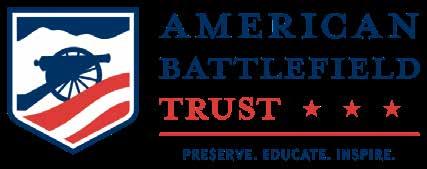
Governor’s request to create a historic and recreational park in the heart of Virginia’s Piedmont region.
RICHMOND, Va.—The American Battlefield Trust applauds Virginia Governor Glenn Youngkin’s announcement on Friday, requesting $4.93 million for land acquisition to create a Culpeper Battlefields State Park. The announcement was part of a package of legislative initiatives and budget amendments submitted by the Governor to the General Assembly on January 21, 2022.
“Friday’s announcement marks an important step in the effort to create a Culpeper Battlefields State Park,” noted Trust President David Duncan. “Culpeper’s battlefields are among the most pristine and historic in the nation.
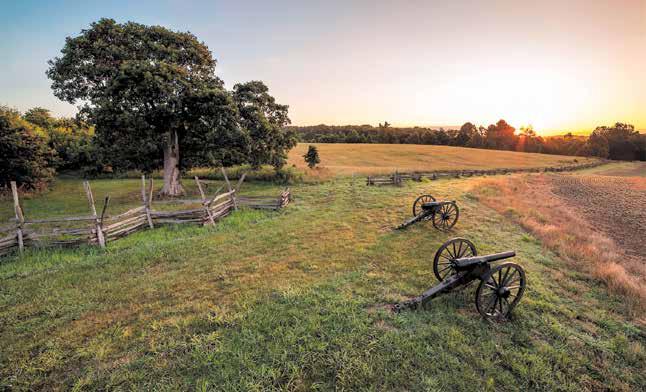
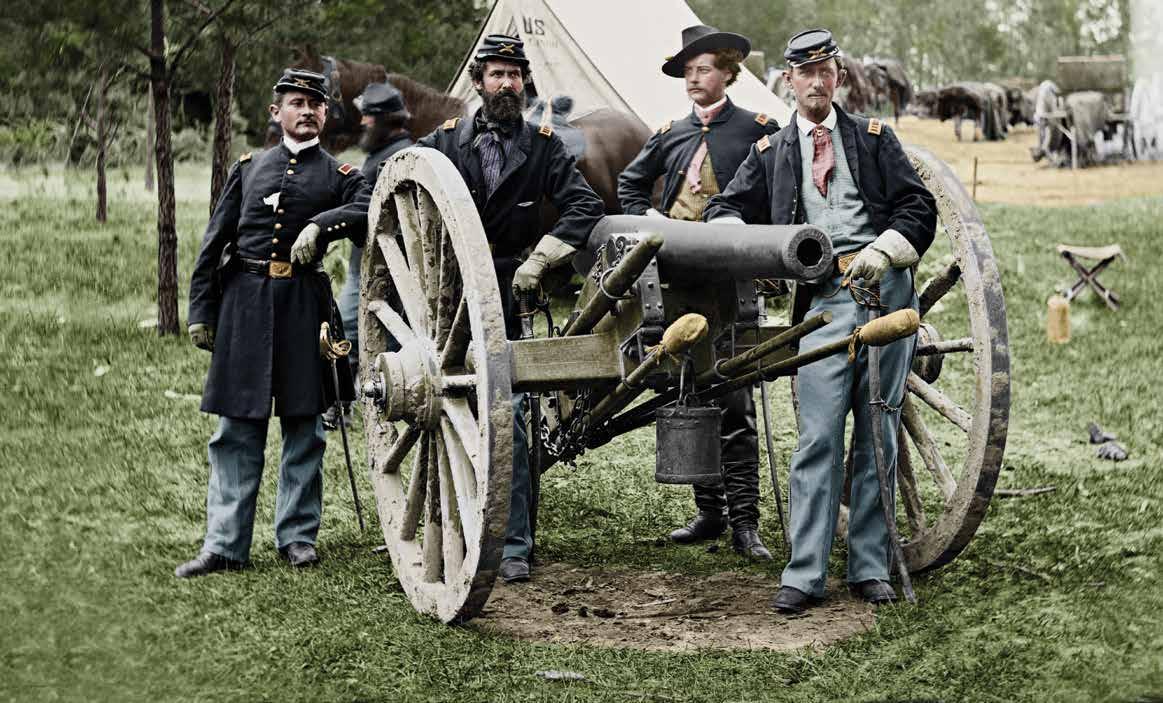
Virginia Governor Youngkin Calls for Creation of Culpeper Battlefields
State Park
Transforming this landscape into a state park will produce a heritage tourism destination in the heart of Virginia’s Piedmont, with educational, recreational, and economic opportunities that will benefit visitors and local residents alike.”
The Culpeper Battlefields State Park initiative is a proposal to create a state park from a critical mass of more than 1,700-acres of preserved lands on the Brandy Station and Cedar Mountain Battlefields. While this landscape’s overarching national significance is associated with famous Civil War battles and events, the region is rich in history and culture. The pristine countryside visible today retains the imprint of its first native people and the generations that followed.
State Senator Bryce Reeves, long a champion of a state park in Culpeper County, urged the Governor to make a Culpeper Battlefields State Park a priority for the new administration.
He worked tirelessly with the Governor’s team to craft the budget amendment submitted to the General Assembly on Friday. According to Reeves, “Culpeper is the ideal location for Virginia’s
next state park. I look forward to the day when Virginians and visitors from throughout the country can learn about our nation’s history by visiting these hallowed grounds.”
Joining Senator Reeves in support of a Culpeper Battlefields State Park is a long-standing and bipartisan coalition of state legislators, national and local preservation organizations, and Culpeper government officials. In 2016, the Culpeper County Board of Supervisors and the Culpeper Town Council both passed resolutions endorsing a state battlefield park in Culpeper County.
As submitted, the Governor’s budget amendment sets aside $4.93 million in FY2023 for the state park. The amendment indicates the funding “[p]rovides for the purchase of land to create a new state park in Culpeper County that will have multiple recreational and educational opportunities.”
Nestled in the Virginia
Piedmont, Culpeper County is widely recognized for its scenic character, natural beauty, and abundant history. Its pristine rivers, rolling landscape, recreational opportunities, and unparalleled historic resources make it a desirable location for a state park. Its location between the Rappahannock and Rapidan Rivers made it an area of strategic importance during the Civil War, and thousands of enslaved peoples crossed its rivers, heading northward to Freedom; some returned as free men to fight for their country on this very soil.
The American Battlefield Trust is dedicated to preserving America’s hallowed battlegrounds and educating the public about what happened there and why it matters today. The nonprofit, nonpartisan organization has protected more than 54,000 acres associated with the Revolutionary War, War of 1812 and Civil War. Learn more at www.battlefields.org.
Vol. 48, No. 3 48 Pages, March 2022 $3.50 America’s Monthly Newspaper For Civil War Enthusiasts 12 – American Battlefield Trust 40 – Book Reviews 35 – Central Virginia Battlefield Trust 26 – Critic’s Corner 32 – Emerging Civil War 45 – Events 30 – The Graphic War 22 – The Source 14 – Through the Lens 16 – This And That 7 – Trivia 10 – The Unfinished Fight
Cedar Mountain Battlefield. (Buddy Secor)
Brandy Station, Va. Army of the Potomac. Eastern half of the camp. (Library of Congress)
Civil War News
Published by Historical Publications LLC
520 Folly Road, Suite 25 PMB 379, Charleston, SC 29412 800-777-1862 • Facebook.com/CivilWarNews mail@civilwarnews.com • civilwarnews.com
Advertising: 800-777-1862 • ads@civilwarnews.com

Jack W. Melton Jr. C. Peter & Kathryn Jorgensen
Publisher Founding Publishers
Editor: Lawrence E. Babits, Ph.D.
Advertising, Marketing & Assistant Editor: Peggy Melton
Columnists: Craig Barry, Salvatore Cilella, Stephanie Hagiwara, Gould Hagler, Tim Prince, John Sexton, and Michael K. Shaffer
Editorial & Photography Staff: Greg Biggs, Michael Kent, Bob Ruegsegger, Gregory L. Wade, Shannon Pritchard, Carl Sell Jr., Joan Wenner, J.D.
Technical Consultant: Heath Jones


Civil War News (ISSN: 1053-1181) Copyright © 2021 by Historical Publications LLC is published 12 times per year by Historical Publications LLC, 520 Folly Road, Suite 25 PMB 379, Charleston, SC 29412. Monthly. Business and Editorial Offices: 520 Folly Road, Suite 25 PMB 379, Charleston, SC 29412, Accounting and Circulation

Offices: Historical Publications LLC, 520 Folly Road, Suite 25 PMB 379, Charleston, SC 29412. Call 800-777-1862 to subscribe.
Periodicals postage paid at U.S.P.S. 131 W. High St., Jefferson City, MO 65101.
POSTMASTER: Send address changes to: Historical Publications LLC 520 Folly Road Suite 25 PMB 379 Charleston, SC 29412
Display advertising rates and media kit on request. The Civil War News is for your reading enjoyment. The views and opinions expressed herein are those of its authors, readers and advertisers and they do not necessarily reflect the official policy or position of Historical Publications, LLC, its owners and/or employees.
P UBLISHERS :
Please send your book(s) for review to: Civil War News

520 Folly Road, Suite 25 PMB 379 Charleston, SC 29412
Email cover image to bookreviews@civilwarnews.com. Civil War News cannot assure that unsolicited books will be assigned for review. Email bookreviews@civilwarnews. com for eligibility before mailing.
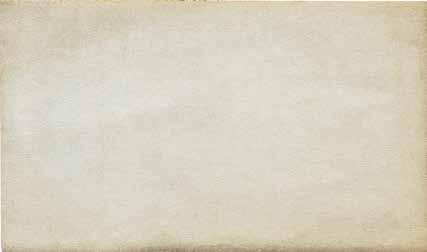
ADVERTISING INFO:
Email us at ads@civilwarnews.com Call 800-777-1862

MOVING?
Contact us to change your address so you don’t miss a single issue. mail@civilwarnews.com • 800-777-1862
SUBSCRIPTION RATES
U.S. Subscription
Major Announcement
Peggy and I are so delighted to announce our new and improved website. We have been recently working hard to populate it with exciting information for our subscribers. CivilWarNews.com has always been available, but it has never been filled with so much news and information until now.
There are so many new features; it is hard to count them. As a print subscriber, you will now be able to log in to manage your subscriptions, complete a change of address, renew your subscription online, or suspend your subscription while on vacation and have it reinstated when you return. You can access our expanded Calendar of Events, sign up for an e-Edition subscription, watch interesting videos, get News Alerts, Special Offers, Weekly Best of trending stories from the week. You will have unlimited access to our Book Reviews, Preservation News, and Press Releases, and so much more. You will also have access to articles from our other publications, The Artilleryman Magazine and the upcoming Military Antique Collector Magazine. Best of all, there is no additional charge to access this new site (with exception to e-edition subscriptions)
If you are a current subscriber with your email on file with us and want to sign up, go to CivilWarNews.com., which will redirect you to our main website: HistoricalPublicationsLLC.com.
To Renew your Subscription
Go to Sign Up (top left) and it takes you to the Account Registration page and type in your username (First and
Letters to the Editor:
Please email: mail@civilwarnews.com
By Jack Melton
Last Name), type in your email address, and create a password. Create a screen name by using your First and Last name only, enter your password, click remember me, then click Create Account. The new website is still a work in progress, and we are participating in weekly Zoom training classes to bring our readers everything the new site has to offer. Over the next year there will be over 500 articles on this new site! We ask for your patience if you encounter any glitches during the transition. If you are a subscriber and would like to have full access but don’t have an email on file with us, please call us at 800-777-1862, and we will help you initiate the process.
Advertisers Note: If you place a print ad in CWN monthly edition, currently, we will automatically place your ad on the website as a free display ad for as long as your paid ad copy is advertised in the printed edition.

We are re-establishing the very much missed and highly requested Classified Ad section, where you can create your own classified ad for just $25 per month (online only).
We hope all of you will take advantage of this new website and all it has to offer. As always, we invite your suggestions to help improve your viewing experience at CivilWarNews.com.
Announcement
Mails the end of February! A brand new bi-monthly full-color 80-page, glossy magazine for the Military Antique Collector. The publication will spotlight rare and unusual military objects, beautiful craftsmanship works, and historical figures dating from early American and European history to limited coverage of the post-1898 artifact. This magazine will not be focused on relic hunting or artifact digging. To subscribe see the ad on page 43.
2 CivilWarNews.com March 2022 2 March 2022 CivilWarNews.com
rates are $41/year, $71/2 years, digital only $29.95/year, add digital to paper subscription for only $10/year more. Subscribe securely at CivilWarNews.com CIVIL WAR AUTOGRAPHS LETTERS • DIARIES • STAMPS • CURRENCY Price List Online • Top Price Paid for Quality Material B. M. GREEN P.O. Box 1816N Kernersville, NC 27285-1816 (336)993-5100 • (336)993-1801 www.shop.bmgcivilwar.net bmgcivilwar@triad.rr.com
Cliff
CSArms.com 9150 John S. Mosby Hwy. (Rt. 50) Upperville, Va 20185 for US Mail: PO BOX 602 (540) 592-7273 • SophiaCSArms@aol.com Collector’s Arms 1700-1945 Militaria Specializing in Civil War-World War II
Sophia | Proprietor
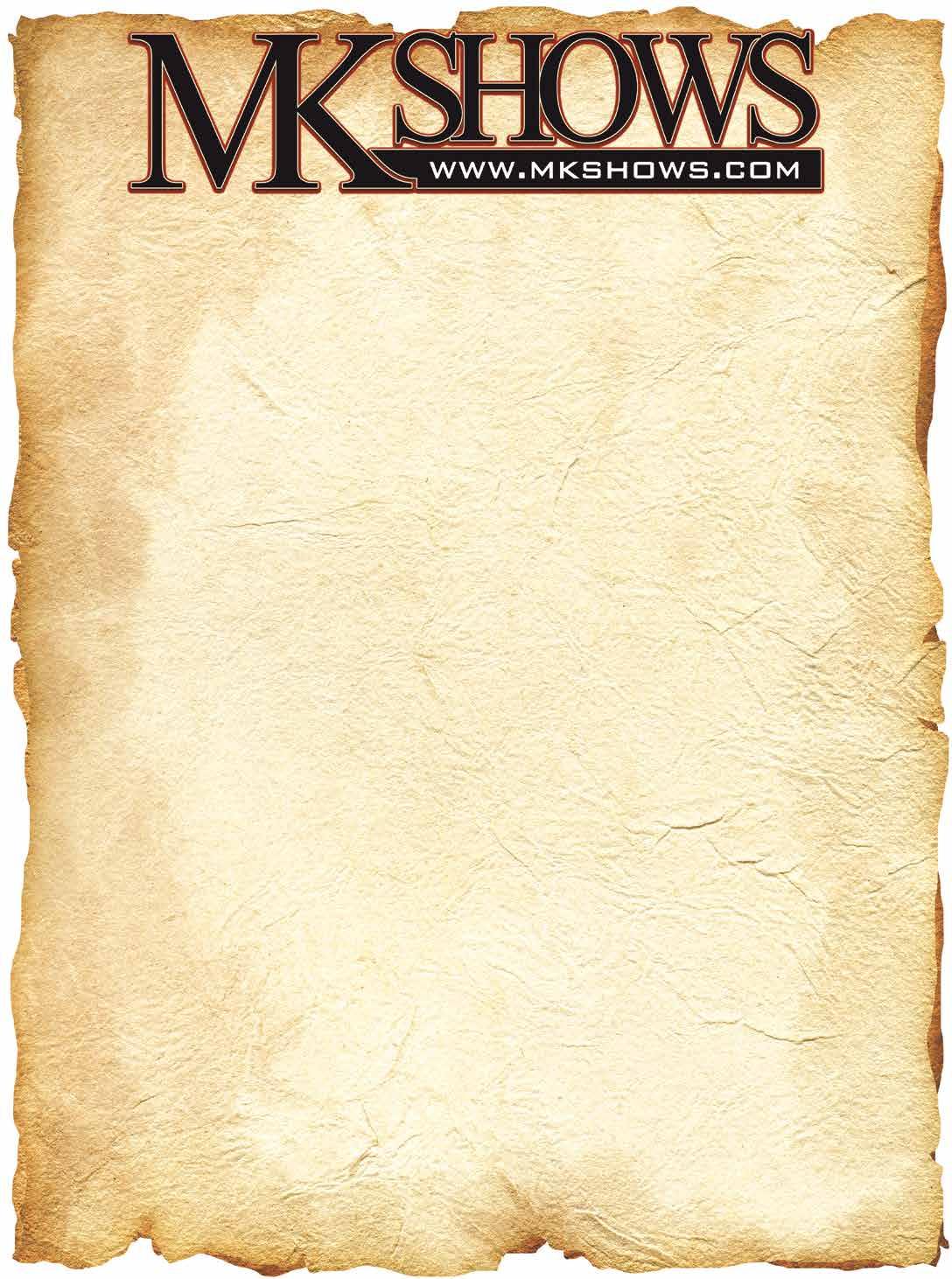
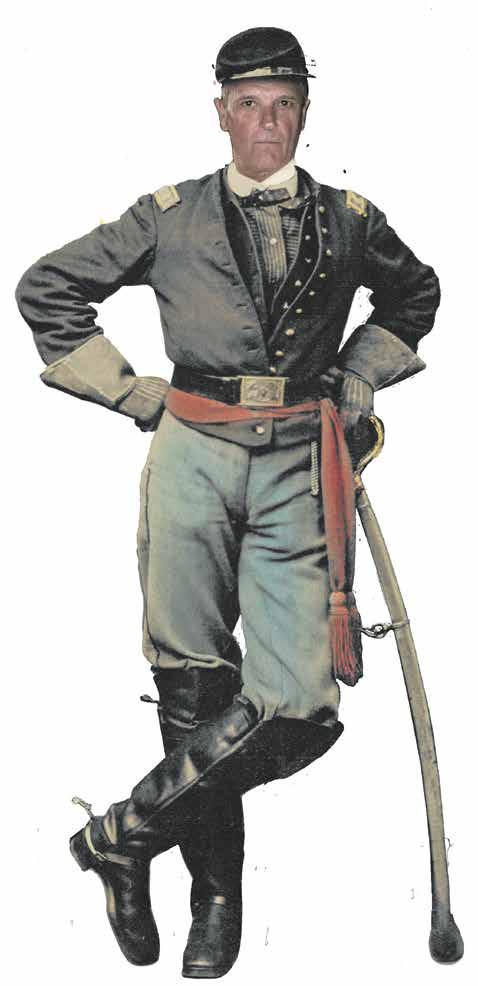




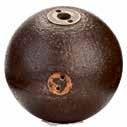



Mike Kent & Associates, LLC • PO Box 685 • Monroe, GA 30655 770-630-7296 • Mike@MKShows.com • www.MKShows.com Military Collectible & Gun & Knife Shows Presents The Finest Williamson County Ag Expo Park 4215 Long Lane Franklin, TN 37064 Dec. 3 & 4, 2022 Middle TN (Franklin) Civil War Show South Carolina State Fairgrounds 1200 Rosewood Drive Columbia, SC 29202 March 19 & 20, 2022 Columbia Gun & Knife Show Promoters of Quality Shows for Shooters, Collectors, Civil War and Militaria Enthusiasts WNC Ag Center 1301 Fanning Bridge Road Fletcher, NC July 8 & 9, 2022 Asheville Gun & Knife Show WNC Ag Center 1301 Fanning Bridge Road Fletcher, NC May 7 & 8, 2022 Asheville Gun & Knife Show WNC Ag Center 1301 Fanning Bridge Road Fletcher, NC March 5 & 6, 2022 Asheville Gun & Knife Show
The 27th Annual Chickamauga Civil War Show and Sale

DALTON, Ga.—The show held January 29th and 30th at the Dalton Convention Center kicked off the 2022 season for Mike Kent and MK Shows amid great expectations for a good year. The Dalton Show was originally founded by Robert Overstreet in 1995 as a 200-table event utilizing half the Convention Center's 45,000 square foot exhibit hall. In 2002 Mike Kent assumed ownership and, over the years, has parlayed the show into one of the largest Civil War shows in the country at 500 tables.


The Dalton Show is without a doubt one of the most popular events on the Civil War calendar each year and for good reason.
The venue is big and bright with easy, level access through wide lobby doors and multiple roll up doors. Parking is plentiful and free. The facility is conveniently located just off I-75 at Exit 333 and visible from the interstate. To top things off, there are multiple hotels and restaurants within a mile of the show’s location.
The Dalton show was one of the few Civil War events to not miss a beat during the pandemic of the past two years. The 2020 show was held just prior to the nationwide shutdowns that began in March and by the time the 2021 show rolled around venues were beginning to open back up, although with some restrictions.
With Covid-19 still a factor in some people's minds, all 500 tables were still filled at show time despite some last-minute cancellations; traffic was on a par with last year's event. The mask policy was no longer in effect this year, but masks were provided to those who chose to wear one. Common areas were sanitized periodically, hand sanitizers were available everywhere, and concessions were served in individual boxes instead of buffet style. Overall, everyone questioned felt comfortable with the arrangements made to keep both vendors and attendees safe. Although ice and snow are always a threat in the Dalton area,
neither affected this year's event, even though the temperature stood at a cool 20 degrees when the doors opened at 9 a.m. Saturday morning. Foot traffic started out slowly but soon picked up as the sun came out and temperatures rose into the mid 30's. The cold did not affect dealer participation as the regulars from Texas, New York, New Jersey, Pennsylvania, and many other states all made their annual pilgrimage to Dalton.
The Dalton Lecture Series has become a popular tradition for the show with state of the art break out rooms easily accessible from the show floor featuring audio visual equipment perfect for seminars and presentations. For the past few years Greg Biggs has been instrumental in organizing the series as well as presenting a lecture. This year Biggs performed his magic again with the following entertaining and informative speakers.
Gene Andrews’ topic was "Forrest's Strategy: If They Had Only Listened." Gene detailed numerous well-known battles where Forrest recommended actions to his superiors, only to be ignored to the detriment of the campaign. It was obvious after Gene's detailed analysis and explanations that things could certainly have turned out differently had Forrest's suggestions been taken. Andrews’ background includes a lifelong interest in Confederate history, particularly Nathan Bedford Forrest, culminating with his current volunteer occupation as caretaker of the Forrest boyhood home near Chapel Hill, Tenn. Along the way, Andrews served as a USMC Lieutenant in Viet Nam, played minor league football for the Cincinnati Bengals, coached for 14 years, and worked for a company providing medical services to NASCAR, Indy car drivers, and crew members.
Next up was Brad Butkovich who spoke on his new book
The Battle of Pickett's Mill; Along the Deadline. Butkovich's presentation was well organized with numerous visuals showing troop placement and movements as well as detailing what happened in the days immediately following the fighting in the Pickett's Mill area. Brad Butkovich has a BA in History from Georgia Southern University and is a member of the American Battlefield Trust. In addition to publishing several books, Butkovich has recently finalized the website: CivilWarVirtualTours.com which provides detailed views of Civil War battlefields and engagements.
Taking the 1 p.m. slot was Col. Ed Lowe (Ret.) whose topic was "James Longstreet in East Tennessee and the Problem of Confederate and Union Logistics" which was given using an excellent and informative slide presentation. Col. Lowe served on active duty with the U.S. Army including deployments to Operation Desert Shield/Storm, Haiti, Afghanistan, and Iraq. He currently serves as an adjunct professor at the University of Maryland and Elizabethtown College, is working on two books for Savas Beatie, and is President of the Chickamauga and Chattanooga Civil War Round Table.
Greg Biggs finished up the Saturday lectures with, “Red Clay Banners: The Confederate Battle Flags of the Atlanta Campaign." Biggs is well known in the Civil War community and a recognized expert on military colors of the 18th and 19th centuries. He has spoken to numerous Civil War Roundtables and SCV camps around the country, led battlefield tours, and is the Staff Ride Facilitator for Fort Donelson National Battlefield. Biggs has also been published in many Civil War publications and has consulted for museums, auction houses, and relic dealers
4 CivilWarNews.com March 2022 4 March 2022 CivilWarNews.com
Uniforms are always popular at the show, especially in this condition! Russ Hayes collection.
Tim Prince of College Hill Arsenal and Antiques Roadshow fame is a familiar face at Dalton.
Ed Birnbaum consistently has some of the most unique and interesting weapons in the show.
nationwide.
Displays are a big hit at most shows and Dalton is no different. Some exhibitors work for months to accumulate the correct items for their presentations and most of them are a work in progress, as it seems like there is always another piece of the puzzle to add to make a display more complete. Two displays stood out this year and deserve extra credit for what they added to the show.
Robert Bushnell was a new displayer at Dalton this year with a crowd pleaser titled “The Lost Insignia of the Texas Marine Corps.” His exhibit consisted of numerous framed artifacts discovered after Hurricane Edith hit Galveston, Texas, in 1971 and shed new light on the murky origins of the Texas Navy and Marine Corps. The display featured collar insignias, shoulder and belt plates, badges, hat insignia, as well as various Navy and Marine emblems, many of which were identified to a specific ship. An added attraction was a short book by Bobby J. McKinney tracing the history of the Texas Navy complete with photos of all the artifacts displayed.

Ken Hamilton has been a longtime dealer at the Dalton show but has never had a display until this year; what a display it was!
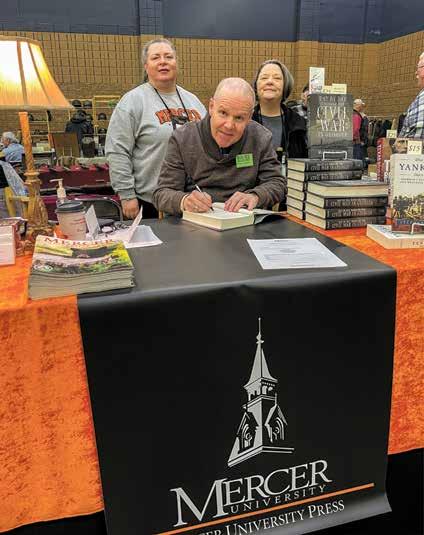

His exhibit titled “Battlefield Pickups of the Little Big Horn” featured a Burnside carbine, a Spencer carbine, a Whitney .36 caliber revolver, a holster, and a Sioux/Cheyenne arrow recovered on June 27, 1876, from the Little Big Horn battlefield by Medal of Honor winner Sgt. Henry Mechlin of Co. H, 7th Cavalry. These items were purchased from Mechlin's daughter and have been in private hands since their purchase, with documentation dating back to their original acquisition in 1908.
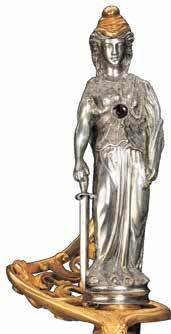
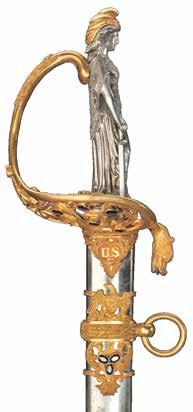

The next Dalton Civil War show is scheduled for January 28-29, 2023. You can check out all upcoming MK Shows at MKShows.com.



5
2022 5
2022 CivilWarNews.com CivilWarNews.com Buying and Selling The Finest in Americana 11311 S. Indian River Dr. • Fort Pierce, Florida 34982 770-329-4985 • gwjuno@aol.com George Weller Juno
March
March
– MAKER –LEATHER WORKS (845) 339-4916 or email sales@dellsleatherworks.com WWW. DELLSLEATHERWORKS.COM
Andrew Bottomley, from Great Britain, collects treasures from around the world.
Visit our new website at CivilWarNews.com
Michael K. Shaffer autographs his new book, Day by Day through the Civil War in Georgia, published by Mercer University Press. Mercer’s Mary Beth Kosowski and Marsha Luttrell manned the table at the show.
Vann Martin has one of the best selections of veteran’s materials to be found anywhere.
It would not be a Civil War show without Lee Fry of Dixie Gun Works!



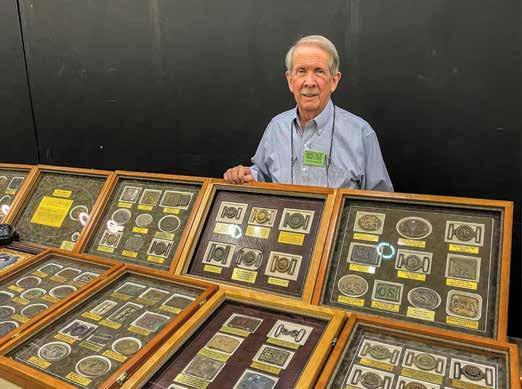
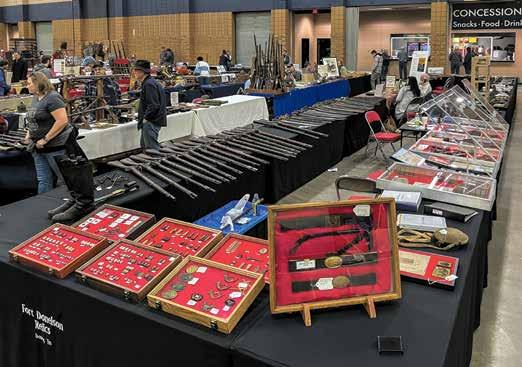

6 CivilWarNews.com March 2022 6 March 2022 CivilWarNews.com
John and Nikki Walsh of Fort Donelson Relics are regulars at all the shows and set up an impressive seven artifact tables.
Dr. Bill Blackman and his stunning collection of Confederate buckles.
Michael Mankin is the go-to source for all types of insignia.
Nick Apergis is smiling like he just made a big sale!
Tom Hayes, from Tennessee, always brings an assortment of dug and non-dug artifacts to the show.
7.



Answers




 By Lawrence E. Babits
By Lawrence E. Babits
7 March 2022 7 March 2022 CivilWarNews.com CivilWarNews.com THE FINEST HISTORICAL ANTIQUE MILITARIA Wallace Markert csacquisitions@gmail.com 16905 Nash Road • Dewitt, Virginia 23840 804-536-6413 www.csacquisitions.com
Copperhead leader
Jackson’s most famous campaign
Battle that slowed invasion of New Mexico
Official name for ironclad that fought the Monitor
Union Brigade commander killed on Little Round Top
Stannard led troops from this state as he attacked Pickett’s men July 3, 1863
Civil War Alphabet Quiz – V as in... March 1.
2.
3.
4.
5.
6.
Confederate stronghold that surrendered July 4, 1863
North Carolina Civil War governor
French term for cavalry outpost
Experimental, 121 barrel/cylinder cannon
8.
9.
10.
found on page 47.
Kent Schweikert is a new book dealer at Dalton but plans to be back next year.
Visit our new website at CivilWarNews.com
This is Todd Klingenberg’s second Dalton show, but he looks like an old pro!
You can’t miss Rafael Eledge of Shiloh Relics with his yellow table covers!

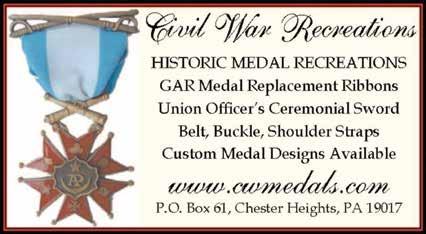
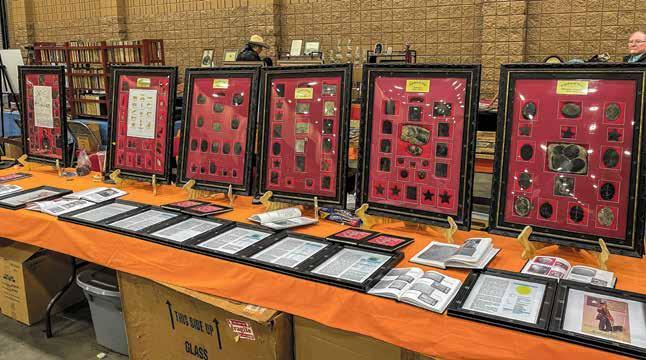


8 CivilWarNews.com March 2022 8 March 2022 CivilWarNews.com Want to Advertise in Civil War News? call 800-777-1862 or email us ads@civilwarnews.com Subscribe online at CivilWarNews.com Letters to the Editor: Please email: mail@civilwarnews.com
Relics of the Republic of Texas Navy were a hit at Robert Bushnell’s table.
Nick Periut’s tables contained everything from a rare warlog to artillery projectiles, antique firearms, and other hard to find excavated artifacts.
Kerry Elliott and son John Ryan never miss a Dalton show. Kerry’s display, “Numbered Guns: Arms furnished to the Confederacy by Great Britain” featured an engraved gun with number “3.”
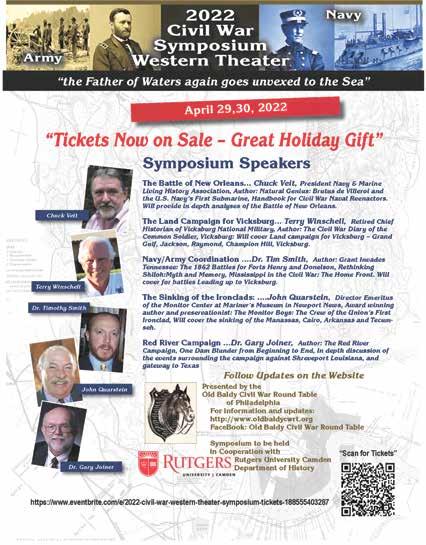
















9 March 2022 9 March 2022 CivilWarNews.com CivilWarNews.com Publishers: Send your book(s) for review to: Civil War News 520 Folly Road, Suite 25 PMB 379 Charleston, SC 29412 “Beyond the Mere Routine of Everyday Life” Encounters & Experiences during the Civil War McCormick Civil War Institute 2022 Spring Conference Saturday April 2, 2022 9 a.m. – 4 p.m. To register: su.edu/MCWI Registration fee: $30 includes all sessions & lunch Featuring Presentations by: Jonathan A. Noyalas (Shenandoah University) Lauren K. Thompson (McKendree University) Kathryn J. Shively (Virginia Commonwealth University) Jonathan W. White (Christopher Newport University) Additional Questions: Contact MCWI's director Jonathan Noyalas, jnoyalas01@su.edu or 540-665-4501 Greg Ton • P.O. Box 9 • Franklin, TN 37065 901-487-5944 • GTon1@aol.com Greg Ton Buying and Selling the Finest Confederate, Obsolete and Southern States Currency Since 1978 GregTonCurrency.com Deadlines for Advertising or Editorial Submissions is the 20th of each month. Email to: ads@civilwarnews.com
Robbins & Lawrence Windsor, Vermont
U.S. Model 1841 rifles were produced by the Harpers Ferry Armory, but also let on contact with private contractors Eli Whitney, Remington, and Robbins & Lawrence. Samuel Robbins and Richard Lawrence came to the gun trade much later than either Eli Whitney or Remington, and left much sooner. Located on the Connecticut River in an area known as “Precision
Valley” for the amount and quality of the machine tools produced there, Robbins and Lawrence entered into a partnership with Nicanor Kendall building rifles at the Windsor, Vt., prison in 1844 where they employed prisoners as low cost labor.

Probably realizing the risks and limitations involved with making and storing firearms in a prison, the partners built a large brick factory in 1846. Frederick Howe was then the factory superintendent. Howe, who would later be hired away by


Providence Tool, invented several new milling machines and lathes for making interchangeable gun parts by Robbins & Lawrence. Their first contract with the U.S. government was to make the U.S. M1841 rifle. The very first M1841s produced by the firm on contract were marked Robbins, Kendall & Lawrence. These have the earliest lock plate dates. After 1847 when Nicanor Kendall left, the firm changed names and the locks were simply marked Robbins & Lawrence over US, with the date and
(more or less) uniform in their basic configuration with a fixed rear sight, .54 caliber bore, and no provisions for any type of bayonet. However, alterations and upgrades are found in a wide variety, the number of which almost defies analysis. By the Civil War-era most M1841s had been sent to various state arsenals. There were two or three “Federal” conversions done at different arsenals or under commercial contract between 1855 and 1861 that had some degree of consistency. Large numbers were converted by the various states, or perhaps even militia units, which had the arms in their possession.
Alterations usually consisted of some provision to take a socket or sword bayonet; addition of adjustable sights; and the conversion from .54 to .58 caliber. Federal alterations began as early as 1855 when the .58 caliber “standard” was adopted. An order on July 4, 1855, directed that M1841 rifle bores were to be increased in caliber [to.58], fitted with sword bayonets, and long-
lug, but these required that the M1841 rifle stocks be cut back slightly and a shortened upper band fitted. Later, a third type of bayonet was produced under contract that required no alteration to the rifle, only the addition of a bayonet lug that clamped in place. The presumption might be that a comparable number of rifles were altered for bayonets in the context of enlarging the caliber, but that is not the case. The numbers do not jibe.
Including the 25,296 rifles produced by the Armory at Harpers Ferry, and various other small contractors up until 1855, there were roughly one hundred thousand M1841s on hand in various state arsenals at the onset of the Civil War. Secretary of War John Floyd directed the Ordnance department to move 115,000 small arms (including 13,000 M1841 rifles) to Southern arsenals. The Federal Ordnance department issued them to Union troops early in the war, but replaced most M1841 rifles with the newer M1861 rifle-muskets as they became available. However, these rifles were still seeing action with Confederate infantry years later. In the Confederacy, all existing stockpiles of M1841 rifles as well as the Confederate copies were in use. Confederate contractors continued to produce more as the war progressed, though they numbered in the hundreds, not thousands.
WINDSOR behind the hammer. The barrel flat on the Robbins & Lawrence M1841 was not marked STEEL, as were all the Remington and some of the Whitneyville variants. The government M1841 contracts totaled 25,000 M1841 rifles and all were delivered by 1855. The original M1841 rifles were all
range rear sights. About 1,646 “Snell” type bayonets produced at Harpers Ferry in 1855 used a rotating thumbscrew type lock requiring two small cuts on the side of the barrel to engage.
Between 1855 and 1857 Harpers Ferry produced 10,286 sword bayonets to be used with a more conventional side mounted
Confederate infantry units issued the M1841s include the 18th Georgia; 18th and 21st Mississippi; 1st and 7th Tennessee; 4th, 6th, 9th, and 23rd Virginia; and the 3rd, 8th and 15th South Carolina. In terms of battle engagements, the 9th Virginia carried their M1841s to the “high water mark of the Confederacy” in Pickett’s Charge at Gettysburg.

10 CivilWarNews.com March 2022 10 March 2022 CivilWarNews.com
The Robbins & Lawrence Armory, a National Historic Landmark, is located in Windsor, Vt. This photo taken in 1864. (Library of Congress)
Robbins & Lawrence Model 1841 Mississippi Rifle, Colt alteration. (Courtney Rock Island Auction Co.)
In the Western Theater, Confederate field inspection reports for May 1864 show that Maj. Gen. Nathan Bedford Forrest’s cavalry was armed with nearly 2,600 M1841 rifles, using them at Brice’s Crossroads and elsewhere. Some other Confederate cavalry regiments issued these rifles included: the 18th and 19th Mississippi; 8th, 11th, and 23rd Texas; and the 12th and 14th Virginia.

In addition to the M1841 rifle, Robbins & Lawrence also produced P53 Enfield long rifles (type II) for the British during the Crimean War. According to Tim Prince, “…in February 1855, the English Board of Ordnance contracted with the New York based firm of Fox, Henderson & Company to supply some twentyfive thousand Pattern 1853 Enfield Rifle Muskets. Fox, Henderson & Co. subsequently contracted with Robbins & Lawrence to produce the firearms. Assuming that the order for 25,000 guns was only the beginning of what would be additional large orders for the British military due to the Crimean conflict, Robbins & Lawrence invested substantial amounts of money expanding their production facilities in Windsor, Vt., and built a second factory in Hartford, Conn. They also invested heavily in new machinery and an expanded
workforce. All this was done with borrowed money, much of it from Fox, Henderson & Co., as well as other creditors.” When the deliveries were late, the British canceled the contact. The rapid expansion largely based on credit soon led to the financial ruin of the company.

Publisher Note: Model and Pattern are commonly shorted to M and P in front of the model or pattern year.
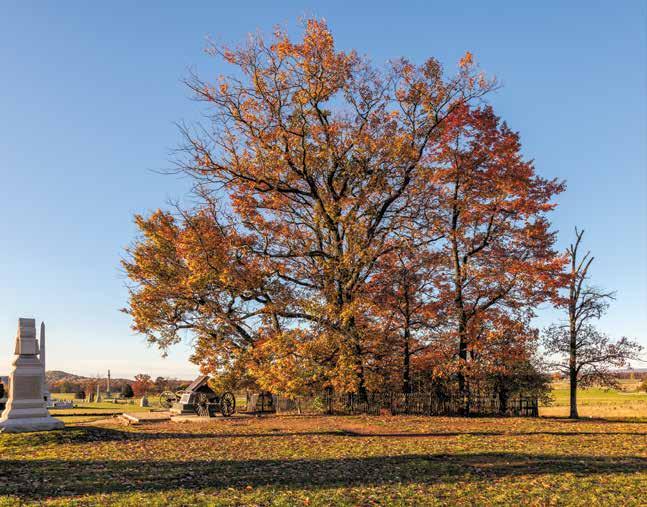
Craig L. Barry was born in Charlottesville, Va. He holds his BA and Masters degrees from UNC (Charlotte). Craig served The Watchdog Civil War Quarterly as Associate Editor and Editor from 2003–2017. The Watchdog published books and columns on 19th-century material and donated all funds from publications to battlefield preservation. He is the author of several books including The Civil War Musket: A Handbook for Historical Accuracy (2006, 2011), The Unfinished Fight: Essays on Confederate Material Culture Vol. I and II (2012, 2013). He has also published four books in the Suppliers to the Confederacy series on English Arms & Accoutrements, Quartermaster stores and other European imports.

11 March 2022 11 March 2022 CivilWarNews.com CivilWarNews.com Deadlines for Advertising or Editorial Submissions is the 20th of each month. Email to ads@civilwarnews.com 19th CENTURY LIVING HISTORY! James Country MERCANTILE 111 N. Main Liberty, MO 64068 816-781-9473 • FAX 816-781-1470 www.jamescountry.com Ladies – Gentlemen Civilian – Military • Books • Buttons • Fabrics • Music • Patterns • Weapons Mens, Ladies and Children’s • Civilian Clothing • Military Clothing • Military Accessories • Accoutrements Everything needed by the Living Historian! Our Clothing is 100% American Made! The home of HOMESPUN PATTERNS©
Unidentified soldier in Confederate uniform of Company E, “Lynchburg Rifles,” 11th Virginia Infantry Volunteers holding 1841 “Mississippi” rifle, Sheffield-type Bowie knife, canteen, box knapsack, blanket roll, and cartridge box. Charles R. Rees, photographer. Liljenquist Family collection (Library of Congress).
The 9th Virginia carried their M1841 rifles to the “high water mark” (seen in this clump of trees) in Pickett’s Charge at Gettysburg. (Jack W. Melton Jr.)
the Confederate capital at Richmond from the southeast, with the Battle of Williamsburg as the first pitched battle of this offensive. On May 5, 1862, members of the local enslaved population, who built the works, notified the Union army that two Confederate redoubts were unoccupied, allowing Brig. Gen. Winfield Scott Hancock to outflank the Confederate forces. Despite being temporarily pushed back by an attack that swept across this property, Hancock’s
Once-in-a-Lifetime Matching Gift Could Save Slaughter Pen Farm Once and For All!
Starting the New Year with a splash, the American Battlefield Trust is on the verge of paying off the largest private battlefield purchase in America’s history, the Slaughter Pen Farm at Fredericksburg. Understanding the significance of the place where the December 1862 engagement was decided, the Trust moved forward to protect this pivotal history with a $12 million deal in 2006. While all available resources were utilized at the time of the transaction, including a federal matching grant and state funding, plus a $1 million commitment from the Central Virginia Battlefields Trust, the organization had to take on a loan requiring hefty annual payments. Through the generosity of devoted members, we are down to the final percent of the purchase price.
Now, a long-time supporter of the cause is offering to contribute the $800,000 if the Trust can successfully raise its next payment of $400,000 by April 1, meaning the Slaughter Pen Farm would be preserved forever, years ahead of schedule! This
represents a once-in-a-lifetime opportunity, with a valuable $2to-$1 match on donations.
Not just any Virginia farm, this land, on December 13, 1862, would gain its infamous moniker.
It is the location where General Robert E. Lee, after scanning the chaos and carnage of thousands of dead and wounded soldiers from his command post, saw the sector of the battlefield and uttered “It is well that war is so terrible; we should grow too fond of it.”
Help us save these stories once and for all at www.battlefields. org/SaveSlaughterPen.
Join Forces with the Trust to Protect 245 Acres at Williamsburg
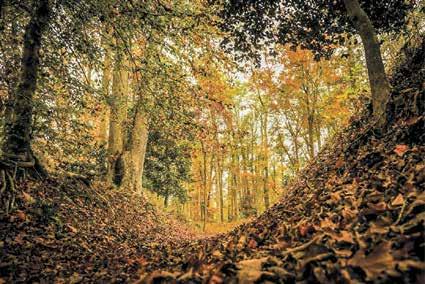
The American Battlefield Trust has its eyes set on saving a profound 245-acre property at the Williamsburg Battlefield, known historically as the James Custis farm.

While this treasured landscape has a transaction value of $9.2 million, it has been met with immense support. With partners like the federal American Battlefield Protection Program, the Commonwealth of Virginia and the United States Navy, the Trust is left to raise only $57,000,
creating a $163-to-$1 match for every dollar donated. This is a truly historic opportunity and marks the second-largest privatesector transaction in battlefield preservation history!
From the 1690s to the mid19th-century, a series of owners held the land as a plantation, and as such it is rich in archaeological resources. In 1861, Confederates built a second defensive line on the Peninsula, with Redoubt No. 11, of 14 in the line, within the property. The Civil War Fortifications Study Group deems it one of the best-preserved early war redoubts in the state.
During the spring of 1862, Union forces moved to threaten
forces were able to reestablish their line around Redoubt 11, repulsing the Confederates and earning the commander his sobriquet “Hancock the Superb.” Following the battle, the Union army used the nearby Custis farm buildings as a field hospital. You can help the Trust save this critical site by visiting www.battlefields.org/ Williamsburg245Acres.
The Trust Launches Its Latest Student Program, Americana U
Holt (freshman, University of South Carolina), Kamron Spivey (sophomore, Washington and Lee University) and Owen Lanier (freshman, Gettysburg College)
to raise interest in America’s first 100 years through planned events and increased awareness of www. battlefields.org. They will also create opportunities for historic site visitation to connect students with history at the locations where it unfolded.
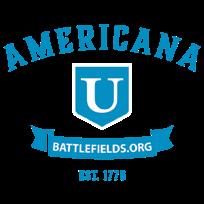
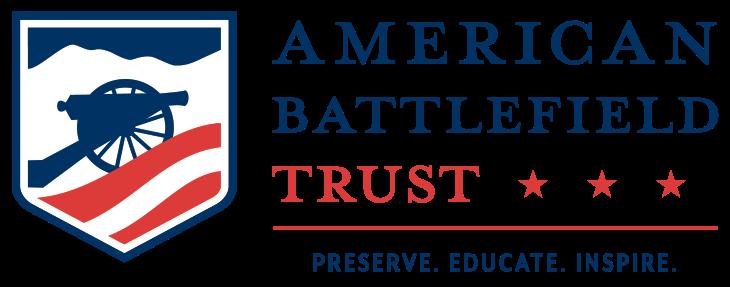
The Americana U program aims to build on the efforts of the Trust’s current student-led program for high schoolers, the Youth Leadership Team, and inspire college students to action. The Trust views positive peer influence as a powerful tool that can redirect the trajectory of the study of history across the country.
“Our history teaches us problem solving, moral character, responsibility, a respect for hard work and what can be done with limitless ingenuity, and the dangers of limitless ambition, all things necessary for a thriving and continuous republic,” says Owen Lanier, who will be steering the growth of Americana U at Gettysburg College. Just as his fellow campus leaders plan to do, Lanier will shed light on the vast utility the subject carries. To learn more about this inspiring program, visit www.battlefields. org/americana-u.
Mark Your Calendar for Park Day’s 26th Anniversary
Striving to spread the study of history across college campuses, the Trust has extended its historysaving mission by launching Americana U. This spring, student leaders at four college campuses will lay the foundation for the peer-to-peer network, encouraging history education and historic site visitation.
Americana U will call on campus leaders Ashlyn O’Neill (freshman, Virginia Tech), Daniel
For 26 years, the American Battlefield Trust’s Park Day has offered volunteers of all ages nationwide the opportunity to give back to their communities by helping maintain places sacred to our nation’s heritage. Battlefields and historic sites have embraced the hands-on preservation event to meet the needs of upkeep projects large and small, ranging from raking leaves and hauling trash to painting signs and building trails. This means that even amidst the COVID-19 pandemic, sites can rally to safely host deeply beneficial Park Day projects, while practicing social distancing or selecting alternative dates as necessary. While the pandemic demands flexibility amidst several unknowns, this year’s nationwide Park Day event is scheduled for April 9, 2022. All sites that wish to be listed on the American Battlefield Trust’s website and receive water bottles must register by March 10, 2022. Individual sites receive support from the Trust, including guidance on promotional tactics,
12 CivilWarNews.com March 2022 12 March 2022 CivilWarNews.com
The Trust has an opportunity to save Fredericksburg’s Slaughter Pen Farm forever. (Buddy Secor)
The Trust aims to save a 250-acre property at the Williamsburg Battlefield. (Brian Callan)
Park Day 2021 volunteers clear timber at Fort Pillow State Historic Park in Henning, Tenn. advice on how to secure material donations from local businesses and thank you gifts for volunteers, but have total control of project details.
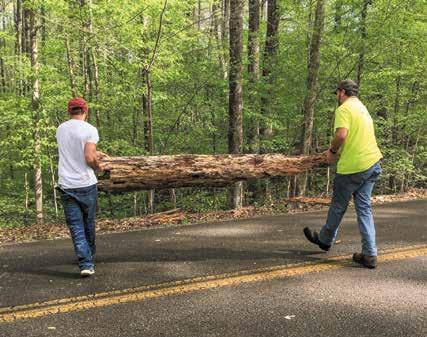
So far, Revolutionary War, War of 1812, and Civil War battlefields and historic sites across the nation have signed up in hopes of fulfilling necessary projects and look forward to welcoming volunteers. To register your site or find your nearest volunteer opportunity, please visit www. battlefields.org/parkday.
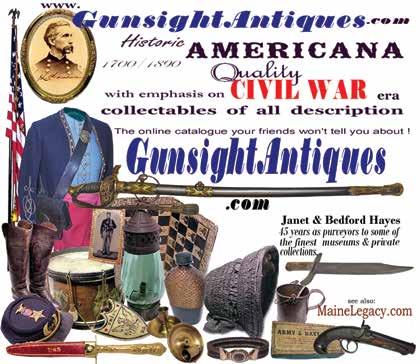

Travels with Darley Traverses South Carolina’s Liberty Trail
This past autumn, Darley Newman, Emmy Award–nominated host and producer, ventured to South Carolina to blaze the Liberty Trail, the innovative driving tour the American
Battlefield Trust is developing alongside the South Carolina Battleground Preservation Trust to highlight the Revolutionary War’s Southern Campaign. The end result of her time exploring Charleston and the surrounding countryside will be a winter 2022 episode of Travels with Darley, which airs nationally on PBS and via streaming platforms.

“The state’s brand-new Liberty Trail invites travelers to uncover lesser-known sites and fascinating figures related to the period,” said Newman. “Parks, battlefields, museums, and churches, along with landmarks in Charleston and the Francis Marion National Forest, bring to life key events and people in South Carolina’s 18th-century history that are often overshadowed by the war that unfolded further north.”
Check your local listings for when Travels with Darley airs on your PBS affiliate station. Visit
13 March 2022 13 March 2022 CivilWarNews.com CivilWarNews.com
48 E. Patrick St., Frederick, MD. 301-695-1864 / civilwarmed.org Divided by Conflict. United by Compassion.
our new website at: HistoricalPublicationsLLC.com
I Shall Never Forsake My Guns Battle of Valverde, N.M. – Part II

“Boys, you’ve come too far from home hunting a fight to lose. You must win tomorrow, or die on the battlefield.” – C.S. Col. Thomas Green, 5th Texas Cavalry Regiment
In February 1862, C.S. Gen. Henry Hopkins Sibley’s Army of New Mexico was in dire straits. His Texas supply base was hundreds of miles away. Sibley’s assumption that the residents of the New Mexico Territory would donate food and animals to the cause proved false. On February 16, Sibley failed to lure the Federals out from behind the thick walls of Fort Craig, N.M., to seize their supplies. The Army had to act or starve.
U.S. Col. Edward R. S. Canby who had been monitoring the Confederate movements, was able to block access to the high ground and the Rio Grande. Career soldiers Canby and Sibley attended West Point at the same time, fought in the MexicanAmerican war, and recently

served together in the New Mexico Territory. Unlike Sibley, Canby excelled in administrative skills and, according to a captain, “A more attentive, careful officer never strode a horse. He attends strictly to his duty, times the step, sees that everybody is cared for, and comes up to my idea of a field officer.”
The February 21, Battle of Valverde, N.M., began sometime around 7 a.m. at a strategic river ford five miles north of Fort Craig. Confederate scouts from Maj. Charles Pryon’s, 2nd Texas Mounted Rifles, sent word that they reached the river and “no Union troops in sight,” not realizing that the Federals had reached the river first. Emerging from the cottonwood trees, the Federal scouts shouted in Spanish, “There are the Texans— look out!” The Federal artillery and infantry raced into action. From behind the sandhills, the Confederates shot back. Lt. Col. William “Dirty Shirt” Scurry’s 4th Texas Mounted Rifles joined the shooting match.
By early afternoon more troops from both sides arrived. Sibley, suffering from alcoholism, turned over command to Col. Thomas Green, 5th Texas Mounted Rifles. Around 2 p.m., Green spotted
U.S. Capt. Theodore Dodd’s, Company B, 2nd Colorado Volunteers, approaching the field. Dodd’s 71 men were dressed in new grey shirt uniforms instead of the standard blue. Green misjudged them as untried volunteers. Green assigned the 5th Texas Mounted Volunteers, Capt. William Lang’s Texas Lancers, to attack them.
Lang’s company had not been trained how to fight with their lances. They were nine feet long with 3- by 12-inch blades topped by large pennants mimicking the original Texas flag of red with a white star in the middle. Sibley had seen the 18th century technology used during battle in the Mexican–American War, admired the sight, and procured 200 lances while equipping his army with any other weapons he could acquire.
Dodd’s company was getting in position when about 50 galloping horsemen suddenly appeared out of the woods. They charged emitting the “bloodcurdling rebel yell,” the blades on their spears gleaming, and pennants waving in the wind. Dodd’s West Point anticavalry charge training kicked in. He formed his men into a hollow square, two deep, the first rank kneeling with their bayonets; the
second rank behind them standing up, waiting with their guns, ready to shoot. “Steady there my brave mountaineers!” Dodd yelled. “Waste not a single shot. Do not let your passions run off with your judgment. … Guns to faces but wait for the command to fire.”
The Federals were silent as the Lancers advanced, anxiously waiting until they came within 40 yards. Dodd yelled, “Fire! They’re Texans! Give ’em hell!” The first volley “… sent many brave Texans to bite the dust; many horses were riderless. ... After the second volley there were but a few of them left and but one of them got away,” wrote Pvt. Alonzo Ickis. The Coloradans took advantage of the confusion to bayonet and club their foe, ending the only lance charge in the War.
Canby reached Valverde about 2:45 p.m. He decided to end the stalemate by assaulting the Confederate left with Maj. Thomas Duncan’s, 3rd Cavalry Regiment, 1100 men and a single 24-pdr. howitzer, and anchor the Federal left with the six-guns and 85 men of career soldier Capt. Alexander McRae’s, 3rd Cavalry Battery.

Snow flurries drifted down. “Under all military rules and science we were whipped,” Pvt. William Lott Davidson, 5th Texas wrote. “Outflanked on our
right, outnumbered more than two to one in the center and an enfilading fire on our left…” Green disagreed. He sent 250 men from Maj. Henry Raguet’s, 4th Texas to counter Duncan’s advance. Duncan requested reinforcements. Canby sent four companies of infantry to support Duncan, creating a hole in the center of the Federal line. Green sent 750 men from the 4th and 5th in three waves through the center, targeting McRae’s battery that had been moved up 150 yards near a grove of trees.
During the eight minutes it took the Texans to reach his battery, McRae fired four or five rounds per gun, rifles, and muskets. A Texas officer, is said to have shouted, “Surrender, McRae, we don’t want to kill you!” McRae, his arm shattered, replied, “I shall never forsake my guns!” McRae was felled by a fatal head wound. “Artillerymen threw lighted fuses into the limber boxes. One of these brave soldiers is said to have leapt atop the caisson and shouted, ‘Victory or Death!’ just before coolly shooting his pistol into the ammunition chest.”
As the Federals began a countercharge, Canby realized that “to prolong the contest would only add to the number of our casualties without changing the result,” and sent orders to retreat. Some men marching off


14 CivilWarNews.com March 2022 14 March 2022 CivilWarNews.com
Maj. Gen. Edward R.S. Canby. Colorization ©2022 civilwarincolor.com, courtesy civilwarincolor.com/cwn. (Library of Congress)
Map of the Battle of Valverde from the Official Records Atlas.
the field in parade formation, did not realize they had lost the battle until after they reached Fort Craig. Others accused Canby of being a traitor for retreating prematurely.
The shooting stopped at dusk. Many Confederates hadn’t had anything to eat or drink for 24 hours and a significant number of horses were dead. Under a white flag, Canby sent a request for a two-day truce to collect the dead and wounded due to the lateness of the hour and the winter night. Green made the decision not to pursue the Federals.
The Confederates had won a “Pyrrhic” victory that they internationally touted as “brilliant.” McRae’s captured three 6-pdrs. and two 12-pdrs. became the “Valverde Battery.” The Confederates suffered 230 casualties; 72 dead or mortally wounded, 157 wounded, and 1 prisoner, a 10 percent casualty rate. The 4th Texas Mounted Volunteers “voluntarily” became an infantry unit due to their heavy loss of horses and mules. Worse, the Confederates were down to five days of rations.
Sibley was “heartily despised
New Mexico again.
Federal casualties, despite Canby’s tactical withdrawal, stood at about 475; 111 dead, 160 wounded, and 204 missing, about 17 percent. Canby still held Fort Craig and the Federal supplies, and sent for reinforcements.
Sibley knew he couldn’t capture the fort but still had ideas. On February 22, George Washington’s birthday, Sibley demanded the surrender of Fort Craig. Canby replied that if the Confederates wanted the fort, they would have to take it. Instead, supplies known to be in Albuquerque, Santa Fe, and Fort Union, New Mexico, enticed the Confederates to head north.
Correction:
Part I stated at 300 miles it was the longest march the Confederates had yet made during the War; the march was over 600 miles.
Sources:
✤ Taylor, John. Bloody Valverde: A Civil War Battle on the Rio Grande, February 21, 1862,

University of New Mexico Press, 1999
✤ Nelson, Megan Kate. The Three-Cornered War: The Union, the Confederacy, and Native Peoples in the Fight for the West, Scribner, 2020
✤ Whitlock, Flint. Distant Bugles, Distant Drums: The Union Response to the Confederate Invasion of New Mexico, Univ. Press of Colorado, 2006
✤ Thompson, Jerry D. A Civil War history of the New Mexico Volunteer, University of New Mexico Press, 2015
✤ Edrington, Thomas S., Taylor, John M. The Battle of Glorieta Pass: A Gettysburg in the West, March 26-28, 1862, University of New Mexico Press, 1998
Stephanie Hagiwara is the editor for Civil War in Color.com and Civil War in 3D.com. She also writes a column for History in Full Color.com that covers stories of photographs of historical interest from the 1850’s to the present. Her articles can be found on Facebook, Tumblr and Pinterest.
The Confederate secretary of war, Judah P. Benjamin, said, “Laws cannot suddenly convert farmers into gunsmiths.” Consequently, most martial hardware the South used in the Civil War was imported from England. But some weapons were made right here in South Carolina in the 19th century, and some of those were carried into battle.

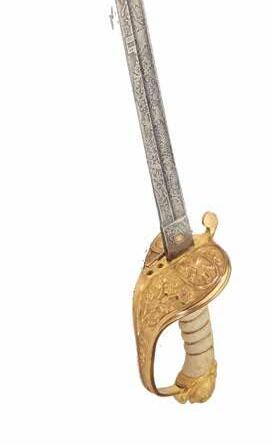
Our new exhibit has a significant collection of firearms and edged weapons to tell the story of how an agrarian state managed to arm itself while struggling to manufacture independently of industrialized regions. Come see how gunsmiths, silversmiths, and retailers were arming the Palmetto State!



15 March 2022 15 March 2022 CivilWarNews.com CivilWarNews.com
PLOWSHARES
SWORDS: ARMING 19TH CENTURY SC 301 Gervais Street Columbia, SC 803 737.8095 crr.sc.gov
TO
www.CollegeHillArsenal.com Tim Prince College Hill Arsenal PO Box 178204 Nashville, TN 37217 615-972-2418 www.CollegeHillArsenal.com Visit our new website at: HistoricalPublicationsLLC.com
Tracing Sherman’s March to the Sea:
“Charred and Black as Yankee Hearts”
Part One of a Four-Part Series
Sherman embarked upon his March to the Sea on November 15, 1864, taking with him on his southeastward journey two corps from the Army of the Cumberland (re-christened as the Army of Georgia) and two from the Army of the Tennessee. This force of some 60,000 men, little more than half the number participating in the Atlanta Campaign, advanced in two wings across the state before meeting at Savannah in December.
On a Sunday late in August, I followed the route taken by the Army of the Tennessee, Sherman’s Right Wing, commanded by Maj. Gen. O.O. Howard, from downtown Atlanta to the Oconee River, covering about half the distance to Sherman’s objective. Traveling on a course blazed by Georgia Civil War Heritage Trails (GCWHT), I halted every few miles to read the interpretive markers which tell the stories of Federal soldiers on the march, the civilians in their path, and the outnumbered Confederates laboring to hinder their advance.
I began at the Shrine of the Immaculate Conception near the State Capitol and Atlanta City Hall. The structure now standing there is post-war, built in 1873, but it was the pastor of this church who is credited with saving his and other nearby churches from the flames that burnt much of Atlanta as Sherman departed. Whether the popular story is true, partly true, or largely legend is debatable, but it is a great story. My favorite part is the threat made by Father O’Reilly to excommunicate the Catholics in Sherman’s army if the sacred buildings were burned.

The Army of the Tennessee proceeded southward, toward what are now Atlanta’s suburbs and exurbs. Most of the XV Corps, under Maj. Gen. Peter Osterhaus, halted for the night near Stockbridge. In his report Osterhaus wrote that he met a force of 1,000 Confederates, under Brig. Gen. Joseph Lewis, which made “a very feeble resistance.” (Lewis commanded the Kentucky Orphan Brigade, which certainly numbered well below 1,000 at this stage of the war.)
According to GCWHT’s information, the Federals easily repaired a bridge over Little Cotton Indian Creek, which had been burned by Lewis’s unit,
GEORGIA’S CONFEDERATE MONUMENTS
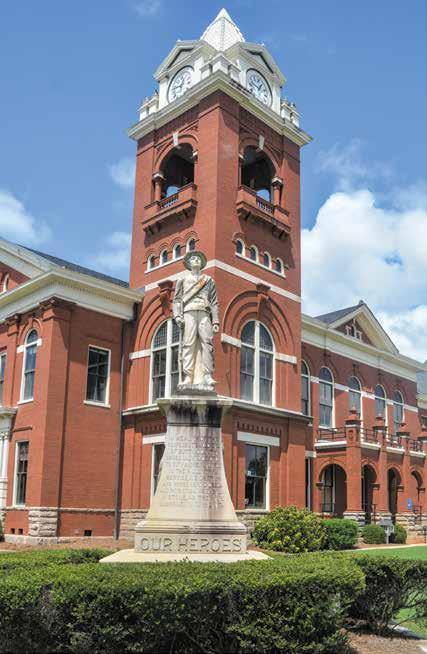
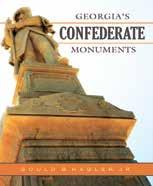
In Honor of a Fallen Nation
Gould B. Hagler, Jr.

This unique work contains a complete photographic record of Georgia’s memorials to the Confederacy, a full transcription of the words engraved upon them, and carefully-researched information about the monuments and the organizations which built them. These works of art and their eloquent inscriptions express a nation’s profound grief, praise the soldiers’ bravery and patriotism, and pay homage to the cause for which they fought.
www.mupress.org
866-895-1472
and pressed on to McDonough. There the entire XV Corps camped on the night of the 16th. The interpretive marker at the courthouse square states that the town was not burned, but homes, businesses, churches, schools, the courthouse, and a seminary sustained damage while being looted by undisciplined soldiers. Osterhaus’s report was silent about any damage done during his corps’ brief stay.
Further on, the marker at Locust Grove describes the action in the area through which the XV Corps passed on the 17th. The marker quotes a Confederate officer, Lt. John Ash, who “described the hopelessness of stopping the Federal advance.”
According to Ash, his regiment,
the 5th Georgia Cavalry, “could muster only 48 guns,” against the Federals’ “overwhelming numbers.” He wrote that “We were so completely run over that we were scattered in every direction, those of us who were not killed and captured.”
“The Federal soldiers marching through Locust Grove did not leave the area as they found it,” the marker tells us, and quotes a letter from a local woman to her soldier husband, telling him of “plantation after plantation destroyed.”
Ten miles or so beyond Locust Grove was Sylvan Grove Plantation, owned by Asa Buttrill. The interpretive marker here tells the tale of the Buttrill family’s unsuccessful effort to flee as news came of the Yankees’ approach from the north. On the 16th, Asa left with two wagons loaded with valuables, food, and other provisions; his daughter Mary, her aunt, two female slaves, and a disabled Confederate soldier followed in a carriage the next day, while Mrs. Buttrill remained at home. (Yes, this seems odd to me too.) Mary’s party encountered some Confederate soldiers along the way, one of whom was Mary’s brother, a lad of 17 years. As Federal cavalry appeared, the combatants fled, trusting, it seems, that the enemy
16 CivilWarNews.com March 2022 16 March 2022 CivilWarNews.com
toll-free
Butts County Courthouse in Jackson. (Photos by Gould Hagler) Shrine of the Immaculate Conception.
would not mistreat the women. Mary sought and received the protection of a chivalrous officer, Col. George Spencer, of the First Alabama Cavalry (U.S.), who ensured the party was not molested while Federal troops passed. Asa also met up with some Federal cavalrymen who plundered his wagons.

Colonel Spencer was smitten with Aunt Emma and tried to contact her after the war. Stranger matches have been made, but in this case the suiter was rejected.
Later, XVII Corps commander Maj. Gen. Frank Blair headquartered in the Buttrill’s 14-room home. After Blair and his staff departed, stragglers looted and vandalized the place. “Sylvan Grove’s barns, stables, cribs and fences, cotton and gin houses were all burned, while all cows, chickens, horses and mules were killed or stolen.”
The Federals then marched through Jackson, just south of Sylvan Grove, and left their mark on the town. The interpretive marker on the square tells that Gen. Howard’s chief of artillery described Jackson as “a beautiful little place and evidently occupied by the most prosperous people of that region.” The modern traveler learns that during the previous summer Jackson had not been as heavily foraged as areas closer to Atlanta had been. That good fortune was erased on the 17th. By the time the Federals left,
the area had been stripped of provisions. Homes were spared but the courthouse and business establishments were burned. Foodstuffs were carted off and livestock either taken or killed. After Jackson both corps pressed on to the Ocmulgee River, which, in the face of a more powerful enemy, would have been a significant obstacle. As it was, the Federals reached and then crossed the river with no difficulty except for bad weather and clogged, muddy roads. General Osterhaus reported that he “succeeded in pushing the Twenty-ninth Missouri Infantry to that river” on the same day the troops passed through Jackson. The Missouri regiment secured both banks and rapidly built two pontoon bridges. On the 18th and 19th, the entire army crossed, leaving behind a destroyed cotton factory and other facilities “which had been used for military purposes by the rebel Government.”


Marching south toward Clinton, the Federals passed Sunshine Church, the scene of a battle the previous July. A GCWHT marker informs the traveler of this earlier clash, in which Federal cavalry under Maj. Gen. George Stoneman was defeated by a Confederate force commanded by Brig. Gen. Alfred Iverson. Stoneman surrendered with 400 of his men, while others in his command “made a harrowing
cross-country escape.” Stoneman was the highest-ranking Federal officer captured during the war. He was freed in October, exchanged for Confederate Brig. Gen. Daniel Govan.
An Illinois captain wrote that Federal soldiers came upon the unburied bodies of two Federal soldiers killed in the July battle. The marker states that “This find increased the bitterness already felt toward Confederates.” The Federals burned the church.
Past Sunshine Church, the Federals came to Griswoldville, where Connecticut-born Samuel

Griswold operated a factory making revolvers for the Confederacy, “plus swords, pikes, bricks, soap, candles and other materials.” On the 20th and 21st troops destroyed the factories and most of the small town. The following day a green and poorly equipped Confederate force composed of Georgia Militia and local defense units from Athens and Augusta, attacked a veteran Federal brigade entrenched in a strong position just east of the town.
A plaque installed in 1957 by the Georgia Historical
Georgia Civil War Heritage Trails has clearly marked the route with directional signs which lead to the interpretative markers. The GCWHT’s website (https://www. civilwarheritagetrails. org/) also contains each marker’s GPS coordinates. Brochures for the March to the Sea Trail and other driving routes, available from GCWHT, contain much useful information including excellent maps. I suggest that travelers make use of all three resources. If you use only the GPS coordinates to get from one stop to the next you will be led upon modern roads and miss much of the fun. If you are like me, you will miss a sign now and then or take a wrong turn. When this happens the GPS coordinates will get you back on track. GCWHT’s address is PO Box 1864, Evans, Georgia, 30809.
Commission numbers the Confederate casualties in this one-sided engagement at 523. The American Battlefield Trust’s estimate is double that. One source states that 600 Georgians were captured. The Federal brigade lost a dozen or so killed and about 80 wounded. A tablet on the nearby battlefield quotes a Confederate colonel who was not present at Griswoldville, but later wrote of the battle: “This engagement, while it reflects great credit upon the gallantry of the Confederate and State forces engaged, was
17 March 2022 17 March 2022 CivilWarNews.com CivilWarNews.com
Griswoldville was never rebuilt. Samuel Griswold died in 1867.
Not all the roads on the March to the Sea Trail are paved; I was relieved to see the directional sign.
Sunshine Church II, built in 1880.
Sylvan Grove, then a plantation, now a small hospital.
unexpected, unnecessary and utterly unproductive of any good. The Battle of Griswoldville will be remembered as an unfortunate accident whose occurrence might have been avoided by the exercise of proper caution and circumspection.”
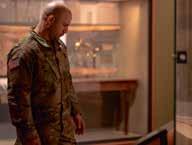
East of Griswoldville is Gordon, a small community with a townscape dominated by a gigantic kaolin plant. Gordon is on a rail line which, in 1864, was the important Central of Georgia Railroad that ran between Savannah and Macon. A branch line to the north connected Gordon to Milledgeville, the state capital.
At Gordon, the local commander of the small Confederate force did exercise “proper caution and circumspection” and withdrew his men to the Oconee River
before the Yankee cavalry arrived on the afternoon of the 21st.
Federal soldiers remained in Gordon for two days, ripping up rails, wrecking other facilities, and “foraging widely for foodstuffs and animals.” Diarist Fanny Andrews passed through Gordon in December and recorded this impression: “There was nothing left of the poor little village but ruins, charred and black as Yankee hearts.”
At the Oconee River the Confederates mounted a skillful defense at the railroad bridge and downstream at Ball’s Ferry. The 1,200 defenders managed to delay the Federals’ march for a couple of days, but against two Federal corps they could do only so much. The Federals secured a bridgehead, forced the
Historical Reproduction Tents
We make the best tents in history!
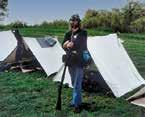
The best selection of historical reenactment items from Medieval era to Civil War era. Print catalog is only $2 and includes over 60 pages of our famous tents with a full-color section. Digital catalog is free to download by visiting PantherPrimitives.com.
SEND for your copy TODAY. 304-462-7718
GET TYSBURG explore
Confederates to retreat, and then built two pontoon bridges. By nightfall on November 26 the entire Army of the Tennessee was across.
The XV and XVII Corps pressed on. They burned the railroad bridge and marched southeast. As the marker at Ball’s Ferry says, “With both the Ocmulgee and Oconee Rivers behind the Federal army, only the Ogeechee remained.”

Future columns will trace the remainder of the route taken by Gen. Howard’s army and the route taken by the Left Wing, the two corps under Maj. Gen. Henry Slocum.
Gould Hagler is a retired lobbyist living in Dunwoody, Ga. He is a past president of the Atlanta Civil War Round Table and the author of Georgia’s Confederate Monuments: In Honor of a Fallen Nation, published by Mercer University Press in 2014. Hagler speaks frequently on this topic and others related to different aspects of the Civil War and has been a regular contributor to CWN since 2016. Hagler served for several years as a member of the GCWHT Board of Trustees. He can be reached at gould. hagler@gmail.com.
Winter Reading Adventures
LIVE STREAMED
Jan. 8 through Feb. 26
Saturdays, 11 a.m.
The True Tales & Trailblazers from American History theme features a new children’s book each weekend. Designed for families with children ages 4 to 10.

Winter Lecture Series

IN-PERSON & LIVE STREAMED
Jan. 8 through Mar. 12
Saturdays & Sundays, 1:30–2:30 p.m.
Rangers, historians and authors present people, places and continuing legacies of the American Civil War featuring a new topic each weekend.
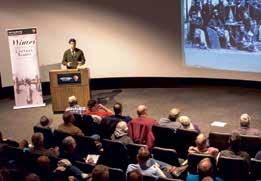
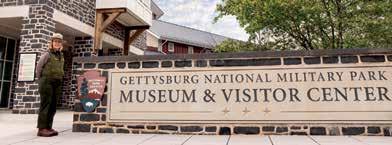
Free tickets required and available the day of each presentation at the Ticket Counter. Limited seating on a rst come, rst served basis.
Face coverings/masks required in the theaters. For details and program schedules, visit nps.gov/gett/planyourvisit/interpretation
18 CivilWarNews.com March 2022 18 March 2022 CivilWarNews.com
Proceeds from tickets and other purchases in the Museum & Visitor Center benet Gettysburg National Military Park and Eisenhower National Historic Site. For tickets and current hours, call 877-874-2478 or visit GettysburgFoundation.org. 1195 BALTIMORE PIKE, GETTYSBURG, PA 17325 See the Film. Experience the Cyclorama. Explore the Museum. Tour the Battleeld. THE OFFICIAL START TO YOUR GETTYSBURG VISIT
Gettysburg National Military Park Museum & Visitor Center
Gettysburg National Military Park’s popular winter programs return to the Museum & Visitor Center for 2022.
The stops along the trail are marked with a red star; this one is at Ball’s Ferry.
Panther Primitives • P.O. Box 32 • Normantown, WV 25267
Twenty Days in the Life of a Common Soldier
by Bruce Allardice and Wayne Wolf Alonso Corydon Stevens (1837–1917) of Muscatine,
Iowa, spent three years in the 10th Iowa Infantry.1 An ardent believer in the indissolubility of the Union, he was willing to endure the boredom, privation, disease, and theft of army life to preserve the Union. His service was punctuated with periods of endless marching, dysentery, diarrhea, poor or no food, foraging, lost letters to home, and frequent medical issues.
morning when we started again for Iuka. Came up on the enemy at a little before sundown and had a battle. A good many of the 5th Iowa were killed.3
Saturday, Sept. 20: We lay all night on our arms on the extreme left. Early this morning we found Price had evacuated and we started in pursuit southwest. Went 8 or 10 miles but could not catch him. We returned to the first old camp and fortifications.
Sunday, Sept. 21: After starving for 2 days we drew 2 days rations and proceeded to Jacinto. We
on the right of our lives [sic lines] and slight shower at camp. Our tents and knapsacks come up. Our knapsacks badly used up.
Saturday, Sept. 28: All quiet during the night. Relieved at 9 o’clock. One blanket, one shirt and some other things taken from my knapsack. I got a letter from Sarah of the 23rd ult. Also one from Darius.5
Sunday, Sept. 29: It is raining today. I wrote a letter to Sarah and Darius. Orders to drill hereafter 4 hours per day.
Monday, Sept. 29: Rainy all last night. I am studying some on grammar. Weather damp. Drill again today.
Tuesday, Sept. 30: Drill and etc. Nothing of importance today.
Wednesday, Oct. 1: Orders at 2 o’clock (a.m.) to get ready to march at 4 o’clock. We started in the direction of Corinth. We stop near Corinth and bivouac for the night near the road.
Tuesday, Oct. 2: I am detailed for guard at Gen. [Jeremiah] Sullivan’s hdqs 6 Orders to march at 11 o’clock. March a mile towards Corinth. We have all the fatigue to do at hdqs.
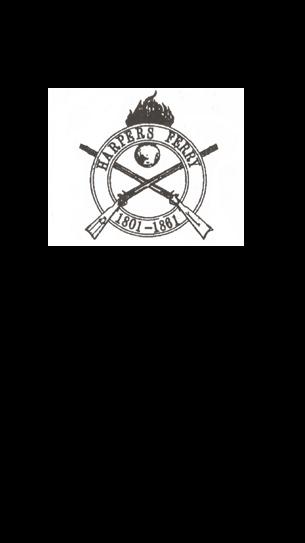
Friday, Oct. 3: Orders to march at 3 o’clock a.m. Start just at daybreak. Get to Corinth about sunup and find the place to be besieged with rebels. We are on the extreme right and do no fighting. We advance on the enemy. J. Cox, Bish and Osker Gray7 wounded.
Saturday, Oct. 4: Cox died of his wounds. Our Regt. lay in skirmishing order last night on the right. At the first appearance of day the battle was renewed by terrific cannonading by the rebels. We were assaulted at ten o’clock and after 3 hours fighting repulsed the enemy.8
Sunday, Oct. 5: Osker Gray died of his wounds. We took up our line of march following Price. At 6 o’clock a.m. pass over the first of the battle ground and saw a great many dead killed Friday. Traveled 8 or 10 miles today. A battle is fought today by Gen. Ord’s troops. He whips Price9 again and takes 2 batteries.10
Monday, Oct. 6: March about 10 or 12 miles today. Price is leaving his train, camp equipage and many valuables. It appears his army is demoralized and out of provisions. We take many prisoners. We finally turn in the direction of Rienzi. All in fine spirits.
Endnotes:
1. Stevens enlisted in Co. H, 10th Iowa, Aug. 23, 1861, and was mustered out at Kingston, Georgia, three years later. His occupation is listed as “commercial traveler.”
2. The heavy rains delayed Rosecrans’ advance on Iuka. See Peter Cozzens, The Darkest Days of the War: The Battles of Iuka and Corinth (Chapel Hill, University of North Carolina Press, 1997).
3. The 10th Iowa held the extreme
The 20 days of his newly discovered diary presented here are a glimpse into the human side of the war, including (sadly) how soldiers stole items from each other. They portray the reality of a common soldier’s life in the American Civil War.
The excerpt starts with the Tenth Iowa advancing to the Battle of Iuka, Miss. (Sept. 19, 1862), and ends in the aftermath of the Battle of Corinth (Oct. 3-4, 1862), both Union victories.
Wednesday, Sept. 17, 1862: Our knapsacks to the wagons. I expect tomorrow night off. But no go today. Considerable cannonading in the direction of Iuka.
Thursday, Sept. 18: It rained very hard last night.2 Clear today. All got a good soaking. We wet [sic went] out last night at 10 o’clock and stayed all night to support a section of the 12th Wis. Battery. We start on the road to Iuka.
Friday, Sept. 19: We lay a few miles from our old camp till this
arrived there late at night very much fatigued. I was so much so I couldn’t eat my supper.
Monday, Sept. 22: Reveille at 4 o’clock. Sweet potatoes for breakfast. We move near a mile east of Jacinto and go into camp. All this regiment except “A” and “B” [companies] went 8 miles east foraging. I came back after dark and found my blanket stolen.
Tuesday, Sept. 23: It is cool and cloudy and rains a little. Osborn Skinner4 came this evening. I sent a letter to Sarah [wife Sarah Ellen Clark (1838–1931)].
Wednesday, Sept. 24: It rained last night. We have no tents yet. I went over to the 2nd Iowa Cav. and saw a friend. A part of them left today. Our mail came in but I got nothing. I wrote to Darius and father.
Thursday, Sept. 25: Get papers of the 23rd containing President Lincoln’s Emancipation [issued Sept. 22] and an account of the battle of Iuka.
Friday, Sept. 26: I was detailed for picket for one day. We stand
left of the Union line at Iuka, and was only lightly engaged, losing six wounded.
4. Dr. John Osborn Skinner (1824–1909), regimental surgeon.
5. Probably Darius Pingrey (1836–1908), a neighbor already invalided out of the army.

6. Brig. Gen. Jeremiah Sullivan (1830–1890) led the brigade that included the 10th Iowa. He was wounded at Corinth.
7. William Cox (1842–1862); John Bish (1842–1893), a cousin of Mrs. Stevens; Oscar Gray (1842–1862), all of Co. H.
8. The 10th Iowa, stationed north of Battery Powell, was attacked by Martin Green’s Division. Stevens fails to mention that the Confederates initially drove the 10th Iowa back. For more on the battle see Timothy B. Smith, Corinth 1862, Siege, Battle, Occupation (Lawrence, University Press of Kansas, 2012). The 10th lost three killed and 36 wounded at Corinth.
9. The Confederate army was actually commanded by Major General Earl Van Dorn, but Sterling Price’s Corps bore the brunt of this engagement and the Battles of Iuka and Corinth.
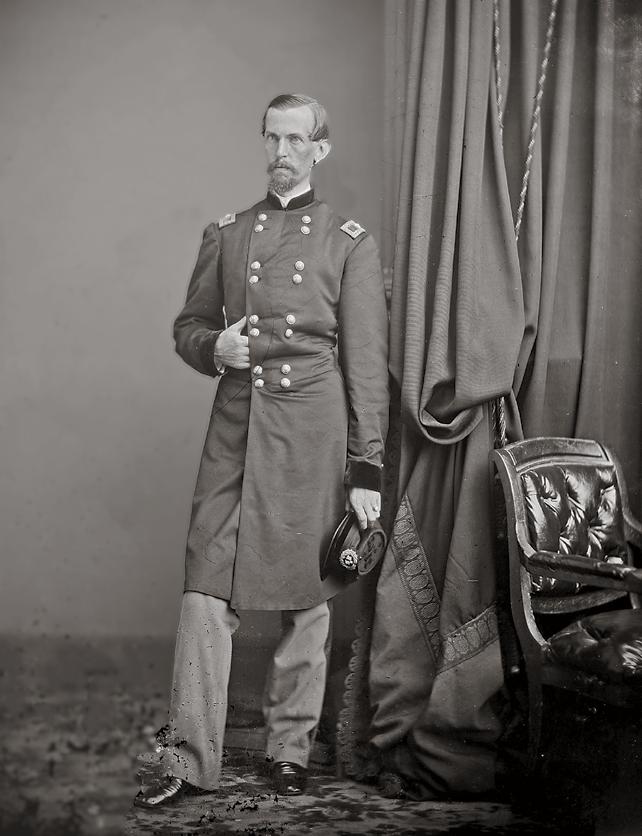
10. This is the Battle of Davis Bridge, where General Ord’s troops successfully attacked the retreating Confederates.
Bruce S. Allardice is Professor of History at South Suburban College in Illinois. He is a past president of the Civil War Round Table of Chicago.
Wayne L. Wolf is past president of the Lincoln-Davis Civil War Roundtable.
19 March 2022 19 March 2022 CivilWarNews.com CivilWarNews.com
General Jeremiah Cutler Sullivan. (Library of Congress)
Alonzo C. Stevens.
Subscribe online at CivilWarNews.com
AHot Fight at Cool Spring
by Carl Sell Jr.
Perhaps the coolest thing about the Cool Spring Battlefield is its location.
Now owned by Shenandoah University, this Civil War battlefield is located on the Shenandoah River at the foot of the Blue Ridge Mountains about two miles north of Harry Byrd Highway (Route #7) in Clarke County, Va.
Most of the time, the Shenandoah moseys past the battle site with a solitude belies the bloody July 18, 1864 battle between Confederate forces led by Lieutenant General Jubal Early and pursuing Federals under the command of Major General Horatio G. Wright. Early was retreating to the Shenandoah Valley after the raid into Maryland and Pennsylvania
that brought him to the doorstep of the nation’s capital.
The Shenandoah University River Campus at Cool Spring is a 195-acre site that overlooks the main battlefield and once was part of the 1,120-acre estate owned by Richard Parker, the judge who presided over John Brown’s trial in 1859. Brown was tried and convicted of murder and treason and hanged in Charles Town for his attack on the Harper’s Ferry Armory.
The river flows north as it heads toward Harper’s Ferry to join the Potomac for a journey to the Chesapeake Bay. The river runs north because the Shenandoah Valley and its parallel mountains rise as they head southward.
The battlefield was preserved in 2012 by the Civil War Trust (now the American Battlefields Trust).
The property was transferred to Shenandoah University in 2013 as part of a $2 million deal that included $800,000 from the Virginia Civil War Sites Preservation Fund and $200,000 from the National Park Service American Battlefield Protection program.
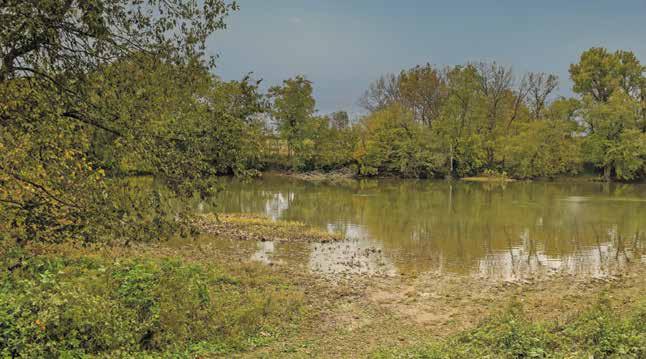

Once the site of the Virginia National Country Club and Golf Course, the property is used by Shenandoah University as an outdoor classroom for environmental and historical studies as well as the preservation and interpretation of the battlefield. Much remains to be done, including improving the access road from Route #7. Contact Shenandoah University to see how you can help. The former golf course clubhouse is used as the headquarters for the park and includes a growing museum of artifacts and information that help explain the battle.
Judge Parker’s estate house, named The Retreat, overlooks the Shenandoah at precisely the point where the battle occurred. Now used as a venue for weddings, conferences, and meetings, it is privately owned and not available to the public visiting the battlefield. However, a public trail takes history buffs from the parking lot to the river. Historic signage along the way explains the battle.
The Retreat was built in 1799 by Judge Parker’s grandfather, Thomas Parker, who fought
in the Revolutionary War and the War of 1812. Judge Parker served briefly in the United States Congress until he was elected judge of the Thirteenth Circuit Court of Virginia in 1859. He lived in Winchester and used the Retreat as a summer home. The Cool Spring house was built in 1794 by Ralph Worsley IV of London.
Across the river is the Holy Cross Abbey, where Cisterian monks prepare their worldfamous bread and fruit cakes for sale at the gift shop. The monks have been there only since the 1950s. Enjoy the spectacular view of the Blue Ridge Mountains while you are there.
The Both Sides Civil War tour has visited both sides of the river, the most recent occurring in late 2021 to view the improvements and updates accomplished by Shenandoah University. The nearby area is rich in both American history, including houses still standing that were owned by George Washington’s relatives. Snickers Gap in the Blue Ridge and Castleman’s Ferry over the Shenandoah River were on one of the most-used routes during the Civil War.
Union cavalry caught up with Early’s forces at Purcellville on the road to Snickers Gap, destroying a number of wagons before being stopped by Confederate infantry. The Rebels moved through the Blue Ridge and crossed the Shenandoah River before bivouacking on the

20 CivilWarNews.com March 2022 20 March 2022 CivilWarNews.com
The Retreat overlooks the battlefield at Cool Spring. (Photos by Bill Kamenjar)
Cool Spring crossing.
Map of Cool Spring Battle, July 18, 1864. Map prepared by Steven Stanley. American Battlefield Trust.
Don Hakenson, another co-leader of the Both Sides Tours, points out key elements of the battle on an enlarged map.

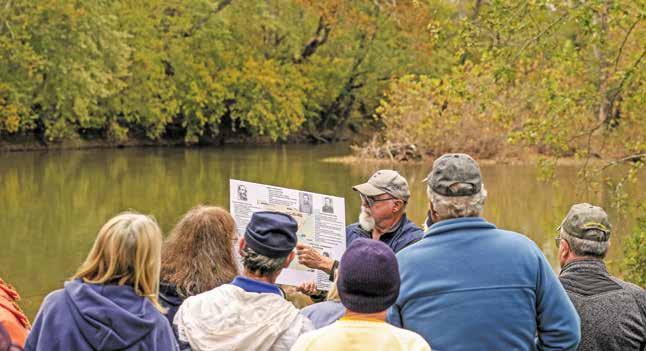
Berryville Turnpike.
Early on July 18, cavalry led by Union Brigadier General Alfred Duffie attempted to cross the river at Castleman’s Ferry but was beaten back by Confederate artillery and sharpshooters under Major General John B. Gordon who were stationed in houses so they were literally looking down at their adversaries. Almost two years earlier, the same thing happened when Union cavalry attacked Confederate forces under Major General A. P. Hill who were resting there after battles at Antietam and Shepherdstown.
As a result, Brigadier General George Crook and Wright agreed to try an attack downstream. Led by Confederate deserter John Carrigan, a harness maker who lived in the area, Colonel John Thoburn took approximately 5,000 men, who were shielded by trees along the river, and began to cross at Parker’s Ford in front of The Retreat. They captured a number of Confederate skirmishers, who reported large numbers of their comrades camped nearby. Nonetheless, Thoburn advanced and set up a line behind a stone wall about 75 yards from the river.
From their vantage point on the

the Confederates continued their march into the Valley and the bulk of Union forces withdrew toward Washington City. Crook and his command were left to defend Winchester against Confederate capture. A week after Cool Spring, Early defeated Crook at the Second Battle of Kernstown, forcing the Union’s evacuation of Winchester. In response, Lieutenant General Ulysses Grant named Major General Philip Sheridan commander of a new Army of the Shenandoah and gave him orders to defeat Early and deny the Confederates their most fertile
area of supplies.
Starting with the Third Battle of Winchester, Sheridan rolled up a series of victories that seized control of the Valley by causing Early to retreat all the way to Staunton and beyond. What followed was the destruction of crops, stores, and animals that otherwise would have been sent to General Robert E. Lee’s army at Petersburg. Today, there are
Want to Advertise in Civil War News?
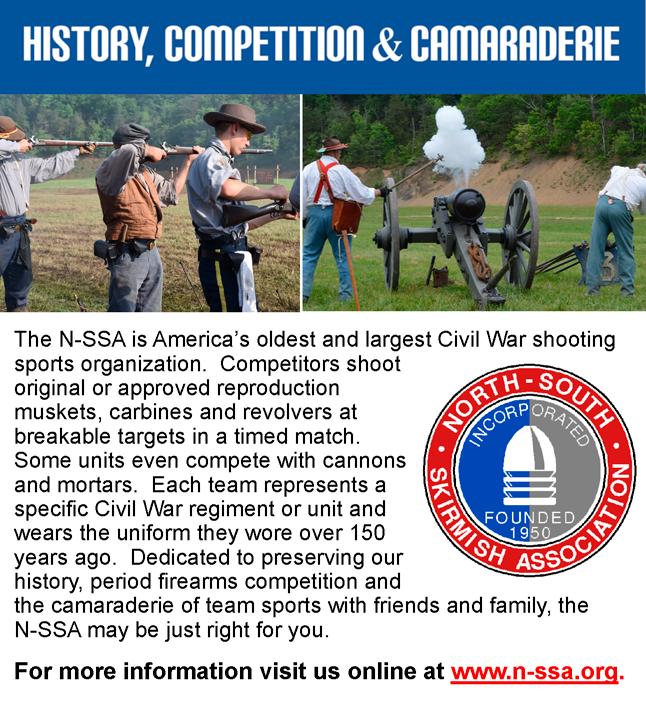
few, if any, outbuildings and barns dating before 1865 in the Valley between Winchester and Lexington.
Carl Sell is a co-leader of the Both Sides Tours as well as an author and frequent contributor to CWN. He has written books about his great grandfather, James Farthing, in the Civil War as well as a recent update on the life or Major General James Ewell Brown Stuart. Ironically, Carl also has published a booklet about Civil War activities in the area of Snickers Gap, the break in the Blue Ridge that overlooks the Shenandoah River and the Cool Spring battlefield. The Gap was one of the main avenues of movement by both sides during the war. Contact Carl at sellcarl@ aol.com of 703-971-4716.
mountain, Generals Crook and Wright could see the Confederates moving toward Thoburn’s position, including a contingent led by General Robert Rodes that threatened the Union right flank. Many Union defenders were forced back across the river, but others held their ground and were able to fend off three charges by Rodes before retiring at nightfall. Federal artillery helped slow the Confederates, but shells occasionally landed on the defenders, adding to the casualties.
Although of short duration, Cool Spring was a particularly bloody affair, much like many clashes in the Shenandoah Valley. Union losses totaled 422, including a number who drowned while trying to cross the river to safety. Confederate losses were 397.
At the height of the battle, Brigadier General James Ricketts refused to move his men across the river to support Thoburn despite Brigadier General George Crook’s request to do so. Crook then appealed to Major General Wright, who agreed with Ricketts, citing the strength of the Confederate position. After a day of sporadic gunfire on both sides,
21 March 2022 21 March 2022 CivilWarNews.com CivilWarNews.com Loyal Legion of the Confederacy CSA National Defense Medals & other banned internet items Civil War Recreations WWW.CWMEDALS.COM cwmedals@yahoo.com 1 Smithbridge Rd., Unit 61, Chester Heights, PA 19017
Ben Trittipoe, co-leader of the Both Sides Tours, speaking to the group at Cool Spring.
us at: ads@civilwarnews.com
Email
digital edition at https://rotunda. upress.virginia.edu/founders/ AWJN.html. See UVA image. To browse the UVA site, one must create a free user account. Read instructions for using the site at https://rotunda.upress. virginia.edu/founders/default.
xqy?keys=AWJN-info-about. A quick method of searching the site resides at https://rotunda.upress. virginia.edu/founders/default.
xqy?keys=AWJN-info-search.
The Papers of Andrew Johnson

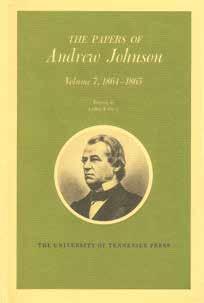
misfiled, many books contain correspondence from other people to the president. Researchers studying the American Civil War can benefit from drilling into these papers; several websites offer additional sources.
Our nation’s seventeenth president, Andrew Johnson, rose to the chief executive position upon the assignation of President Abraham Lincoln. Thanks to the efforts of editors Roy P. Graf, Ralph W. Haskins, and Paul H. Bergeron, the University of Tennessee Press has published 16 volumes of Johnson’s papers. Due to a shortage of Johnson’s actual writings, either lost or
The 16 volumes cover the period of 1822 through 1875 and break out as follows: volume 1, 1822-1851; volume 2, 1852-1857; volume 3, 18581860; volume 4, 1860-1861; volume 5, 1861-1862; volume 6, 1862-1864; volume 7, 18641865 (cover shown); volume 8, May-August 1865; volume 9, September 1865 – January 1866; volume 10, February –July 1866; volume 11, August 1866 – January 1867; volume 12, February – August 1867; volume 13, September 1867 – March 1868; volume 14, April – August 1868; volume 15, September 1868 – April 1869; and volume 16, May 1869 – July 1875. Those interested in purchasing copies may find them at the UT Press site, https://utpress.org/papersof-andrew-johnson/. The scope of the UT collection resides at https://scout.lib.utk.edu/
repositories/2/resources/2387. Users can also check www. worldcat.org to locate copies in a nearby library. Each volume contains a detailed index for quickly locating topics under review, and the University of Virginia offers a

Researchers can enter their search term at the top, for this example, Atlanta. Next, select specific date ranges for the search; for this test, 1864-65. A new page will open and reveal the search results, like this letter from Benjamin C. Truman to President Johnson, dated July 17, 1864, from Marietta, Ga. Try various searches at the UVA site, and explore additional

archival information on Johnson at the Library of Congress, https://www.loc.gov/collections/ andrew-johnson-papers/aboutthis-collection/. Continued good luck in researching the American Civil War!
Michael K. Shaffer is a Civil War historian, author, lecturer, and instructor, who remains a member of the Society of Civil War Historians, Historians of the Civil War Western Theater, and the Georgia Association of Historians.

Readers may contact him at mkscdr11@gmail.com or request speaking engagements via his website www.civilwarhistorian. net. Follow Michael on Facebook www.facebook.com/ michael.k.shaffer, and Twitter @ michaelkshaffer.
Day by Day through the Civil War in Georgia
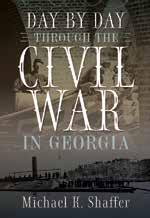
Until now, a daily account (1,630 days) of Georgia’s social, political, economic, and military events during the Civil War did not exist. In Day by Day through the Civil War in Georgia, Michael K. Shaffer strikes a balance between the combatants while remembering the struggles of enslaved persons, folks on the home front, and merchants and clergy attempting to maintain some sense of normalcy. Maps, footnotes, a detailed index, and bibliographical references will aid those wanting more.
February 2022 • $37.00, hardback
Michael K. Shaffer is a Civil War historian, instructor, lecturer, newspaper columnist, and author. He is a member of the Society of Civil War Historians, Historians of the Civil War Western Theater, and the Georgia Association of Historians. Contact the author: mkscdr11@gmail.com
www.mupress.org • 866-895-1472 toll-free
22 CivilWarNews.com March 2022 22 March 2022 CivilWarNews.com
Original letter image to Johnson.
UVA image, The Papers of Andrew Johnson.
COLLECTION
A Girl’s Captured Expression
From the Liljenquist Family Collection of Civil War Photographs. (Library of Congress)
Poignant image of a young girl is wearing a plaid dress, gilt jewelry and silk ribbons. She holds a framed photograph of possibly her father in uniform with a saber and Hardee hat. Perhaps he died during the Civil War or she is holding the photograph because it is dear to her. One thought is that she is wearing a purple and black mourning dress. Wealthier westerners would often turn to purple in mourning to stand out from the crowd, and because they could afford the dye. The technology by which photographs were produced displayed colors in black and white differently than modern films. Yellows and reds appear dark, while blues appear light. But she is certainly dressed for a special occasion. The extravagance of her outfit is emphasized not only by the large scale of the plaid fabric of her dress, the (probably silk) ribbon decorations on her sleeves, but also by the dots of gold paint highlighting her jewelry. Image colorized in Adobe Photoshop.

Medium: photograph: sixth-plate tintype, hand-colored; 9.5 x 8.4 cm (case)
Reproduction Number: LC-DIG-ppmsca-36863

23 March 2022 23 March 2022 CivilWarNews.com CivilWarNews.com
This young girl’s facial expression tells it all. The sadness is clearly visible in her blank stare. Any war, during any time, always has casualties at home.
American Digger 2022 Lowcountry Show Better Than Ever
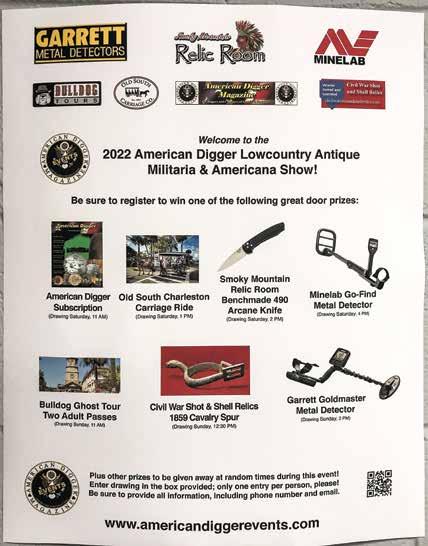
MOUNT PLEASANT, S.C.—
The annual Lowcountry Antique Militaria & Americana Show has been an annual tradition for many years, and 2022 lived up to expectations. The show, usually held the first weekend in January, was temporarily moved this year to January 14th & 15th to avoid a conflict with New Year’s Eve. While the vendors and dealers were almost equally split on whether the change better fit their schedules, all agreed the show was well-attended both by those manning the tables and the public coming through the gate.


In fact, both were the highest ever at the South Carolina show under American Digger Events, subsection of American
Digger magazine and Greybird Publishers), with a virtual sellout of 8-foot tables. According to Mark Schuessler, one of three partners who make up American Digger Events staff, 200 tables were delivered for the show, and despite extras on hand when the smoke cleared only one table remained folded on standby. The organizers plan to increase the number next year to accommodate last-minute dealer table rentals and add-ons. However, as the show hall will hold only about 230 tables as they are now set up, there is a good chance that next year the show will be sold out by opening time.
The regular venue, the Omar Shrine Temple in Mt. Pleasant,
was again used. At one time the event was held in downtown Charleston, subjecting attendees to traffic and parking issues. By moving to Mt. Pleasant about 15 years ago, the show has become much more accessible to both dealers and the general public.
The host hotel, Comfort Inn & Suites of Mt. Pleasant, offers the best in show convenience, with the venue only a few hundred feet away. In fact, many dealers choose to walk over to the show hall from the hotel each morning, thus avoiding the risk of losing their parking places at the hotel while getting in a little morning exercise. The show promoters arranged for a block of rooms at the hotel to be discounted for the table holders. The hotel also offers arguably the best complimentary breakfast found at any relic show host lodging. It’s hard to beat Lowcountry cooking, and breakfast is no exception.
won, partially due to its rarity and condition, and partially because it had been dug just the day before the show officially began by winner Nick Amelio, whose understandable excitement was contagious. In fact, those who hope to win an award at any show should be aware that it is not always the artifact’s rarity that wins the votes, but also the excitement it creates among those who view it.
The Best Non-Dug award went to Dr. Ed West for an unpublished
CDV of General Longstreet taken in Charleston shortly before the city was evacuated in 1865. West’s table partner Bryan Davis took the Most Educational award for his display showing fake relics and his explanation of why they were “bad.” The newest award, Best Display, given for the first time, was won by Chris Trimble for his outstanding presentation of Imperial German helmets. Despite the outstanding artifacts seen at the event, Best of Show was an easy decision
The hall was full of shoppers by lunchtime on Saturday, with many staying several hours after paying their admission. Sunday was also well attended.
The show featured items representing all eras and areas of history up to WWII in the form of both dug and non-dug relics and weapons, fossils, Native American artifacts, stoneware and bottles, books, art, photographs, letters, Americana, jewelry, metal detectors, and more. Although at one time the focus of the show was on the Civil War, there is a broader mix nowadays to cater to collectors interested in other periods. This is a natural evolution of collectors and is becoming a popular show genre for many shows that were once exclusively Civil War oriented. If the economy and morale of the nation can be judged from this show, it is encouraging. Numerous big-ticket items exchanged hands among happy sellers and buyers; smaller sales were brisk both days. Radio and newspaper advertisements, plus a radio interview with show chairman Butch Holcombe encouraged the public to bring their items for appraisal. In that vein, appraiser John Sexton offered his services to the public and brokered several sales between the public and dealers.
High quality Civil War weaponry could be found on Wallace Markert’s tables, including this Confederate sword. Sales of high-end pieces were reported to be quite successful according to several dealers.
Quality door prizes were given to lucky Lowcountry Show attendees thanks to the generosity of the sponsors. In exchange for prizes, the promoters have promotional materials like this poster printed and posted in the hall and on social media to show their appreciation.
Awards are a big part of American Digger shows, and this year was better than ever, with a total of five plaques being awarded. Even so, judging was very difficult, and no awards were determined without serious discussion among the judges. In the case of the Best Dug Artifact award, competition boiled down to several deserving relics, and a special judge had to called in to break the deadlock among the panel. In the end, a slave tag,
Among the most popular artifacts of the show were Civil War artillery projectiles. All shells were required to be inert before being allowed into the show hall.

The American Digger magazine table all set up just before the show opened to the public. The popular digging and collecting magazine is the show’s chief sponsor, in conjunction with its sister company, American Digger Events.

24 CivilWarNews.com March 2022 24 March 2022 CivilWarNews.com
Middle Tenn Civil War Show

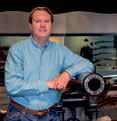







December 3 & 4, 2022
MK Shows presents the 35th annual Middle Tennessee Civil War Show and Sale at the Williamson County Ag Expo Park, 4215 Long Lane in Franklin. The nation’s largest Civil War show, featuring 750 tables of antique weapons, artifacts and memorabilia from top dealers and collectors around the country and encompassing all eras of military history from the Revolutionary War through World War II. Appraisers are always on hand to help you identify and value your military collectibles at no cost. Hours are 9-5 on Sat., 9-3 on Sun. Free Parking. Admission is only $10/ adults and children under 12 are free. For information visit www.MKShows.com (Scan Me) or Mike@MKShows.com.
The Largest Civil War Show Under One Roof!
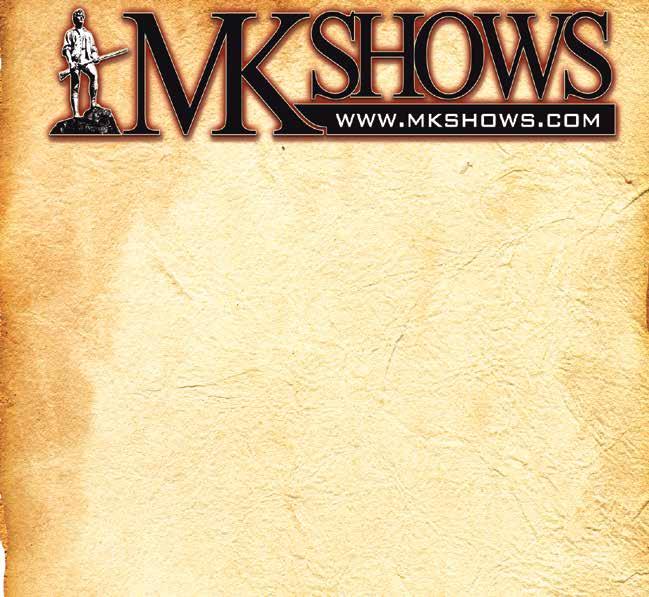

this year, as a museum quality privy digging display caught the eye of everyone walking by. The interest and time taken by diggers
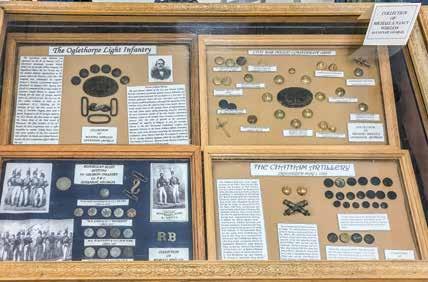
Robert Bohrn and Connie Legare

Brailsford to explain to the public what a privy dig in Charleston consisted of, and to do it in a way that the common visitor could






CHARLESTON IN THE WAR

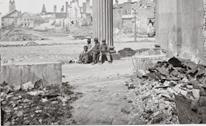
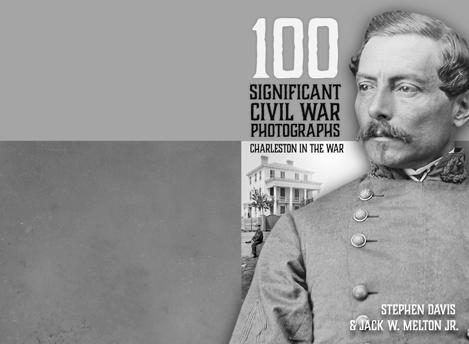


easily understand, complimented the artifacts.
Next year’s show, to be held at the same location, will return to the first weekend, Jan. 7 & 8, 2023. For info and table reservations, call American Digger magazine at 770-362-8671 or email anita@ americandigger.com.

25 March 2022 25 March 2022 CivilWarNews.com CivilWarNews.com
Historical Publications, LLC Civil War News • 800-777-1862 520 Folly Road, Suite 25 PMB 379 Charleston, SC 29412 www.CIVILWARNEWS.com UP-TO-DATE COVERAGE • PRESERVATION NEWS • BOOK REVIEWS SHOWS, LIVING HISTORY AND REENACTMENTS • HISTORICAL ARTICLES MONTHLY COLUMNS • CALENDAR OF EVENTS STAY INFORMED! Only $41.00/One Year • $71.00/ Two Years THE MONTHLY CURRENT EVENTS NEWSPAPER -FORCIVIL WAR ENTHUSIASTS SINCE 1974 12 ISSUES PER YEAR PRINT & DIGITAL EDITIONS AVAILABLE CALL OR SUBSCRIBE ONLINE TODAY! 2018 No. $3.50 America’s Monthly Newspaper For War Enthusiasts Never-Before Seen Scrapbook Sheds New Light—Provides Valuable Insights days call troops, governorsclare andmeet president’s volunteer Lincoln Troops Washington, peopleconcerned possibility Virginia southern sympathizers swoopingnap cabinet. never-before scrapbook by Rondout,secretary New Association, provides valuable intocrisis nation’scollection photos, correspondence, souvenirs by York collectionproximately patrioticon war. provides insights pivotal New regiments days acted initial secessioncompromise workedorganization the seriously. 1861, General Sandford, NYSM, eager confrontation wasearlier, 1861, Carolina to Fort Sumter the Military (NYMA) Major res olution After West the Fort back burn Lincoln other expedition. approachingCSA Charleston firesurrender of attitude. America’s Monthly Newspaper For Civil Legendary Sept.-voicesPost Bearssunderstanding History and Preservation Community Mourns: The Loss of Legendary Historian Edwin Cole Bearsspreservationwhichranch just Althoughspentafter recipientEd Bearss’ All Time Favorite Civil War Books(1886–1953), Va.,things. Expanded November Book Issue INSIDE EVERY ISSUE Mike Kent and Associates, LLC • PO Box 685 • Monroe, GA 30655 (770)
• Mike@MKShows.com • www.MKShows.com
Left: Mike Wheless presented this informative display of Confederaterelated items he dug in Savannah, Ga., including relics of local militia groups.
630-7296
100 Signi cant Civil War Photographs: Charleston in the War features newly restored images of scenes in the famed city, taken 1860–1865. e cameramen include the better-known, such as George N. Barnard and George S. Cook, as well as some lesser-known ones: Samuel Cooley, Charles Quinby, the partners Haas & Peale, Osborn & Durbec. Text by Stephen Davis and Jack Melton accompanies each featured photograph, describing the pictured scenes and the history surrounding them. e selected images depict a variety of settings: that portion of Charleston known as e Battery, the “Burnt District” (the area of the city destroyed by the Great Fire of December 1861), the Charleston Arsenal, and the many churches that allow Charlestonians to call theirs “the Holy City.” Special sections of this book are devoted to the huge Blakely guns imported from England by the Confederates and close-ups of Barnard’s views. e history of Civil War Charleston goes back to e Defense of Charleston Harbor (1890) by John Johnson, Confederate major of engineers, and to Reminiscences of Forts Sumter and Moultrie in 1860-’61 (1876) by Capt. Abner Doubleday, Federal second-in-command. Since then Charlestonians have contributed to the history of their city, notably Robert N. Rosen and Richard W. Hatcher III. e historical text surrounding 100 Signi cant Photographs draws on these and other works. A unique feature is its reliance upon the writings of actual participants, such as Augustine T. Smythe (1842–1914) and Emma Edwards Holmes (1838–1910). As a contribution to this literature, 100 Signi cant Civil War Photographs: Charleston in the War o ers rewards for all readers, from the casual novice to the serious student.
DAVIS & MELTON 100 SIGNIFICANT CIVIL WAR PHOTOGRAPHS CHARLESTON IN THE WAR 100 Signi cant Civil War Photographs: Charleston in the War features newly restored images of scenes in the famed city, taken 1860–1865. The cameramen include the better-known, such as George N. Barnard and George S. Cook, as well as some lesser-known ones: Samuel Cooley, Charles Quinby, the partners Haas & Peale, Osborn & Durbec. Text by Stephen Davis and Jack Melton accompanies each featured photograph, describing the pictured scenes and the history surrounding them. The selected images depict a variety of settings: that portion of Charleston known as The Battery, the “Burnt District” (the area of the city destroyed by the Great Fire of December 1861), the Charleston Arsenal, and the many churches that allow Charlestonians to call theirs “the Holy City.” Special sections of this book are devoted to the huge Blakely guns imported from England by the Confederates and close-ups of Barnard’s views. The history of Civil War Charleston goes back to The Defense of Charleston Harbor (1890) by John Johnson, Confederate major of engineers, and to Reminiscences of Forts Sumter and Moultrie in 1860-’61 (1876) by Capt. Abner Doubleday, Federal second-in-command. Since then Charlestonians have contributed to the history of their city, notably Robert N. Rosen and Richard W. Hatcher III. The historical text surrounding 100 Signi cant Photographs draws on these and other works. A unique feature is its reliance upon the writings of actual participants, such as Augustine T. Smythe (1842–1914) and Emma Edwards Holmes (1838–1910). As a contribution to this literature, 100 Signi cant Civil War Photographs: Charleston in the War o ers rewards for all readers, from the casual novice to the serious student. Stephen Davis JACK W. MELTON JR. CHARLESTON IN THE WAR 160 pages, Over 100 Photos, Maps, Index, Bibliography, Softcover. ISBN: 978-1-61850-167-7 $19.95 + 3.50 S&H Order online at www.HistoricalPubs.com or call 800-777-1862 Visit our new website at: HistoricalPublicationsLLC.com Ulysses S. Grant Portrayed by E.C. Fields Jr., Ph.D. HQ: generalgrantbyhimself.com E-Telegraph: curtfields@ generalgrantbyhimself.com Signal Corps: (901) 496-6065 Facebook@ Curt Fields
Four Years in Rebel Capitals

It’s not often that one catches Douglas Southall Freeman in an error, even a slight one. In The South to Posterity (1939), Dr. Freeman refers to Thomas Cooper DeLeon as “Tucker,” not Thomas; DeLeon preferred to be called Cooper, anyway. It doesn’t matter; Freeman included DeLeon’s masterful memoir, Four Years in Rebel Capitals, in his “Confederate Book Shelf.”
Because of DeLeon’s travels to New Orleans and Pensacola, E. Merton Coulter included Four Years in his Travels in the Confederate States: A

Bibliography (1948), noting that “writing years after the war, but from notes kept during the struggle, the author gave his account maturity of judgment, comprehensiveness, and perspective.” Ralph Newman and E. B. Long placed DeLeon’s Four Years in their essay, “The War in Books: A Basic Civil War Library” (1960). That redoubtable critic of Confederate letters, Richard M. Weaver (The Southern Tradition at Bay, 1968) esteemed DeLeon’s memoir as “not surpassed in its picture of life behind the lines.” Wiley, Robertson, and Nevins, in their Civil War Books: A Critical Bibliography (1969) pointed out that DeLeon’s opus “is one of the most frequently cited of Confederate studies.” Richard Barksdale Harwell’s In Tall Cotton (1978) also listed DeLeon, calling him “a good observer of Confederate life.” In The Civil War in Books: An Analytical Bibliography (1997), David Eicher noted that Four Years in Rebel Capitals, published in 1890 by the Gossip Publishing Company of Mobile, was reprinted in 1962 and 1983 (TIME-LIFE BOOKS’ “Collector’s Library of the Civil War”). Tom Broadfoot’s Civil War Books: A Priced Checklist
(1990) added that there was a second Mobile edition in 1892, as well as a more recent one in 1988. By this listing alone, DeLeon’s memoir ranks as a classic.


“Simple sketches of the inner life of ‘Rebeldom,’” is the way in which DeLeon described his memoir. Though published in 1890, the author stated that the reminiscence was written almost immediately after the war, “from notes and recollections” which decades later he revised and condensed. His hope, as he declared in a preface, “was to paint honestly the inner life of the South…a clear, unshaded outline of things as they were.”
DeLeon was a talented writer, as one sees from his very first pages. He was just twenty-one when the war began, the son of a prominent South Carolina physician and universityeducated. He was working in a Washington, D.C., engineering office when secession hurried him to Montgomery, Ala. There he began the notes and diary entries that he turned into this fascinating book, which is as alert as it is acerbic. At Montgomery he observed unctuous lobbyists and contractors seeking government work. Here’s how he described them: “by the hundred flocked hither those unclean birds, blinking bleared eyes at any chance bit, whetting foul bills to peck at carrion from the departmental sewer.”
DeLeon’s eyes were not only on the new administration. He described an Alabama riverboat race with the color and craft of Mark Twain; he chuckled through

Muggins’ and Spring Chicken’s night of drinking and gambling at Mobile in the facile style of the Southwest humorists in the 1840s and ‘50s. More, reading DeLeon is also like reading Sir Walter Scott. His style is a thing of yore, which makes it even more arresting. His words are so savory, I found myself almost reading them aloud. French and Latin phrases pop up like berries in a muffin. Along the way there’s lot of fun, too. Taking in DeLeon’s account of the Louisiana Zouaves’ train-theft and whisky riot in Montgomery is like watching a Mack Sennett comedy.
When the war started we see why Southern literary critic Richard Weaver esteemed DeLeon’s opus as “not surpassed in its picture of life behind the lines.”
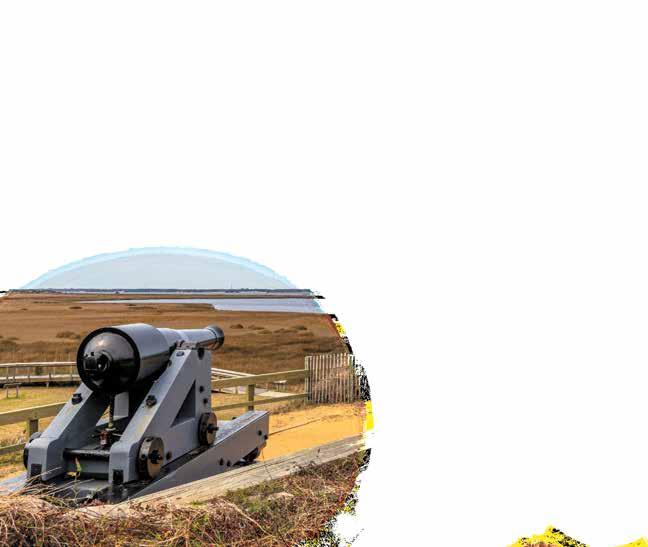
After joining the army, DeLeon was stationed in Richmond for much of the war; what service he performed is not clear. He hobnobbed with the cognoscenti sufficient for him to write about the course of the war, but in a rather general way. The fight at Blackburn’s Ford before Manassas, as one example, “is too well known history to be repeated here.” In addition, he comported himself as something of a military commentator; at one point he called the battle of Shiloh “the bloodiest of the war”; it was, up to that time.
Just as often he chose to record what he saw among the people around him. A fine example is his observation that, upon news of the Confederate victory at Bethel, women seemed to attribute the triumph more to “a higher Power than rested in a Springfield rifle, or a 12-pdr. howitzer.” As for God favoring the South, he heard this exchange outside the War Department:



“Don’t you tell me one word, cap’n!” I heard an old lady exclaim in great ire, at the door of the War Department, “Provi-dence is a-fightin’ our battles for us! The Lord is with us, and thar’s his handwritin’—just as plain!”
“Don’t say nothin’ agin’ that, marm,” answered the western captain, with Cromwellian sagacity; “but ef we don’t help Providence powerful hard we ain’t agoin’ ter win!”

Of literary gems there are aplenty (you can tell I’m picking up on DeLeon’s ornate style here), such as the breathless anticipation in Richmond the night following the battle at Manassas:
There was no sleep in Richmond that night. Men and women gathered in knots and huddled into groups on the corners and doorsteps,
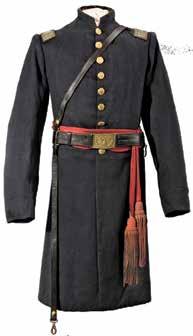
26 CivilWarNews.com March 2022 26 March 2022 CivilWarNews.com Contact Mike at: 910-617-0333 • mike@admci.com Provenance a Must! Fort Fisher items wanted
and the black shadow of some dreadful calamity seemed brooding over every rooftree. Each splashed and wearylooking man was stopped and surrounded by crowds, who poured varied and anxious questioning upon him. The weak treble of gray-haired old men besought news of son, or grandson; and on the edge of every group, pale, beseeching faces mutely pleaded with sad, tearless eyes, for tidings of brother, husband, or lover.
This verbal mellifluosity flows throughout Four Years till we finally come to General Lee’s return to Richmond after the surrender.
Next morning a small group of horsemen appeared on the further side of the pontoons. By some strange intuition, it was known that General Lee was among them, and a crowd collected all along the route he would take, silent and bareheaded. There was no excitement, no hurrahing; but, as the great chief passed, a deep, loving murmur, greater than these, rose from the very hearts of the crowd. Taking off his hat and simply bowing his head, the man great in adversity passed silently to his own door; it closed upon him, and his people had seen him for the last time in his battle harness.
We don’t know how DeLeon’s position in Richmond gave him the capability of “being in the numerous camps that winter” of Joe Johnston’s Army of the Potomac. “Universal slouch and depression” he observed among the troops all around in the months before the spring campaign of ’62. Among other roles, the author of Four Years could be a champion for the Old South’s ideal of gentleman. DeLeon makes this clear by his description of aristocratic Marylanders now in the army’s encampment, displaying soldierly grit with the best backwoodsman or yeoman farmer:
But here were gentlemen born—men of worth and wealth, education and fashion—delving side by side with the veriest drudge; fighting as only gentlemen can fight, and then working as gentlemen never worked before!
Delicately bred youths who had never known
rougher work than the deux temps, now trudged through blinding snows on post, or slept in blankets stiff with freezing mud; hands that had felt nothing harder than billiard-cue or cricket-bat now wielded ax and shovel as men never wielded them for ages; the epicure of the club mixed a steaming stew of rank bacon and moldy hard-tack and then—ate it!
And all this they did without a murmur, showing an example of steadfast resolution and unyielding pluck to the hardier and tougher soldiers by them; writing on the darkest page of history the clear axiom: Bon sang ne peut mentir!
DeLeon did not refrain from using phrases in Latin or French, as above, “good seed makes a good crop,” and frequently quoted poetry that is unfamiliar to modern eyes. This might seem as if the author were showing off his education and upbringing; but at the same time he clearly enjoyed telling a yarn or two, such as this one about a column of marching infantry:
Passing one house, a pale, boyish-looking youth was noted at a window with a lady. Both waved handkerchiefs energetically; and the men answered with a yell. But the opportunity was too good to lose.
“Come right along, sonny! The lady’ll spare yer! Here’s a little muskit fur ye!”
“All right, boys!” cheerily responded the youth, rising from his seat—”Have you got a leg for me, too?” And Colonel F. stuck the shortest of stumps on the window-sill.
With one impulse the battalion halted; faced to the window, and spontaneously came to “Present!” as the ringing rebel yell rattled the windows of that block. The chord had been touched that the roughest soldier ever felt!
But back to Dr. Weaver’s judgment (“not surpassed in its picture of life behind the lines”) as one reads in Chapter 18, a good part of which is filled with observations on Richmond’s social season in the winter of ’61’62. Despite the stresses of war, many held that parties were still proper and not even unpatriotic, while sterner sorts, “behind their abatis of knitting needles,” held that staying home and sewing for the soldiers was the only right recreation. DeLeon wrote approvingly of those stern old
ladies that “behind the chevaux de frise of clashing knittingneedles,” they would willingly welcome a well-bred stranger into their society.
During this time Mrs. Davis opened the Executive Mansion every evening in informal receptions for all visitors. While the First Lady “discussed the latest book…or talked knowingly of the…newest opera,” the President himself said little (one may guess that DeLeon attended a few of these soirees) and after an hour or so in pleasant company, he retired to his study to work a bit more. The author was aware that during the war Jeff Davis had come in for his share of criticism from Southerners. Thus his accolades to the Confederate president stand out, as does this description of Davis delivering his inaugural address at Richmond in February 1862:
There was a depth in the hearts of his hearers that discontent could not touch:—that even discontent had not chilled. They saw in him the representative man of their choice—headstrong certainly, erring possibly. But they saw also the staunch, inflexible champion of the South, with iron will, active intellect, and honest heart bent steadily and unwearyingly to one purpose; and that purpose the meanest one among them clasped to his heart of hearts!
Thirty years after the war, Cooper DeLeon shared lots of traits with wartime Confederate newspaper editors. One of them was the goal of vilifying the enemy. There was no better enemy to vilify than Union Maj. Gen. Benjamin F. Butler. He had earned the nickname “Beast” for his heavy-handed administration of Union-occupied New Orleans. Confederate editorialists at the time hurled huge invective at Butler. Their vicious calumnies, though, are matched thirty years later by DeLeon’s: “the annals of the war are not free from small pilferers and vicious imbeciles; but high above the tableau they form, this warrior has perched himself upon a pinnacle—let us hope—unattainable again!”
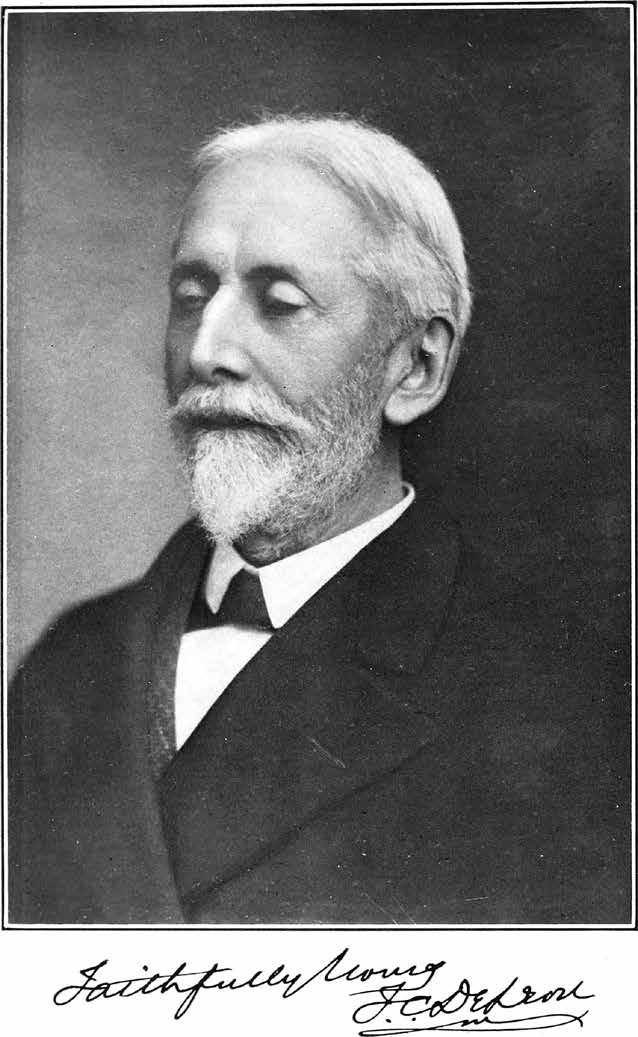
DeLeon assumes the Southern reader’s familiarity with Butler’s “woman order” so much that he does not describe or even name it, though he spends a half-page excoriating its author.
Chapter XXI, “Conscription and Its Consequences,” reminds us that for his memoir DeLeon was working from his wartime notes.
His criticisms of the Confederate conscription system, especially its substitute provision, read like the bitter anti-administration screeds one sees in Edmund Ruffin’s wartime editorials in the Richmond Examiner. Yet DeLeon approved of the government’s need to call for more men to serve. When Congress extended the conscriptable ages, calling for lads from 16 to 18, and older men 45 and up, DeLeon hailed the idea of old men fighting alongside young lads: “But the infantile and moribund murmured not, and more than once a raid was turned and a sharp skirmish won, when the withered cheek of the octogenarian was next to the rosy face of the beardless stripling!”
Cooper DeLeon would not have been a stout Confederate apologist if he did not rhapsodize over the selfless and devoted patriotism of Southern women.
Describing the countless wounded after Seven Pines who overflowed Richmond hospitals into tobacco warehouses and private homes, he attested that over many a soldier’s cot “a still, patient form, almost motionless, waved the ceaseless fan or breathed the low promise of the
Living Word.”
Then came the Seven Days, which DeLeon, a Richmonder, pays especial attention to. One looking for the crisp military narrative of a Liddell Hart or John Keegan won’t find it here, as in this fleeting summation of Gaines’ Mill: “Still on the barefooted boys press with resistless rush, leaving dead or mangled brothers and writhing foemen in their gory track!” His brief recounting of military events—Shiloh, Sharpsburg, Murfreesboro, Fredericksburg, Chancellorsville, et al.—dance lightly through his pages, while leavening is to be found in his delightful chapters on Confederate newspapers, literature, and even humor.
After hailing Southern gallantry at Gettysburg—Pickett’s Charge was “unequaled in history”— like many Confederates, DeLeon paused to ask why Lee had entered battle “on ground of the enemy’s choosing,” then attacked when he could have flanked. The wartime writer was asking questions that historians are still kicking around today.
Even as the Confederacy was going up the spout, our journalist retained his fervor
27 March 2022 27 March 2022 CivilWarNews.com CivilWarNews.com
Thomas Cooper DeLeon. From the book Belles, beaux and brains of the 60’s. DeLeon lost his sight shortly after the turn of the century. He died on March 19, 1914 in Mobile.
and his eloquence. Dahlgren’s raid, for instance, “remains a blot even upon the page of this uncivilized warfare.” DeLeon is not above criticizing Confederate naval “policy”—Congress stinted appropriations that could have speeded completion of the Virginia; not enough emphasis was placed on privateers, even after the early successes of Semmes’ Sumter; and too much money and labor were spent on building flimsy river gunboats, or “frail wooden shells.” Through it all, however, dutifully and heroically Southern sailors held their posts, “at the bitter ending no man nor woman in the broad South but believed they had done their devoir—honestly— manfully—well!”
In his chapter “The Failure in Finance,” DeLeon makes the argument that at the start of the war, the government could have on faith bought up the year’s cotton crop, promptly shipped and sold it in Europe, accrued a treasury for purchasing supplies and for repayment in coin of bondholders, thus circulating specie in the economy. The argument is not new, of course, but in DeLeon’s telling of how cotton, “auriferous in every fiber,” could indeed have been king, it becomes more persuasive than ever.
By the way, Second Manassas, Sharpsburg, Fredericksburg, and Chancellorsville are related in just ten pages, far fewer than are given to the author’s consideration of the Confederate economy. This is just what you’d expect from a civilian living in a crowded city beset by food shortages, inflationary spiral, and hoarding speculators.
Our author, of course, knew well the ultimate outcome of Grant’s contest with Lee in the spring campaign of 1864. This does not prevent him from adding sly licks to his narrative of it. Grant is derided as nothing but “a pertinacious fighter,”
far from deserving a title such as strategist, much less great soldier. His fighting from the Wilderness to Cold Harbor is termed a “disastrous series of blunders” in which he lost seven men to every one of Lee’s.
DeLeon has some fun with Butler’s ancillary campaign that Grant ordered while he toughed it out with Lee. Butler, preparing to ascend the James, is equipped with “a fleet of iron-clads, doubleenders, gunboats and transports sufficient for a war with England,” and still fails. “Grant’s civilized warfare,” shelling Petersburg’s helpless civilians, fails utterly to deter loyal Southern women from their quiet labors in support of the soldiery. Later, the depredations of Sheridan’s “barn-burning and railroad-tearing cavalry” are likewise belittled as ineffective in turning the people against the cause.
In that other vital contest, the one in Georgia, both Johnston and, surprisingly, Sherman are given high marks, the former for prudently husbanding his strength while giving up ground, the latter for not wasting his manpower in Grant-like assaults. DeLeon thus criticizes the government’s removal of Johnston outside Atlanta “for wholly inexplicable reasons,” as he puts it. As for Hood’s failure to hold Atlanta, the author complains that in his campaign report “neither his theories nor their carrying out are made comprehensible to the public.”
Cooper DeLeon was in Richmond when it fell; he writes touchingly of saying goodbye to a friend who apparently did not survive the last days of the war. Hence we are to value all the more his telling of the Union occupation. He writes movingly how, after the Federals opened their commissary to the hungry and needy, Richmond’s ladies swallowed their reluctance to accept charity from their conquerors, and “received small
Civil War Artillery Book
392 page, full-color book, Civil War Artillery Projectiles – The Half Shell Book. For more information and how to order visit the website www. ArtillerymanMagazine.com or call 800-777-1862.
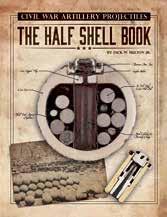
$89.95 + $8 media mail for the standard edition.
rations of cornmeal and codfish; bearing them home to be eaten with what bitter seasoning they might of tears from pain and humiliation.”
Such was the war and its outcome. Like Father Ryan, Cooper DeLeon was prepared to furl and bury that conquered banner, but not before hailing it one last time:
But is that proud flag— with the glory and the pride wrought into its folds, by suffering, honor and endurance unexcelled— really “furled forever?” The dust of centuries may sift upon it, but the moth and the mold may harm it not. Ages it may lie, furled and unnoted; but in her good time, historic Justice shall yet unfold and throw it to the breeze of immortality; pointing to each glorious rent and to each holy drop that stains it!
It is because of such soaring prose as this that Dr. Weaver deems DeLeon “a literary artist.” He was a Rebel, and proud of it, even in defeat. David Eicher commented on Four Years in Rebel Capitals, “highly partisan and at times bitter, the account nevertheless manages to convey a good deal of information.” This assessment, I think, misses the mark, for it is DeLeon’s
Confederate partisanship and Southern pride (I don’t see “bitterness”) that makes DeLeon’s memoir notable in the first place—an erudite, polished, and entertaining look back on how ex-Rebels could still view their fight as noble, even in failure. When today the entire Confederate experience is being dismissed in one or two slurs, getting at the thoughts and feelings of an intelligent, educated Southerner a generation after the war is more than time travel; it’s a cultural encounter.

Stephen Davis of Cumming, Georgia, is author of seven books
related to the Atlanta Campaign, including the Emerging Civil War paperbacks A Long and Bloody Task (2016) and All the Fighting They Want (2017). His two recent volumes on John Bell Hood (Mercer University Press, 2019, 2020) have won the Fletcher Pratt Award of the New York CWRT, the Richard Barksdale Harwell Award of the Atlanta CWRT, and the Douglas Southall Freeman Award of the Military Order of the Stars and Bars. His latest book, with Bill Hendrick, The Atlanta Daily Intelligencer Covers the Civil War, will be released this summer by the University of Tennessee Press.
GENERAL BARTON & STOVALL HISTORY/HERITAGE ASSOCIATION
40TH, 41ST, 42ND, 43RD & 52ND GEORGIA INFANTRY REGIMENTS GEORGIA INFANTRY BRIGADE

Join one of the premier descendant-based Civil War groups in America.
Reunion Congress held in Franklin, Tenn. May 12-14, 2022
Now entering our 21st year.
Information at www.generalbartonandstovall.com
28 CivilWarNews.com March 2022 28 March 2022 CivilWarNews.com
John S. Mosby on Slavery and the Civil War
Letter from John S. Mosby to Samuel Chapman, 1907
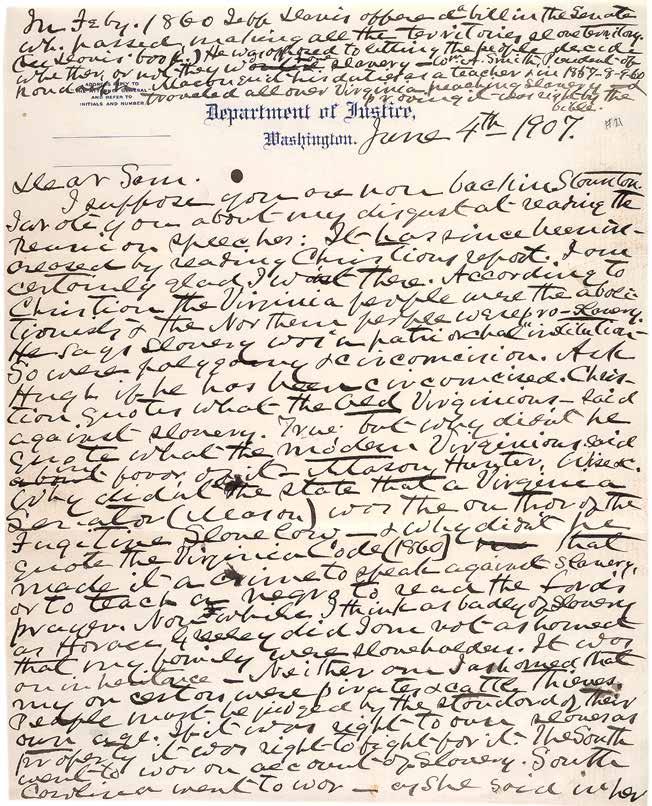
“Washington, D.C., June 4, 1907.
Dear Sam:
I suppose you are now back in Staunton. I wrote you about my disgust at reading the Reunion speeches: It has since been increased by reading Christians report. I am certainly glad I wasn’t there. According to Christian the Virginia people were the abolitionists & the Northern people were pro-slavery. He says slavery was “a patriarchal” institution – So were polygamy & circumcision. Ask Hugh if he has been circumcised. Christian quotes what the Old Virginians – said against slavery. True; but why didn’t he quote what the modern Virginians said [struck: about] [inserted: in] favor of it – Mason, Hunter, Wise &c. Why didn’t [struck: t] he state that a Virginia Senator (Mason) was the author of the Fugitive Slave law – & why didn’t he quote The Virginia Code (1860) [strikeout] that made it a crime to speak against slavery, or to teach a negro to read the Lord’s prayer. Now while I think as badly of slavery as Horace Greeley did I am not ashamed that my family were slaveholders. It was our inheritance –Neither am I ashamed that my ancestors were pirates & cattle thieves. People must be judged by the standard of their own age. If it was right to own slaves as property it was right to fight for it. The South went to war on account of slavery. South Carolina went to war – as she said in her [2] Secession proclamation – because slavery wd. [sic: would] not be secure under Lincoln. South Carolina ought to know what was the cause for her seceding. The truth is the modern Virginians departed from the teachings of the Father’s. John C. Calhoun’s last speech had a bitter attack on Mr Jefferson for his amendment to the Ordinance of `87 prohibiting slavery in the Northwest Territory. [struck: Jo.]
Calhoun was in a dying condition – was too weak to read it – So James M. Mason, a Virginia Senator, read it in the Senate about two weeks before Calhoun’s death – Mch. 1850. Mason & Hunter not only voted against The admission of California (1850) as a free state but offered a protest against [inserted: it] wh. the Senate refused to record on its Journal Nor in the Convention wh. Gen. Taylor had called to form a Constitution for California, there were 52 Northern & 50 Southern men – but it was unanimous against slavery – But the Virginia Senator, with Ron Tucker & Co. were opposed to giving [inserted: local] selfgovernment to California. Ask Sam Yost to give Christian a skinning. I am not strikeout ashamed of having fought on the side of slavery – a soldier fights for his country – right or wrong – he is not responsible for the political merits of the course he fights in.
Yours Truly
The South was my country. Jno: S. Mosby
[written across the top of page 1]
In Feby. 1860 Jeff Davis offered [inserted: a] bill in the Senate wh. passed, making all the territories slave territory. (see Davis’ book.) He was opposed to letting the people decide whether or not they w[struck: ould] [inserted: d have] slavery – Wm. A. Smith, President of Randolph Macon quit his duties as a teacher & in 1857-8-9-60 traveled all over Virginia preaching slavery & proving it was right by the bible.
[envelope]
Captain Sam Chapman Staunton Virginia
[verso]
Senator Jas. M. Mason was the author of the Fugitive Slave Law of 1850; but the Ordinance 1787 for the government of the Northwestern Territory, contained in its amended form, as passed, the fugitive slave provision.”
See Benton’s Thirty Years, p 133.
Notes: Written on Department of Justice stationery. Christian is George Christian. The Davis book could be one of many Jefferson Davis authored.
Source: Gilder Lehrman Collection, GLC03921.21.
Col. John Singleton Mosby (Dec. 6, 1833 – May 30, 1916).
(Library of Congress)
Mosby, also known by his nickname, the “Gray Ghost”, was a Confederate army cavalry battalion commander. His command, the 43rd Battalion, Virginia Cavalry, known as Mosby’s Rangers or Mosby’s Raiders, was a partisan ranger unit noted for its lightningquick raids and its ability to elude Union Army pursuers and disappear, blending in with local farmers and townsmen.
Courtesy Gilder Lehrman Collection, GLC03921.21.
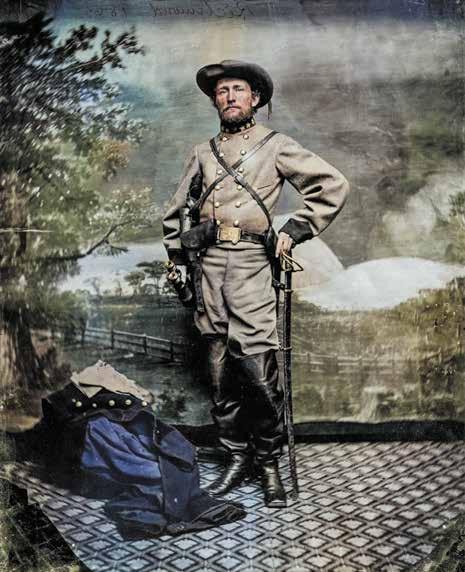
29 March 2022 29 March 2022 CivilWarNews.com CivilWarNews.com
William Sartain’s Civil War
The Graphic War highlights prints and printmakers from the Civil War discussing their meaning and the print maker or artist’s goals.
Perhaps one of the most important groups of 19th Century printmakers was the Sartain family of Philadelphia.
The tragic narrative of the Civil War provided them with ample opportunities to practice their art and craft of engraving. No subject escaped their purview. After the war, they ramped up their catalog of famous Americans; north and south, it didn’t matter.
According to the Library Company of Philadelphia, the Sartain dynasty began with John Sartain (1808–1897) whose life spanned the 19th century. He immigrated to the United

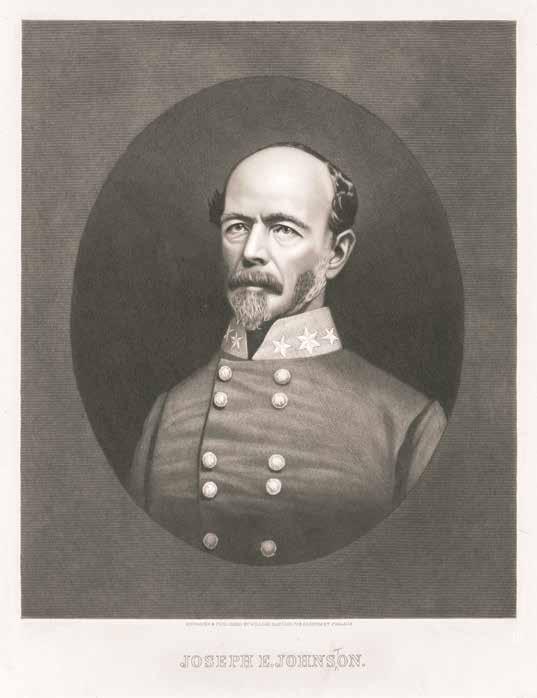
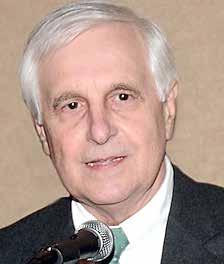
States in 1830 at the age of 22. He was apprenticed with several seasoned artists as he worked in oil and made ivory miniatures. He also dabbled in engraving bank notes and wood cuts for book illustrations. Within ten years he was working in an old tradition of print making; the mezzotint, a method of highlighting dark and light tones dating to the early 17th century.
The technique, using black ink and the absence of it, produces
luxurious light and dark, silky tones. It was suited to portraits and the entire Sartain family, at one time or other adopted the practice to produce many stunning portraits of famous Americans, living and dead. Sartain became known as a foremost printmaker “receiving prestigious commissions for engraving large prints and illustrations for magazines and books. His artistic children and grandchildren included printmakers Samuel, Emily, and William; printer Henry; painters William, Emily, and Harriet; and art educators Emily and Harriet.”1
Sons William (1843–1924) and Samuel (1830–1906) Sartain fashioned the many portraits most familiar to Civil War students. Both studied under father John, who also produced war hero portraits. William was born in Philadelphia and worked with his father until he was 24. “From 1867 to 1868, he studied under Christian Schussele and at the Pennsylvania Academy. He then went to Paris, where he studied with Leon Bonnat. In 1877, he returned to the United States, settling in New York, where he was elected an associate of the
National Academy of Design in 1880. He was one of the founders of the Society of American Artists. He painted both landscape and figure subjects.”2
Both Samuel and William etched Sherman, but several years apart. William also produced portraits of Lincoln, Andrew Jackson, Joseph Johnston, earlier heroes General Edward Braddock and General Thomas Gage, and most of the presidents from Washington to Grant. Samuel left his father’s patronage at age 21 and went into business for himself. The other siblings enjoyed artistic prominence in varying degrees.
Ironically few, if any of either Sartains’ subjects sat for their likenesses. Instead, the artists depended on the new-fangled photographic process to produce their portraits. According to the Old Print Shop in New York, following the war, William “executed a series of mezzotint portraits of prominent war heroes which were intended to be sold to both a northern and southern market.” Beauregard’s likeness “is a superb example of this spectacular series, and showcases Sartain’s extraordinary skill as
30 CivilWarNews.com March 2022 30 March 2022 CivilWarNews.com
Joseph E. Johnston, 1868–1890. Engraving by William Sartain (mislabeled “Joseph E. Johnson.”). (Library of Congress)
Ulysses S. Grant ,1822–1885, 1866 engraved by William Sartain. (Library of Congress)
an engraver.….William was known for his emotive landscape paintings, but he was also a skilled engraver, and this series of portraits is considered some of his finest work.”3 As historians Harold Holzer, Mark Neely, and Gabor Borritt, point out, “although William served in the Union army, Sartain now portrayed his erstwhile enemies in a series of superb postwar mezzotints whose subjects included Lee, Jackson, Beauregard, and Davis.”4
Possibly the most jarring and provocative, patriotic mezzotint William produced was Young America, ca 1864. Subtitled, Crushing Rebellion and Sedition, the print is a “symbolic vision of the North’s defeat of the Confederacy.” According to the collection notes from the Library of Congress: “Young America or the Union is shown as the infant Hercules strangling two serpents representing rebellion

and sedition. According to Greek mythology the serpents were sent by the goddess Hera, who was jealous because during one of his many liaisons her husband Zeus had fathered Hercules. The snakes portrayed here probably also allude to antiwar Democrats …‘Copperheads.’ The infant reclines on his customary lion’s skin on a large rock. Above him perches an eagle, symbol of both Zeus and American might.”5 One can’t imagine a more striking image of America’s tragic era.
William Sartain passed away in Philadelphia, October 18, 1924.6
Endnotes:
1. Library Company of Philadelphia.
2. “John Sartain” Appleton’s Cyclopedia of American Biography, 1900, Wilson and Fiske. As cited in John Sartain (1808-1897) http:// americanartgallery.org/artist/ readmore/id/482.

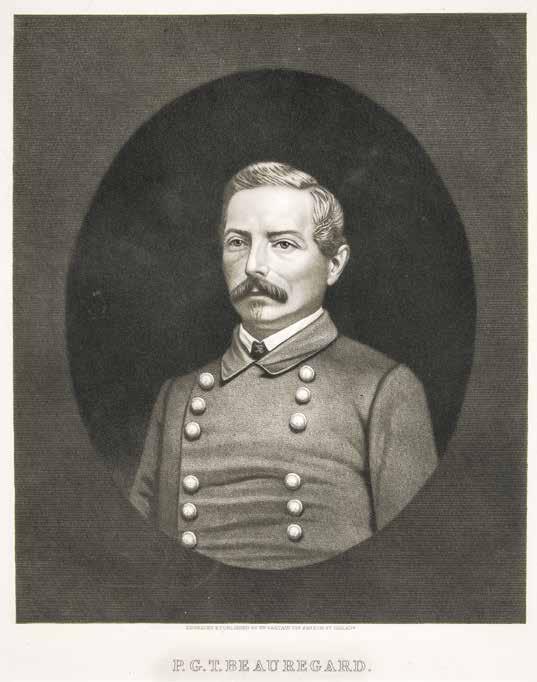
3. The Old Print Shop, New York.
4. Holzer, et, al., The Confederate Image, Prints of the Lost Cause, Chapel Hill, University of North Carolina Press, 1987, 101.
5. Collection notes, Library of Congress, https://www.loc.gov/ item/2003689254/.
6. Sartain obituary, The Philadelphia Inquirer, October 24, 1924.
After 43 years in the museum field, Cilella devotes his time collecting American prints and maps and writing. His last professional position was President and CEO of the Atlanta History Center. His most recent books are Upton’s Regulars: A History of the 121st New York Volunteers in the Civil War (U. Press Kansas, 2009). His twovolume Correspondence of Major General Emory Upton, (U. of Tennessee Press, 2017), received the 2017–2018 American Civil War Museum’s Founders Award for outstanding editing of primary source materials. His latest book “Till Death Do Us Part,” an edit of Upton’s letters to his wife 1868–70, was published in 2020 by the Oklahoma University Press.
Featuring Presentations by:
Jonathan A. Noyalas (Shenandoah University)
Lauren K. Thompson (McKendree University)
Kathryn J. Shively (Virginia Commonwealth University)
Jonathan W. White (Christopher Newport University)
Registration fee: $30 includes all sessions & lunch
Additional
31 March 2022 31 March 2022 CivilWarNews.com CivilWarNews.com Deadlines for Advertising or Editorial Submissions is the 20th of each month. Email to ads@civilwarnews.com
P. G. T. Beauregard, 1818–1893. Engraving by William Sartain, ca. 1868. (Library of Congress)
the Mere Routine of Everyday Life” Encounters & Experiences during the Civil War McCormick Civil War Institute 2022 Spring Conference Saturday April 2, 2022 9 a.m. – 4 p.m. To register: su.edu/MCWI
“Beyond
Jonathan Noyalas, jnoyalas01@su.edu
Visit our new website at: HistoricalPublicationsLLC.com
Questions: Contact MCWI's director
or 540-665-4501
Young America: Crushing Rebellion and Sedition, ca. 1864, by William Sartain. (Library of Congress)
From the Editor

During the Sesquicentennial, one major theme the National Park Service touted was “From Civil War to Civil Rights.” It seemed an odd choice at the time, designed not to focus on the war but rather shift focus away from it toward a narrative that stretched forward toward some vague spot in the 1960s. The lack of any concerted national effort to promote the Sesquicentennial doomed that broad vision, and everyone seemed to shake hands at Appomattox and go home, facsimile parole passes in hand.
The shame is that there is a clear path from Civil War to Civil Rights—one that largely went unexplored by the NPS in the Sesquicentennial, despite the catchy slogan.
Over the last ten years, I’ve spent time on my own exploring that link, and I’ve done it primarily by taking advantage of
the “power of place.” When I’m out on a battlefield trip or visiting a roundtable for a talk, I look for opportunities to make that journey from Civil War to Civil Rights by finding sites that let me explore it on my own terms.
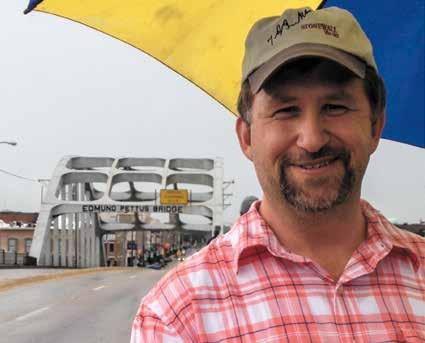
Battlefields served as my first, and still are my main, connection with Civil War history. Landscapes move me; place inspires me. Standing in the footsteps of those who came before us gives me, gives all of us, a perspective we can’t get in any other way. This is the first step to understanding and empathy and insight.
Inspired by these adventures over the years, I’m teaching a class this semester called “The Media and the Civil Rights Movement.” I’m sure some people will shake their heads and grumble about “one more woke college professor,” but my motivation for teaching the class springs from my visits to these historic places and the inspiration I’ve walked away with. It’s my first time teaching the class, which I’ll use an opportunity to indulge my curiosity even further, right alongside my students. No doubt, we can carry the thread of history from the Civil War to Civil Rights, a thread that doesn’t stop in the 1960s. We study the past to better understand the present. What can the lessons from both those eras, and the connection between them, teach us about today?
—Chris Mackowski, Ph.D. Editor-in-Chief, Emerging Civil War
One Simple Thing You Can Do to Help ECW
One simple thing you can do to help Emerging Civil War is to share the ECW newsletter with your Civil War-minded friends. Encourage them to subscribe. As our supporters, readers, and fans, you’re our best sales tool, and your endorsement can go a long way to helping us spread the word as we continue to “share the gospel of the Civil War.” Thank you!
ECW News and Notes
From Edward Alexander: “I’m finishing up a few cartography projects, including maps of the Charleston, South Carolina, area for both the Emerging Civil War and Emerging Revolutionary War Series. I also recently took on a much more modern project and anticipate seeing two maps in Lt. Col. David Kelly’s (Ret.) Hell in the Streets of Husaybah: The April 2004 Fights of 3rd Battalion, 7th Marines in Husaybah, Iraq published within the month.”
Sarah Kay Bierle has been trying to do some winter hiking between snow and ice storms in Virginia. She was excited to bushwhack to the 114th Pennsylvania Monument at Chancellorsville Battlefield and explore other areas around Hazel Grove.
Sheritta Bitikofer gave her first-ever Civil War Roundtable talk this month about the last slave ship, the Clotilda, which smuggled 110 Africans from the Bight of Benin to Mobile, Alabama, in the summer of 1860. The presentation was well attended, including a descendent of one of the Africans from the Clotilda, there to represent the Clotilda Descendants Association and share about their efforts to preserve their heritage in Africatown, just outside of Mobile.
Neil Chatelain just had an article titled “Creuzbaur’s Revolutionary Confederate Ironclad Avenger” published in Civil War Navy–The Magazine’s winter 2022 issue, examining recently uncovered schematics of an innovative prototype ironclad design.
Bert Dunkerly and Doug Crenshaw continue to hike the more obscure areas of the Richmond battlefields, always looking for something new.
From Meg Groeling: Meg is doing fine, thank you. She is getting her hair back, although it is beginning to look a bit Edmond Ruffin-ish. She is trying to catch up on all her obligations and is constantly working on improving her “off the cuff” speechifying for Zoom and Facebook. She is also becoming adept at wrapping books for the mail and setting up PayPal payments, so if you haven’t bought your copy of First Fallen yet, do so! It is essential, you know, to all Civil War buffs and fans in general, that a copy of FF be in every household. Ahem.
Meg also received a highly complementary review of First Fallen in the Wall Street Journal by Hal Holzer on December 29, 2021. Holzer called the book a “straightforward, deeply research biography” and a “vivid inquiry in [Ellsworth’s] star appeal.”
Guy Hasegawa’s Matchless Organization: The Confederate Army Medical Department, part of ECW’s Engaging the Civil War Series from Southern Illinois University Press, received a favorable review from John Michael Priest in the February 2022 issue of Civil War News. “Matchless Organization is, as of now, the definitive study of the Confederate Army Medical Organization, but also provides an explanation of how the Confederacy destroyed itself,” Priest says.
Chris Kolakowski reviewed Strategies of North and South: A Comparative Analysis of
the Union and Confederate Campaigns by Gerald L. Earley for the February 2022 issue of Civil War News. Chris called the book “an interesting work” that offered thought-provoking analysis, but “the book’s limitations impact its usefulness.”
Derek Maxfield was pleased to learn that his first book, Hellmira: The Union’s Most Infamous Civil War Prison Camp – Elmira, NY, has now been made available in a second edition. On February 17 at 7 p.m., Derek will present his book at the Dundee Library, in his hometown of Dundee, N.Y. The event is co-sponsored by the library and Dundee Area Historical Society. On March 9, Derek and his wife, Jess, will perform their one-act play, “Grant on the Eve of Victory,” for the Cleveland Civil War Round Table at 7 p.m. at the Holiday Inn Cleveland-S Independence.
On Dec. 19, Ryan Quint attended the yearly peace ceremony at the Dranesville Church of the Brethren. This year, they asked that he say a few words, which he copied in a blog post. A new sign was also dedicated to commemorate the battle and the lives lost there. “Continuing on the theme of Dranesville,” Ryan says, “I gave a talk to the Bull Run Civil War Round Table on January 13. The rising cases of Omicron forced it to be a virtual presentation, but the turnout was good and the audience questions even greater.”
Brian Swartz spoke about Joshua Chamberlain and Passing Through the Fire at the January 13, 2022, meeting of the Joshua L. Chamberlain Civil War Round Table. Around 35 people attended the meeting, held in the Curtis Memorial Library in Brunswick, Maine.
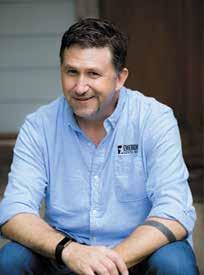
Congratulations to Dan Welch, who has been selected as the new associate editor of Gettysburg Magazine, published by the University of Nebraska. In making the announcement, the Press said: “An experienced seasonal Park Ranger at Gettysburg National Military Park, Dan has a vast knowledge of the park & its history [which he has] contributed to many #CivilWar publications (like Emerging Civil War).”
Kris White wrote an article for the winter 2021 issue of Hallowed Ground magazine, “Oceans Rise, Empires Fall: How the American Revolution Became a Global War.”

ECW Comes to Pittsburgh!
When one ECW symposium just isn’t enough, we have you
32 CivilWarNews.com March 2022 32 March 2022 CivilWarNews.com www.emergingcivilwar.com
Chris Mackowski
Chris Mackowski stands on the Edmund Pettus Bridge on the road out of Selma, Ala. Hallowed Ground features a piece by Kris White.
covered, but only if you act quickly! Only 30 seats remain available for the upcoming Civil War Symposium at The Andrew Carnegie Free Library & Music Hall and the Captain Thomas Espy Post in Carnegie, Pennsylvania, on Saturday, April 9, 2022.
The symposium will feature five historians from Emerging Civil War highlighting several key themes of the second year of the Civil War. The symposium will examine how the events of 1862 impacted a soldier’s experience, including the battles that scarred them, the medicine that healed them, and the words that freed them.

Presentations Include:
✦ Drew A. Gruber – “The Civil War on the Virginia Peninsula in 1862”
✦ Dan Welch – “Abraham Lincoln & The Emancipation Proclamation”
✦ Paige Gibbons Backus –“Dr. Jonathan Letterman’s Plan that Changed Military Medicine”

✦ Chris Mackowski – “Simply Murder: The Battle of Fredericksburg, Virginia”
✦ Kristopher D. White – “The Battle of Gaines’ Mill, Virginia”
In addition to the speakers, attendees will have the opportunity to tour the Captain Thomas Espy Post, a national treasure considered the most intact surviving Grand Army of the Republic Post, as well as the Lincoln Gallery, an impressive display of 100 prints of Abraham Lincoln captured between 1847–1865. There will also be an expansive Civil War book sale and raffles throughout the day. A limited number of tickets are available at the regular price of $60, which includes the five lectures and a boxed lunch. Tickets may be purchased at Andrew Carnegie Free Library & Music Hall.
ECW Bookshelf
We have two new ECWaffiliated books to highlight this month!
On May 24, 1861, Col. Elmer Ellsworth became the first Union officer killed in the Civil War. The entire North was aghast. First Fallen is the first modern biography of this national celebrity, Northern icon, and mostly forgotten Union hero.
Meg Groeling’s well-written biography is grounded in years of archival research and includes diaries, personal letters, newspapers, and many other
accounts. In the six decades since the last portrait of Ellsworth was written, new information has been found that gives readers and historians a better understanding of the Ellsworth phenomenon and his deep connections to the Lincoln family.
First Fallen: The Life of Colonel Elmer Ellsworth, the North’s First Civil War Hero examines every facet of Ellsworth’s complex, fascinating life and adds richly to the historiography of the Civil War.

Second Manassas Campaign. As Michael Block’s The Carnage Was Fearful: The Battle of Cedar Mountain, August 9, 1862, argues, the stand-alone battle had major implications. Part of the Emerging Civil War Series!
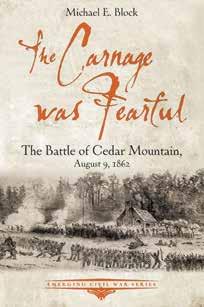
10 Questions . . . with Mike Block
Mike Block is the author of the newest Emerging Civil War Series volume, The Carnage Was Fearful: The Battle of Cedar Mountain. Mike serves as the vice-president of the Friends of Cedar Mountain Battlefield. As a public historian, he gives battlefield tours and lectures, focusing on the stirring wartime events in Culpeper County, including Cedar Mountain. Retiring from the United States Air Force in 2001, he continues supporting the U.S. Government as a consultant.
I left the BSF in early 2012. Within a month, the Friends of Cedar Mountain Battlefield reached out and asked me to join their board and serve as a public historian. Remember, 2012 was the sesquicentennial of the battle. I had a very steep learning curve, indeed! Once on board, I realized that other than Robert Krick’s excellent Stonewall Jackson at Cedar Mountain, there was little written on the battle. As my understanding of the brief campaign grew, I began gathering material with the hope of someday telling the story of Cedar Mountain myself.
In early August 1862, Confederate Maj. Gen. Stonewall Jackson took to the field with his Army of the Valley for one last fight—one that would also turn out to be his last independent command.
Near the base of Cedar Mountain, in the midst of a blistering heat wave, outnumbered Federal Infantry under Maj. Gen. Nathaniel Banks attacked Jackson’s army as it marched toward Culpeper Court House. A violent three-hour battle erupted, yielding more than 3,600 casualties. “The carnage was fearful,” one observer wrote.
Civil War history typically breezes by the battle of Cedar Mountain, moving quickly from the Seven Days’ Battles into the
Mike Block, author of The Carnage was Fearful: The Battle of Cedar Mountain.
You have a particular passion for the Civil War history of Culpeper County. How did you first make that discovery? In 2004, the family moved from Manassas to Bealeton, in southern Fauquier County. While I was unpacking box after box of Civil War-related books, I mentioned to my wife that it was time to give back. A small story in the paper the following week mentioned that the Brandy Station Foundation (BSF) was looking for volunteers. I joined the organization, became a docent at the Graffiti House, and eventually became part of their board. Nearly everyone was focused on the Battle of Brandy Station, so, with support and guidance from mentors Bud Hall and Robert Luddy, I studied the Army of the Potomac’s 186364 Winter Encampment and Rappahannock Station. From there, the rest of the county’s history opened up to me.
How did you get interested in Cedar Mountain, in particular?
People tend to look at the battle of Cedar Mountain in isolation, but you have a great way of framing it as the last action of the Peninsula Campaign. Can you explain that briefly? The official reports for Cedar Mountain are in the volume with Second Manassas. This leads many to believe that they are linked as the same campaign. But looking at the correspondence and chronology of the 1862 Richmond campaign, it was clear to me that John Pope’s advance was a maneuver to threaten Richmond from the West. This would also threaten the key railroad junction at Gordonsville, Charlottesville, and Richmond, as well as relieving some of the pressure on the Army of the Potomac at Harrison’s Landing. The last thing Lee needed in early August was 40,000 men at Richmond’s back door. Pope held the initiative until August 9.
Everyone seems to have an (unfavorable) opinion of John
Pope. What do you think of him? John Pope is an easy man to dislike; he was an arrogant braggart and a Republican when most of the army leadership was Democrats. I doubt I would have enjoyed his company. He came from the west with a very different way of prosecuting the war, which was the polar opposite of how George McClellan fought. Pope’s plan was a good one, but had a poor supporting cast. He hoped to maneuver Stonewall Jackson off the Rapidan River line and had the manpower to achieve it. Unfortunately for Pope, Jackson moved first and blunted the advance at Cedar Mountain. After that, personal animosities within Federal eastern armies in the east, and Robert E. Lee, sealed his fate. But remember, Pope was again successful when sent back west. Lincoln saw value in him. You can’t say that about John Fremont or McClellan.
What do you love about the Cedar Mountain battlefield? It is a pristine battlefield with great trails. The only significant disruption to the ground is Route 15. There is very little housing, and the vistas are without disruption. Cedar Mountain is not owned by the NPS, nor is it a Virginia State Park (yet); it’s owned by the American Battlefield Trust. There are more than 400 acres preserved, with several hundred more under some form of protection! This is your battlefield. Most of the local landowners allow the guides to visit private property with advanced permission, allowing us to tell a complete
33 March 2022 33 March 2022 CivilWarNews.com CivilWarNews.com
The Carnage was Fearful by Mike Block.
First Fallen by Meg Groeling.
Join the Crew! civilwarnavy.com 1 Year—4 Issues: $37.95 Subscribe Now at civilwarnavy.com Or send a check to: CSA Media, 29 Edenham Court, Brunswick, GA 31523 International subscriptions subject to postage surcharge.
story. Also, Cedar Mountain, in the early 20th century, was the fifth-most monumented battlefield in America, behind Gettysburg, Antietam, Vicksburg, and Chickamauga. A true hidden gem.
Lightning Round (short answers with a one-sentence explanation)
Favorite primary source? The letters from the soldiers. They contain the most important, unedited thoughts the writer had on that particular day. And their DNA is present!
Favorite Civil War-related monument? Impossible to
answer. But I always pause at the 11th Pennsylvania monument at Gettysburg to visit Sallie (a Cedar Mountain veteran).
Favorite unsung hero of the Civil War era? Not a hero, but Colonel John Egbert Farnum, 70th New York Infantry, is a fascinating individual. He needs a biography.
What’s a bucket-list Civil War site you’ve not yet visited? Chattanooga and Chickamauga. I need to get out to the western battlefields.
Favorite ECWS book that’s not your own? I’ve written three appendices for other ECWS authors, so I can’t pick those,
either. I love the campaign guides and traveling the backroads, so Rob Orrison’s and Kevin Pawlak’s To Hazard All: A Guide to the 1862 Maryland Campaign. Although the winter months during 18th century warfare were usually relegated to winter encampments and inaction, in 1781, that was not the case in the southern colonies of America. On January 17, 1781, Brig. Gen. Daniel Morgan and
a mixed force of Continentals and militia soundly defeated Lt. Col. Banastre Tarleton’s British force at the Battle of Cowpens.
For the second time in less than four months, the British left wing in the back country of South Carolina had been destroyed, first at Kings Mountain on Oct. 7, 1780, and then at Cowpens. This would have severe implications on British strategy as conducted by Lord Charles Cornwallis, who would shortly thereafter embark on a mission to corner the American forces in the Carolinas. This would result in the successful “Race to the Dan” by Maj. Gen. Nathanael Greene’s patriot forces.
To learn more about the pivotal battle of Cowpens, click on over to Emerging Revolutionary War’s Facebook or YouTube pages and


catch the “Rev War Revelry” about the battle. ERW was joined by two historians from the American Battlefield Trust to discuss all things Cowpens.

If interested in winter encampments, Valley Forge, or looking to finalize plans for November 2022, click over to www.emergingrevolutionarywar. org.
You Can Help Support Emerging Civil War


Emerging Civil War is a 501(c)3 not-for-profit organization. If you’re interested in supporting “emerging voices” by making a tax-deductible donation, you can do so by you can do so by clicking here visiting our website: www. emergingcivilwar.com.

34 CivilWarNews.com March 2022 34 March 2022 CivilWarNews.com
Publishers/Authors Send your book(s) for review to: Civil War News 520 Folly Road, Suite 25-379 Charleston, SC 29412
Smith Run and Second Fredericksburg
by Terry Rensel
Having been repulsed at Salem Church, and now cut off from retreating back through Fredericksburg, the Union VI Corps, under Major General John Sedgwick spent the morning of May 4, 1863, awaiting word from Army of the Potomac’s commander Major General Joseph Hooker and wondering what the Army of Northern Virginia was going to do next.
On the eastern portion of what became known as the Second Fredericksburg battlefield Confederate Major General Jubal Early’s Division was preparing to attack. Brigadier General John B. Gordon‘s Confederate troops sat on Marye’s Heights and troops under Brigadier General Robert Hoke and Brigadier General Harry Hays were just below the Plank Road. Across from them were Brigadier General Albion Howe’s Division, of the Army of the Potomac’s VI Corps, consisting of brigades commanded by Brigadier General Thomas Neill and Colonel Lewis Grant. That morning Gordon’s Georgians attacked Neill’s position in a limited, unsuccessful assault. In the fading daylight Colonel Edward
Alexander’s guns fired three rounds, signaling the start of the main Confederate assault on the Union VI Corps. Gordon’s men attacked again, joined by Hays’ and Hoke’s Brigades charging across the Plank Road. Neill’s men were defeated and broke for the rear. Alerted by the sound of Neill’s defeat, Grant’s Vermont Brigade made themselves ready, and awaited the assault.
The onrushing Confederates had already overrun the VI Corps’ first line of defense on Smith Run, just west of Fredericksburg, splashed across to the other side, and swarmed up the slope. The Vermont Brigade waited behind the crest of the ridge, and in a sunken road, and with the sun at their back.
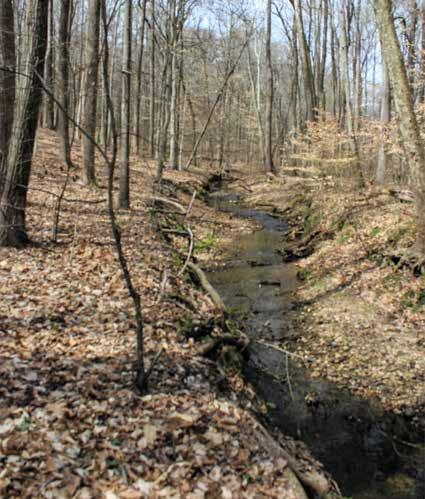

Holding their fire while the Southerners advanced into a killing zone, the Vermonters then rose up and delivered several volleys that left the ground strewn with dead and dying soldiers. The fighting was short lived, but intense. Three of Grant’s men were awarded the Medal of Honor for their actions at Smith Run. Sergeant Major Amos J. Cummings, of the 26th New Jersey, was recognized for helping to pull back a battery of field artillery from a dangerous and exposed position. Sergeant Robert J. Coffey, of the 4th Vermont, captured two officers and five privates of the 8th Louisiana. First Lieutenant Frank G. Butterfield, of the 6th Vermont, took command of his unit’s skirmish line in the oncoming darkness and covered its retreat.
The Union success was short lived though, as Confederates had gained a position to the north, and there were no reinforcements to available. This brief action bought the Union VI Corps a
short respite in which to begin withdrawing. Grant reformed his brigade in the darkness, throwing our skirmishers, and covered the retreat toward, and across, Banks’ Ford, thus bringing the Battle of Second Fredericksburg to a close. Most of the Salem Church/ Second Fredericksburg battlefield was lost to development long ago. In 1996, the City of Fredericksburg set aside 4.5 acres of the battlefield near Hugh Mercer Elementary School. In 2001, CVBT and its partners preserved an 11+ acre portion of this battlefield at a cost of $300,000. In 2008 CVBT conveyed its land to the City of Fredericksburg, which has since put in trails in what is now a 15.5 acre urban park.
Terry Rensel is the Executive Director of the Central Virginia Battlefields Trust. The mission of the Central Virginia Battlefields Trust is to preserve land associated with the four major campaigns: Fredericksburg,


Chancellorsville, the Wilderness, and Spotsylvania. To learn more about this grassroots preservation non-profit, which has saved over 1,550 acres of historic battlefield, please visit: www.cvbt.org.

35 March 2022 35 March 2022 CivilWarNews.com CivilWarNews.com
Signage and entrance from the Cowan Blvd. end of the property.
View of Smith Run at the bottom of the trail.
View looking west up stream at Smith Run, toward the Vermont Brigade’s position.
Subscribe online at CivilWarNews.com
The Unjust Hanging of Captain Henry Wirz

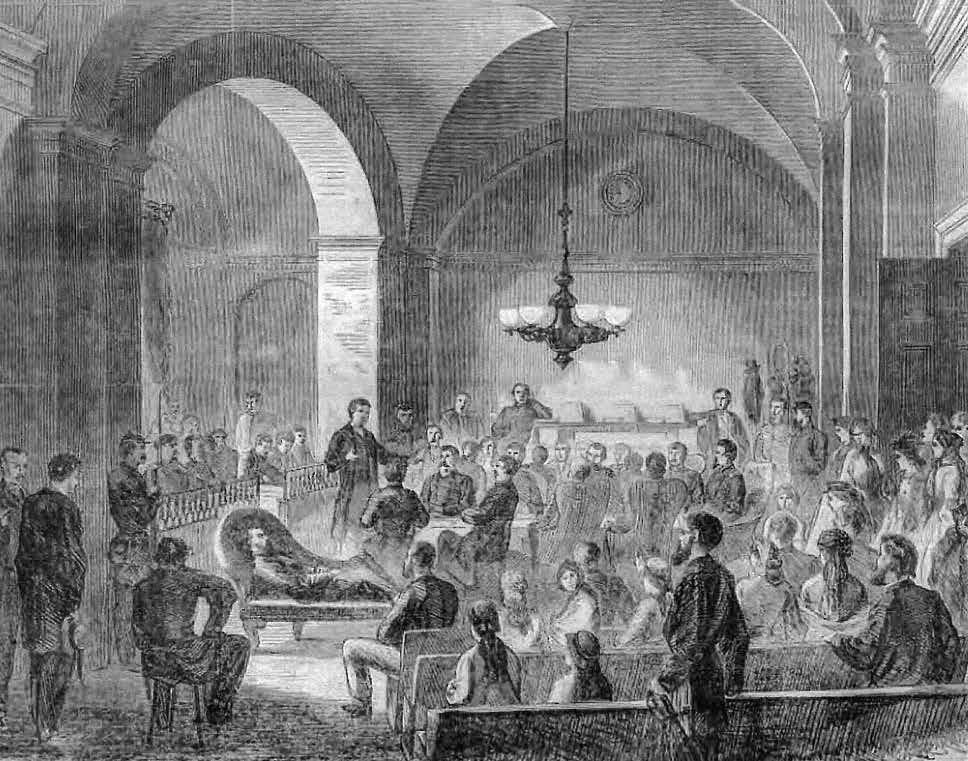 by Joseph F. Wilson
by Joseph F. Wilson
When the trapdoor opened, Confederate Capt. Henry Wirz dropped to his death at the end of a rope. The sacrificial lamb marched to the gallows on November 10, 1865, to satisfy the bloodlust of an agitated north clamoring for revenge after 13,000 Union prisoners who died of disease or starved in Andersonville Prison.
Northern hysteria rose to a fever pitch leading up to the sensational trial. The trial was the O.J. Simpson trial of the 19th Century, but achieving an acquittal for Wirz never stood a chance. The verdict came back as expected; tranquility settled over the north after the noose strangled the life out of the Andersonville Prison’s commandant. All seemed pleased when the lifeless body of the most despised man in America went into the grave, but many questioned whether justice had been served.
To blame a captain for such a monumental calamity defies how orders flow down the chain of command. Putting Wirz in the crosshairs diverted attention from northern officials who allowed thousands of Union soldiers in 1864 to die at a rate of 100 per day in August because Northern strategy accepted the death of loyal Americans for the sake of a numerical advantage. These are the same boys who rushed to Father Abraham’s call to save the Union.
Grant, Stanton, and Lincoln decided not to resume the
prisoner exchange policy that collapsed in the summer of 1863. They agreed to hold their Southern prisoners till the end of the war. If that meant Union men in Andersonville had to starve to death, so be it. Sadly, ideology took precedent over humanity. Grant saw prisoners as pawns more valuable to him languishing in a vile prison than recuperating at home.
Southern proponents argue correctly that the Union blockade prevented the South from procuring much needed supplies.
Union cavalry burned tons of food that may have been partially allocated to prisoners, medicine was declared contraband. However, if you can’t provide the sustenance of life for your captives, you’re bound to release them. Instead, Confederates watched as thousands of cadavers filled up the graveyard. Officials on both sides seem to have remained unconcerned with the unfolding catastrophe.
To appear to be taking the moral high ground in an election year, the North offered up the bogus black soldier issue. With the south refusing to exchange black prisoners, Union officials refused to negotiate a deal. Of the total 50,000 Union soldiers being held, only 850 were black. Union Commissioner of Exchange, General Benjamin Butler suggested holding 850 Confederate officers in lieu of the black prisoners. Grant ignored the excellent idea that didn’t fit his scheme. Butler later admitted
in a speech after the war that he was told to “put forth the negro question to complicate and prevent exchange.”
The trial of Henry Wirz can best be described as a total farce that could probably never happen today. At the start of the trial, Wirz faced charges of murder and conspiracy to injure and impair the health of Federal soldiers. Included in the conspiracy charge were such notables as Gen. Robert E. Lee, Confederate President Jefferson Davis, and other highranking Southern officials.
When Secretary of War Edwin Stanton read the charges, he immediately removed Lee, Davis, and the other civilian officials from the conspiracy charge. Despite Lee and Davis leading the rebellion, the popular leaders still held sway among influential Americans. Lee came from one of the most prominent families in Virginia, and Davis still had many friends in Washington. The charge against Wirz now read “conspiracy with others unknown.” The Swiss immigrant who spoke broken English faced the wrath of Northerners alone.
Biased reporters flocked to Washington to cover the trial of the man they described as “a blood thirsty monster” and “the demon of Andersonville.” The Boston Advertiser offered that Wirz was “a scorned, loathed, despised, miserable creature, hated of all men.” With passions still running high four months after the assassination of President Lincoln, Wirz didn’t stand a chance. All in the North wanted blood; prosecuting Attorney Colonel Norton Chipman intended to deliver.
It was decided to have a U.S. Military Commission to prosecute Wirz. His lawyers immediately objected as Wirz never served in the U.S. Army. At the time of trial, Henry Wirz was officially a citizen. His lawyers claimed he deserved a jury trial of his peers where the case must be proved beyond a reasonable doubt; that wasn’t going to happen. A civil trial requires a preponderance of the evidence; in a military trial,
it could come down to whatever mood tribunal members were feeling on a particular day.
Wirz’s conviction was preordained from the start. The trial of the century started in August. For two months, Norton Chipman paraded a flood of people to the witness stand including former prisoners, Confederate doctors, clergy, and local citizens. Everyone repeatedly testified to the horrible conditions inside the stockade; even Wirz would agree with that assessment. Conditions inside the prison were never in dispute. Chipman argued that Wirz intentionally caused those conditions.
In the conspiracy charge, Chipman somehow knew exactly how many deaths Wirz caused in several areas. Each of the several charges started with his proclamation that Wirz “well knew and fully intended.” Hearsay ran rampant and was allowed throughout the proceedings.
Chipman stared at the defendant as he loudly stated that Wirz “well knew and fully intended” for 30 to die in the stocks. Chipman continued to state that a ball and chain claimed 100 men. Noxious air terminated 1,000 soldiers; another 200 died from a poisonous vaccine “wickedly deposited” in the arm to intentionally kill them. Over 300 men were shot at the deadline; dogs viciously killed 50 men trying to escape. How Chipman came up with these detailed figures is anyone’s guess. We now know that impure
36 CivilWarNews.com March 2022 36 March 2022 CivilWarNews.com
The Trial of Henry Wirz, Harper’s Weekly, Oct. 21, 1865.
Reading the death warrant to Wirz on the scaffold. (Library of Congress)
and rubbed his snout against my cheek.” A narrative of a dog demanding a little love didn’t please the prosecutor.
Chipman claimed the lack of food, water, and shelter was Wirz’s “evil and wicked design” that killed 10,000 soldiers. The claim holds a partial truth regarding the scarcity of the basic essentials of life. To suggest those prisoners all died by design at the hands of one man is absurd.
In spring 1864, Grant’s Overland Campaign began. Every day in May and June nearly 500 prisoners stepped off the trains and entered the already crowded stockade. Wirz had no responsibility for the excessive numbers. As for food, the prison had a commissary with another officer in charge of rations. The Quartermaster had charge of supplying the prison with blankets, eating utensils,

and shelter. Wirz had nothing to do with the hospital. The myriad reasons why 13,000 Union soldiers died at Andersonville had very little to do with Captain Wirz.

Over 140 witnesses testified, but any testimony on cruelty and death in Northern prisons wasn’t allowed. Acts of kindness by Wirz also couldn’t be heard.
Captain Wirz had permitted six prisoners to travel to Washington with a petition from the prisoners begging the government to resume the exchange. They couldn’t get an audience with Lincoln or any top official, a fact that wasn’t allowed in court. Chipman argued that “it besmirched the good name of the dead president.”

Testimony on the north’s failure to exchange prisoners was deemed irrelevant. Lawyers for Wirz screamed foul. They had anticipated putting partial blame on Grant for refusing to exchange prisoners. With regard to exchanging prisoners, Grant stated, “Exchange simply reinforces the enemy at once, while we get no benefit from soldiers we receive for three months and lose the majority entirely.” A prisoner’s life simply didn’t matter. Since Grant received no benefit from an exchange, the prisoners were doomed.
Grant also stated, “It’s hard on our men in southern prisons not to exchange them, but it’s humanity to those left in the ranks to fight our battles.” Families of abandoned prisoners dying by the score never believed Grant possessed an ounce of humanity. Neither did families of soldiers killed at Cold Harbor. Union men starving to death never drew any compassion from Grant or the Lincoln administration. It was simply a business decision.
After the conspiracy charges came the murder portion of the trial. The court presented thirteen counts of murder that claimed Wirz shot, beat, and stomped to death Union prisoners. Incredibly, not a single name could be attached to any supposedly murdered victim. Despite thousands of witnesses inside the stockade, any murder victims remain unidentified.
From the 140 witnesses who testified, only 15 saw Wirz commit any act of violence. In a prison scenario, prisoners never have a favorable impression of their keeper. From 33,000 prisoners, it wasn’t hard to find 15 who hated Wirz so much they were willing to perjure themselves. Union prisoner Martin Harris, 5th NY Cavalry, testified he “never saw Wirz shoot or hurt anybody.” Even a Confederate guard, W. Hammack, 55th Georgia, offered, “I never saw violence or was ordered to shoot prisoners.”
Chipman’s closing argument referenced guerilla warfare, coal bombs, torpedoes, and Lincoln’s assassination. This was a staged passion play designed to stir hatred that had nothing to do with Wirz. The charade finally ended with Wirz sentenced to death.
The commission found Captain Wirz guilty on 10 of the 13 murder charges. He also was found guilty of the conspiracy charge. It’s interesting to note that no other Confederate official was charged or found guilty of conspiracy. It’s an obvious fact that one cannot conspire alone. After the death of Wirz, four more murders brought the total of murder victims to fourteen. It was assumed Captain Wirz must have been responsible for them too. So they were added to the record.
It wasn’t long after the trial that the 15 star witnesses given the most time on the stand by
vaccine abounded in 19th century America. Testimony on the stocks as well as the ball and chain fell well short. Breathing bad air could never be proven. Historians believe that only 14 men were killed at the deadline. While grave diggers testified many bodies had gunshot wounds many soldiers arrived at the stockade already suffering from battle wounds with little chance of recovering in the dirty prison. Chipman wanted the court to believe that all the gunshot wounds came from
Rebel
Testimony on the dogs contradicted Chipman’s claim that the dogs were “ferocious, bloodthirsty beasts, dangerous to human life; any man overtaken by these beasts could not save his life by coming to a stop; to surrender was death.” One prisoner testified he escaped and when he heard the “bloodthirsty beasts” coming for him, he hid in the brush. Boston Corbett stated, “the dog found me in the bushes
37 March 2022 37 March 2022 CivilWarNews.com CivilWarNews.com
Adjusting the rope for the execution of Wirz. (Library of Congress)
Newspaper reporters viewing the execution. (Library of Congress)
guards ordered by Wirz to shoot the Yanks.
Andersonville Prison, Ga., August 17, 1864. Southwest view of stockade showing the dead-line. (Library of Congress)
Chipman proved to be deserters, liars, and men of despicable character. But it was too late for Wirz, who was moldering in his grave.
The United Daughters of the Confederacy erected a controversial monument to Wirz in the village of Andersonville. A priest who spent time in Andersonville, Father Clavreul, best described the Wirz debacle when he stated, “Wirz was no more deserving of a monument than he was of hanging.”
Wirz offered a passionate plea at the end of the trial admired by even the most eloquent lawyers.
Letter from Henry Wirz to General J.H. Wilson, U.S.A. (May 7, 1865): Request For Safe Conduct.
After the long articulate address to the court, he said, “I trust that I shall not be held responsible for the official deeds of others. By my own acts let me be judged. I do not ask mercy, but I demand justice.”
In the end, Captain Henry Wirz received neither.
Joseph F. Wilson lectures on Andersonville Prison and the Pennsylvania Reserves. He also wrote and produced the film “Civil War Prisons – An American Tragedy” now available on Amazon. Email: joef21@aol.com.
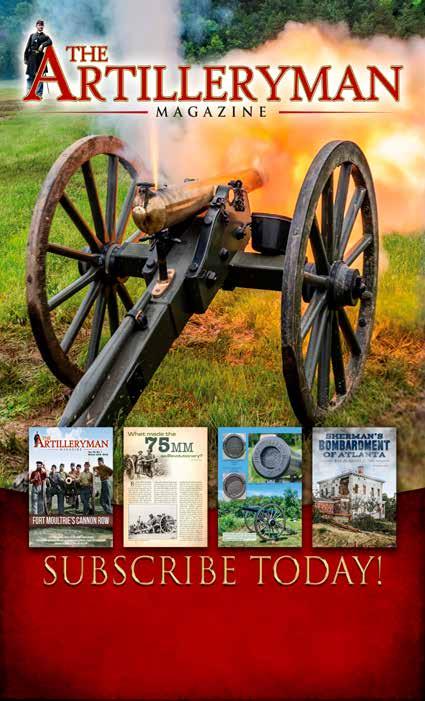

[To:] Major General J.H. Wilson, U.S.A., Commanding Macon, Georgia.”
Publishers Note: Today Wirz’s arm and the first two neck vertebrae are on display at the National Museum of Medicine and Health located in Silver Spring, Md. According to Anatomical Collections Manager, Brian Spatola “the arm was kept as proof that it was not injured to the degree that he professed and the vertebrae were kept to demonstrate that they did not fracture when he was hung.”
“ANDERSONVILLE, GA., May 7, 1865
GENERAL: It is with great reluctance that I address you these lines, being fully aware how little time is left you to attend to such matters as I now have the honor to lay before you, and if I could see any other way to accomplish my object I would not intrude upon you. I am a native of Switzerland, and was before the war a citizen of Louisiana, and by profession a physician. Like hundreds and thousands of others, I was carried away by the maelstrom of excitement and joined the southern army. I was very seriously wounded at the battle of “Seven Pines,” near Richmond, Virginia, and have nearly lost the use of my right arm. Unfit for field duty, I was ordered to report to Brevet Major General John H. Winder,

in charge of federal prisoners of war, who ordered me to take charge of a prison in Tuscaloosa, Alabama. My health failing me, I applied for a furlough and went to Europe, from whence I returned in February, 1865. I was then ordered to report to the commandant of the military prison at Andersonville, Georgia, who assigned me to the command of the interior of the prison. The duties I had to perform were arduous and unpleasant, and I am satisfied that no man can or will justly blame me for things that happened here, and which were beyond my power to control. I do not think that I ought to be held responsible for the shortness of rations, for the overcrowded state of the prison, (which was of itself a prolific source of fearful mortality,) for the inadequate supplies of clothing, want of shelter, &c., &c. Still I now bear the odium, and men who were prisoners have seemed disposed to wreak their vengeance upon me for what they have suffered—I, who was only the medium, or, I may better say, the tool in the hands of my superiors. This is my condition. I am a man with a family. I lost all my property when the federal army besieged Vicksburg. I have no money at present to go to any place, and, even if I had, I know of no place where I can go. My life is in danger, and I most respectfully ask of you help and relief. If you will be so generous as to give me some sort of a safe conduct, or, what I should greatly prefer, a guard to protect myself and family against violence, I should be thankful to you; and you may rest assured that your protection will not be given to one who is unworthy of it. My intention is to return with my family to Europe, as soon as I can make the arrangements. In the mean time I have the honor, general, to remain, very respectfully, your obedient servant, WIRZ, Captain C. S. A.
An autopsy was deemed appropriate for the convicted man for legal reasons and on Nov. 9, 1865, the necessary orders were sent from J.H. Taylor AAS to surgeons W. Thompson and R.O. Abbott for them to attend the hanging.
38 CivilWarNews.com March 2022 38 March 2022 CivilWarNews.com Subscribe online at CivilWarNews.com
magazine. 520 Folly Road, Suite 25 PMB 379, Charleston, SC 29412 • 800-777-1862 • mail@artillerymanmagazine.com www.ArtillerymanMagazine.com The Artilleryman Magazine FOUR INCREDIBLE ISSUES A YEAR
Captain Henry Wirz.
e
Artilleryman is a quarterly magazine founded in 1979 for enthusiasts who collect and shoot cannons and mortars primarily from the Revolutionary War, Civil War to World War II. Now expanded and fully illustrated in rich color throughout the entire
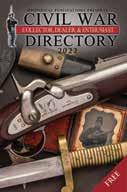

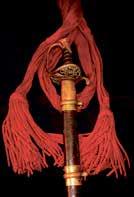















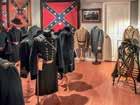






















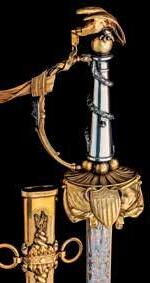







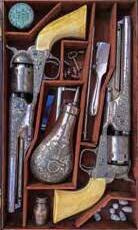

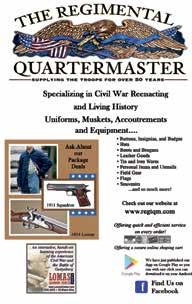
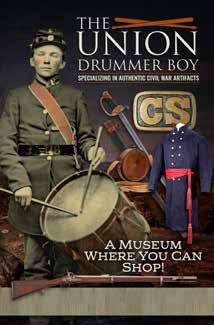


















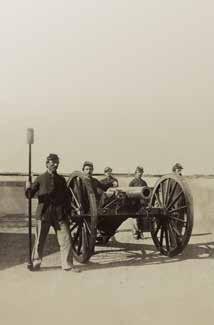







THE FINEST HISTORICAL ANTIQUE MILITARIA Wallace Markert csacquisitions@gmail.com 16905 Nash Road • Dewitt, Virginia 23840 804-536-6413 www.csacquisitions.com JJ Military Antiques Buying and Selling Original Rev War – WWII Guns, Swords, Bayonets, Molds, Flasks, Tools and Accoutrements. Specializing in all Civil War Union & Confederate Artifacts. www.jjmilitaryantiques.com PO Box 18 • Mt. Bethel, PA 18343 • Phone: 610-599-0766 Email: info@jjmilitaryantiques.com Promoters of Quality Shows for Shooters, Collectors, Civil War and Militaria Enthusiasts Military Collectible & Gun & Knife Shows Presents The Finest Mike Kent and Associates, LLC • PO Box 685 • Monroe, GA 30655 (770) 630-7296 • Mike@MKShows.com • www.MKShows.com Northwest Georgia Trade Center 2211 Dug Gap Battle Road Dalton, GA 30720 January 29 & 30, 2022 Chickamauga (Dalton) Civil War Show Williamson County Ag Expo Park 4215 Long Lane Franklin, TN 37064 December 3 & 4, 2022 Middle TN (Franklin) Civil War Show l Shiloh Buying & Selling Authentic Civil War Artifacts 2405 Oak Grove Road Savannah, TN 38372 731-438-3541 ShilohRelics.com History@shilohrelics.com owner Rafael Eledge .com Dealing in the Finest Authentic Militaria Since 1995 with an Emphasis on the American Civil War Pistols, Muskets, Carbines, Rifles, Bayonets, Swords, Uniforms, Headgear, Belt Buckles, Cannon, Buttons, Bullets, Artillery Implements Etc. Mid West Civil War Relics MidWestCivilWarRelics.com Allen Wandling Phone: 618-789-5751 Email: awandling1@gmail.com Museum Quality Civil War Union & Confederate Artifacts! We handle the Best Antique Bowie Knifes, Civil War Swords, Confederate D-guards, Antique Firearms, Dug Relics, Buckles & Belts, Identified Relics, Letters, Documents, Images, Currency, Uniforms, Head Gear & Flags. SELLING CIVIL WAR MILITARIA Journey’s End Antiques Antiques • Collectibles Paper Money • US Coins Old Toys, Dolls & Trains Paul Brill apbrill@earthlink.net Home: 910.725.0466 | Cell: 910.638.4542 Southern Pines, NC 28387 journeysendantiques.com Antique Flag Conservation Services Save your family heirlooms and valuable textiles Specialist in Civil War flag Restoration and Conservation Custom affordable rates free estimates/fully insured email heritageconservationva@gmail.com Or call Josh Phillips at 540-320-6588 Heritage Conservation, LLC Brian “Rebel” Akins 615-772-7008 You gonna check out my websites or whistle Dixie?” Are you afraid of buying a “nice” piece just to find out you were stuck with a fake? tired of continuously checking a website and not finding anything new? irritated when you can’t reach anyone on the phone or get an email answered? frustrated by great “write-ups” but when you get your item, you feel cheated? Brian “Rebel” Akins Call the “Rebel,” you how we put an end to these issues, and many more! Are you afraid of buying a “nice” piece just to find out you were stuck with a fake? tired of continuously checking a website and not finding anything new? irritated when you can’t reach anyone on the phone or get an email answered? frustrated by great “write-ups” but when you get your item, you feel cheated? RebelRelics.com Accoutrements www.csarms.com PO Box 602 9150 John S. Mosby Hwy. Upperville, Virginia 20185 Shop Phone: 540-592-7273 Email: sophiacsarms@aol.com Michael Simens HistoricalArms.com 440-744-9088 • mail@HistoricalArms.net Magnificent Swords The Finest Tiffany “Cannon-Hilt” A gift to Major Lehman W. Bradley in 1863 for gallantry in the Wheatfield at Gettysburg. Please see our website www.AndrewBottomley.com Mail Order Only • Worldwide Shipping Calling the UK from overseas: +44 1484 685 234 Calling our UK cellphone from outside the UK: +44 7770 398 270 email: sales@andrewbottomley.com The Coach House • Huddersfield Rd. HOLMFIRTH West Yorkshire United Kingdom HD9 3JJ £1,650 £1,850 £6,500 £3,850 £2,850 £1,850 Ref. 3123 Ref. 3046 Ref. 3156 Ref. 2919 Ref. 3112 Ref. 3394 Valuable Colts Rare, Cased Pair of Nimschke Engraved Colt 1861 Navy Revolvers. 34 York St • Gettysburg, PA 17325 717-334-2350 • CIVILWAR@UNIONDB.com uniondb .com All Hands on Deck! Support Our Mission to Bring You the Naval History “This is the magazine for all things Civil War Navy. From ‘Uncle Sam’s web-feet’ to the ‘grey jacket navy’ raised by Jeff Davis! It is all here thoroughly researched and illustrated by beautiful contemporary navy images.” Ron Field, military historian and author of over 45 books, including Bluejackets: Uniforms of the United States Navy in the Civil War Period, 1852-1865. 1 Year—4 Issues: $37.95 Subscribe Now at civilwarnavy.com Or send a check to: CSA Media, 808 Drayton St., Savannah, GA 31401 International subscriptions subject to postage surcharge. Sailors and Marines on the deck of the U.S. gunboat Mendota, 1864. National Archives (Identifier 524548). P.O. Box 342 Thompsons Station, TN 37179 615-585-0115 Email: brubon2@bellsouth.net Franklin Relics Specializing in Accoutrements, Edged Weapons, Firearms and Uniforms FranklinRelics.com Bruce Hohler Proprietor www.AmericanRelics.net Allen Phillips 1014 Reservoir St., Suite B Harrisonburg, VA 22801 Phone: 540-476-1969 Email: americanrelicsnet@gmail.com American Relics Specializing in Buttons, Buckles, Currency, Hat Devices and other Military Artifacts. www.CivilWarBadges.com Everitt Bowles, Owner • 770.926.1132 1036 Washington Avenue Woodstock, Georgia 30188 The Largest Selection of GAR & UCV Hundreds of Memorabilia Items from Rev War through Vietnam Secure & Easy Guaranteed Authenticity of Every Item Vin Caponi Historic Antiques Vin Caponi, Jr. 18 Broadway Malverne, NY 11565 Store: 516-593-3516 Cell: 516-353-3250 rampantcolt@aol.com http://www.vincaponi.com We carry a very large inventory of Colt and Civil War firearms including muskets, carbines, rifles and accoutrements. Our inventory of historic antiques and firearms begin at the early collectors level and range all the way up to the advanced collector and investors level. 8895 Town and Country Circle • Knoxville, TN 37923 Phone: 865-693-3007 info@armyoftennesseerelics.com Civil War Artifacts Nick Periut Proprietor ArmyofTennesseeRelics.com Buying and Selling High Quality Images, Belt Buckles and Plates, Artillery Shells, rare Bullets and Buttons! Contact Glenn Dutton at: glennjdutton@aol.com or 770-351-7565 BUYING & SELLING Field & Heavy Artillery Cannon, Shells, Fuses & Etc. The 2022 Civil War Dealers Directory is out. To view or download a free copy visit: civilwardealers.com/dealers.htm The 2021 Civil War Dealers Directory is out. To view or download a free copy visit: www.civilwardealers.com/dealers.htm The 2022 Civil War Dealers Directory is out. To view or download a free copy visit: civilwardealers.com/dealers.htm The 2022 Civil War Dealers Directory is out. To view or download a free copy visit: civilwardealers.com/dealers.htm
Civil War News book reviews provide our readers with timely analysis of the latest and most significant Civil War research and scholarship. Contact email: BookReviews@CivilWarNews.com.

Vicksburg or Gettysburg?
Summer of ’63: Vicksburg and Tullahoma. Chris Mackowski and Dan Welch, Editors. Maps, illustrations, photos, index, 305 pp., 2021, Savas Beatie, www.savasbeatie. com., hardcover, $29.95
 Reviewed by Joseph Truglio
Reviewed by Joseph Truglio
Reconstruction and the Truth
The Record of Murders and Outrages: Racial Violence and Truth at the Dawn of Reconstruction. By William A. Blair. 4 tables, notes, index, 173 pp., 2021. The University of North Carolina Press. https:// uncpress.org. $95 (Hardback), $19.95 (Paperback).
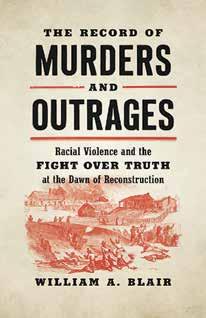
Reviewed by Salvatore
Cilella
to Murders and Outrages.”
The inclusion of material so shockingly direct from a government agency became in his words, “central” to understanding Reconstruction. He realized that amid all the intense rhetoric of that period, here was a documentation of actual events on the ground by eye-witnesses attempting to accurately report what they saw.
the white man’s word over the freed man (96). The difference was that the Bureau recorded names, places, and violent acts whereas before its existence rumor and hearsay ruled the day. Hence, Blair’s subtitle…”the fight over truth.”
Blair helpfully provides four tables, each of which provides greater clarity and definition.
One of the most common discussions amongst Civil War buffs is: “What is the more important battle, Vicksburg or Gettysburg?” Emerging Civil War/Savas Beatie has published two books on this issue, one for each event. I have not read the Gettysburg book but did read the Vicksburg book.
The format is the anthology type, with approximately twenty authors giving their opinions on the various stages of the battle. The Tullahoma campaign is thrown in for good measure. Many essays are short; however, this does not detract from the history nor the results. This is not a battle history but rather the opinions of noted historians as to the battle’s results. One need not read the essays in order, but
it is recommended to do so to maintain continuity,
I found this book full of valuable information on the battle and also valued the opinions of authors I admire and respect. Virtually all the essays are taken from ECW podcasts and this book allows those who have no access to podcasts the opportunity to learn of the events in written form. One need not agree with the opinions of the authors but can form more informed opinions themselves. This is a format that I whole heartedly enjoy.
What is best about this format is that is well suited for the novice student of the War. This is a valuable tool for beginning students. It seems that this is also the forte of ECW in reaching out to new scholars of Civil War history.
The price is affordable for virtually all readers, and it will make a great gift for an “emerging” student. My only complaint, and it is not really a complaint, is that there should have been a bit more on the important happenings at Tullahoma. None the less I came away fully satisfied. I look forward to reading the Gettysburg book to see if it changes my mindset.
In passing, I’m in agreement with this set of authors that Vicksburg is the more important event. However, that is just this reader’s opinion. Get yourself a copy and let me know what you think!
Joseph Truglio, of Manchester, N.J., is a retired Motion Picture Technician who has a life long interest in the Civil War. He is currently President of the Phil Kearny CWRT in Hasbrouck Heights, N.J.
The title of William Blair’s latest book, neither pithy nor nuanced, pretty much sums up his theses. As the blurb on the book’s cover explains, “Blair uses the accounts of far-flung Freedmen’s Bureau agents to ask questions about the early days of Reconstruction, which are surprisingly resonant with the present day: How do you prove something happened in a highly partisan atmosphere where the credibility of information is constantly challenged? And what form should that information take to be considered as fact?”
Well beyond a thoughtful reconsideration of Reconstruction, Blair’s book is an example of the use and misuse of primary documents both by contemporaries and 19th and 20th Century American historians. Blair has packed several narratives, conclusions, and new information in a small format of only 173 pages. Working with an exceptionally diligent research team, which he gratefully acknowledges, Blair has shed a harsh new light on the post-war-period-south.
Blair’s work has involved a long journey. Many years prior, doing research in the Alderman Library at the University of Virginia, he stumbled on a microfilm reel pertaining to the Bureau of Refugees, Freedman, and Abandoned Lands—the Freedman’s Bureau. The title page of one reel stopped him cold in his tracks—“Records Relating
The “Murders and Outrages” are stunning. As Blair points out, the Freedman’s Bureau findings and reports to President Johnson, who downplayed them; General Grant who responded to them positively; and of course the Radical Republicans who accepted them, and Democrats who labeled them alarmist, were the first unvarnished, data driven facts concerning violence in the post war South. Johnson and the Democrats looked at the South as totally reconstructed, blacks and whites living in harmony with minor outbreaks of “political” or “cultural” violence, certainly nothing to do with racism.
The arguments used in the late 19th Century for the existence of the Klan, for example, sound remarkably modern. Democrats denied its existence, much like cosa nostra mobsters of today.
Southern newspapers called the idea of a bunch of horse riders wearing white sheets as “youthful pranks” or a “humbug” (89). Southern leaders, former Confederates, averred in official memoranda from their positions of authority, that there was “nothing to see here” (95).
One such individual, newly minted Georgia congressman, Nelson Tift, attempted to influence the House Committee on Reconstruction by conducting a poll he gathered from civic authorities. In 1869, he asked his survey respondents if they thought blacks were mistreated, if the present civil government was sufficient to maintain law and order, and if military oversight should be reinstated. Unsurprisingly, the poll showed all was well in Dixie (94-5).
Tift’s “survey” proved unsuccessful. It was the Freedman’s Bureau that provided the more reliable answers and all was not well. The Bureau’s reporting convinced congress that reinstitution of military control was necessary. Ironically, Tift’s work was picked up by late 19th to the middle of the 20th century historians (well into the 1960’s) as evidence that atrocities committed in the name of law and order during Reconstruction could be largely ignored taking
Table 1, “Types of Murders and Outrages by state, 1865-1868;” Table 2, “Victims and assailants, 1865-1868;” Table 3, “White Voting in selected States, 18671868;” and Table 4, “Homicides in Texas, 1865-1868.” The author devotes a chapter to “The Problem of Texas” and his epilogue to the subject of lynching. The latter narrates the tortuous federal path to stop lynching, an action not taken until 2020. Texas proved exceptionally disturbing for law-and-order organizations because it’s sprawling geography, transient population, and lack of the necessary resources to prosecute “evil-doers.” As Phil Sheridan so famously proclaimed, “If I owned Texas and Hell, I would rent out Texas and live at the other place” (106). “Murders and Outrages” is an important addition to the growing new scholarship concerning post-Civil War America and Reconstruction. Its addition is a lesson in the use of primary materials, or their misuse. Blair makes good and common sense out of them. “Murders” also underscores the very real need to make history relevant. Many “outrages” enumerated in this powerful book could come from the pages of today’s news sources. Salvatore Cilella is the retired CEO of the Atlanta History Center. He is the author of Upton’s Regulars, (Univ. of Kansas Press, 2009) and editor of The Selected Correspondence of General Emory Upton, 2 Volumes. (Univ. of Tennessee Press, 2017). The latter is the recipient of the 2019 Founder’s Award, American Civil War Museum. He has edited “Till Death do us Part,” the love letters of Emory and Emily Upton documenting their brief and tragic two-year marriage (University of Oklahoma Press, 2020).
40 CivilWarNews.com March 2022 40 March 2022 CivilWarNews.com
Visit our New Website CivilWarNews.com
Getting from Point A to Point B
Patterson’s Independent Company of Engineers and Mechanics 1861–1865. By Charles H. Bogart. Photographs, maps, annexes, index, extracts of letters (in lieu of footnotes) and bibliography. 150 pp. Yellow Sparks Press, Frankfort, Kentucky. yellowparkspress@ gmail.com. 2020. Softbound. $12.98.
Reviewed by Richard J. Blumberg
A Powerful Framework for Understanding the Civil War as a Crisis of Civilization
the Western Theater: The Army of the Ohio, The Army of the Cumberland, and The Army of the Tennessee.
The soldiers of this company performed their services in four different states: Kentucky, Texas, Louisiana, and Mississippi. These services included: 1) building or repairing roads; 2) building or repairing bridges and railroads; 3) fortifying sites to be used in battle; and 4) building or repairing a location’s infrastructure to support battlefield operations. It also included other activities and duties required to get units from one point to a geographically different point.
Rites of Retaliation: Civilization, Soldiers, and Campaigns in the Americans Civil War. By Lorien Foote. Photos, maps, notes, index, 312 pp., 2021. University of North Carolina Press, www.uncpress. org. $22.95.
Reviewed by Jonathan A. Noyalas
how future generations would judge the decision.
Some smaller units that initially appear insignificant became well known for their major contributions to the War effort. Paterson’s Independent Company of Engineers/Mechanics is one of those. Charles Bogart gives a compelling biographical description of the challenges Patterson’s unit encountered and their triumphs over what appeared to be insurmountable obstacles.
Very few works covering the Civil War focus on contributions of the Engineer Corps. An even smaller number provide a good link between combat and logistical operations. Mr. Bogart’s work does both. Being a former Planner, Operations Officer, and Trainer for the Kentucky Division of Emergency Management makes him well qualified to conduct the research needed for this tome.
Also known as the “Kentucky Pioneer Infantry,” the unit was mustered into service in September 1861 and served until January 1865. Their assignments involved building, improving or repairing sites and facilities during the Cumberland, Vicksburg, and Red River campaigns. Captain Patterson and his unit served the three major Union Armies of
Although it was probably difficult to write, Bogart’s prose is easy to read and understand. Rather than using footnotes, he provides extracts of actual communication between Union commanders and Patterson’s Engineers. Battlefield maps and photographs help make the story of each adventure come to life. Bogart also provides the human side of Patterson’s story, which included mistakes he made and the lessons he and his unit learned.
Bogart effectively links his analysis between an action and its associated consequences. Flooded bayous without proper bridges made moving soldiers and equipment to the battlefield, impossible. Improving or building roads to various bivouac sites enabled units to move quickly and in an organized manner.
Patterson’s Independent Company of Engineers and Mechanics 1861–1865 is an excellent work and is especially recommended for those whose interest is in various engineering endeavors. Bogart effectively bridges the gap that shows how important support related operations are to the success on the battlefield. The $12.98 price tag makes this book a real bargain. Excellent research, a detailed bibliography, and numerous annexes and photographic images make it a book that should be on everyone’s reading list.

Richard has reviewed books for Civil War News for over twenty years. Three of his articles have been published in various issues of Civil War News.

A century after the Civil War’s opening shots in Charleston, South Carolina, Pulitzer-winning historian Bruce Catton appeared frustrated by the attempts of some historians to demonize the actions of one side at the expense of the other. In the introduction Catton penned for William Webb’s Crucial Moments of the Civil War (Bonanza Books, 1961), Catton stated that “meanness and folly and ordinary wrong-headedness, were divided” among both United States and Confederate forces throughout the conflict. While historians have written much about the savagery perpetrated by both sides, scholars have, in the estimation of historian Lorien Foote, the Patricia & Bookman Peters Professor of History at Texas A&M University, missed an opportunity to analyze those inhumane behaviors to comprehend how “Americans in the Civil War era” fought to “maintain their essential identity as a civilized people” in the midst of a bloody struggle for “republicanism and nationhood.”
Central to Foote’s deeply researched and deftly written study is an examination of retaliation rituals in the Department of the South, the area that embraced South Carolina, Georgia, and Florida. Throughout this study Foote does an impeccable job of differentiating revenge, a quick knee-jerk reaction to events without much thought, from retaliation. While historians oftentimes use these two terms interchangeably, Foote lucidly argues that retaliation served as an important mechanism to maintain “the identity of Americans as civilized people.” Engaging in a retaliation ritual involved communication between representatives of both sides, thoughtful reflection on international law and historical precedent, debates about how to make the response proportional, discussion among leadership about how best to implement a retaliatory measure, gauging the public’s potential response to the action, forecasting prospective consequences, and thinking about
The dilemma that Foote lucidly argues plagued the retaliation ritual was how each side determined who belonged to civilized society and was therefore subject to its rules and protections? In the estimation of Confederate officials, as Foote rightly asserts, black troops who donned United States uniforms were not part of civilization, but rather savages engaged in a most uncivilized act of servile insurrection. While the Confederacy never recognized formerly enslaved people as legitimate combatants, Foote investigates how the retaliation ritual in which United States officials engaged to alter the way Confederate authorities viewed US Colored Troops yielded a modicum of progress. Confederate officials ultimately recognized black soldiers who were born free as equal to white Union troops and thus when captured were subject to the same treatment. However, as the author notes, transformation in policy did not always translate to a battle’s aftermath. Murder and mistreatment of black soldiers in the Union’s service continued through the conflict’s end, including the uncivilized actions of Confederate surgeons who performed unnecessary amputations on black Union soldiers wounded and captured at Olustee.
Beyond the author’s detailed examination of retaliation rituals and their limits, Foote illustrates how subordinates’ refusals to carry out vengeful directives from superiors also served as a mechanism to maintain civilized behavior. For example, when Federal General John Foster ordered a substantial reduction in the rations for 600 Confederate prisoners of war in response to the horrid conditions endured by Union prisoners in South Carolina, Colonel Philip Brown, the commander of the 157th New
York Infantry, decided not to carry it out. A devout Christian, Brown believed that withholding one of life’s basic necessities from this contingent of Confederate officers brought to Morris Island in early September 1864 as a response to the Confederacy’s use of Union prisoners of war as human shields in Charleston, clashed with Christ’s teachings. In the end, as much as both sides hoped to maintain the idea that Americans could remain civilized in the midst of the Civil War, Foote clearly explains that while retaliation rituals at times “worked,” they “also failed.” Sometimes they miscarried because the desire to achieve victory, as in the case of the Union bombardment of Charleston, outweighed all else. On other occasions, retaliation rituals failed because, as in the case of the treatment of black Union soldiers, Confederates could not satiate their desire to re-enslave “Black Union soldiers” or murder “them on the battlefield.”
While those interested in the Department of the South will find Foote’s marvelous study essential, this volume’s appeal extends beyond the book’s geographic constraints. Foote’s valuable study, destined to be branded a classic, provides an important framework for understanding how armies and the soldiers who comprised them implemented and reacted to vengeful and retaliatory policies.
Jonathan A. Noyalas is director of Shenandoah University’s McCormick Civil War Institute in Winchester, Virginia, a professor in Civil War Era Studies at Shenandoah University, and founding editor of Journal of the Shenandoah Valley During the Civil War Era. He is the author or editor of fourteen books. Noyalas’ latest book, Slavery and Freedom in the Shenandoah Valley during the Civil War Era, was published by the University Press of Florida.
41 March 2022 41 March 2022 CivilWarNews.com CivilWarNews.com
Las Vegas Antique Arms Show News and Gallery


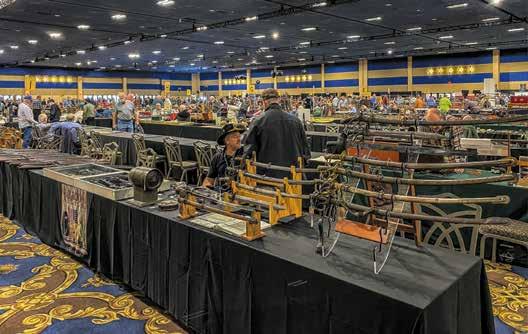

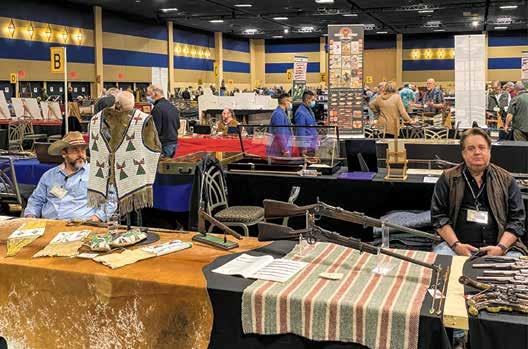
LAS VEGAS, Nevada— January 21-23. Due to COVID, this long running show was not held in 2021. It is back and in living color, lots of energy and well represented with dealers and collectors, both local and nationwide. Covid restrictions kept most Europeans from attending, but about 750 tables and booths were mapped in the program with about 500
individuals and businesses listed. The show was very active and, as always, high value articles exchanged hands.
Almost every firearms auction house had displays showing their upcoming sales. There is no lack of antique guns in the market with millions of dollars’ worth being sold this year. Any kind of antique Colt, Winchester, Remington, ornate
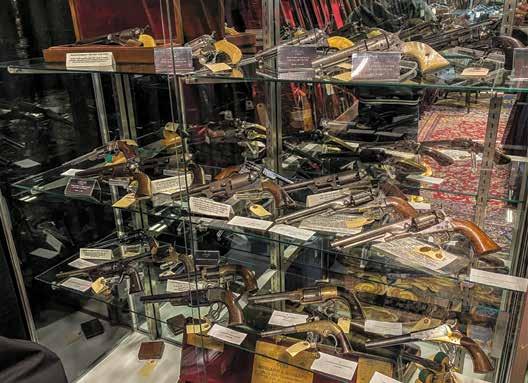
European arms, or Civil War item can be found in the upcoming spring auctions. My favorite weapons have always been Confederate revolvers and three auction companies displayed 10 examples, Amoskeag, Poulin, and Rock Island. There were a few scattered Civil War items for sale amongst all the Colts and other antique arms. There was only one Civil War
dealer here selling all Civil War material, Mickey Kiser of War Room Relics, who drove all the way from Kingsport, Tenn. One dealer normally associated with Civil War materials like Brendan Synnamon, proprietor of Union Drummer Boy in Gettysburg, had five tables of 20th century guns that were selling well. He had just bought big collection and said he picked a good venue as sales
were good. Another Civil War dealer Brian Akins, proprietor of Rebel Relics, brought a display of American Indian artifacts and a collection of Confederate cutlasses.
Congratulations to Cheryl Goyda who did a fantastic job as the new show chair after DMA purchase the show. Next year’s show is scheduled for Jan. 20-22, 2021.
42 CivilWarNews.com March 2022 42 March 2022 CivilWarNews.com
The March-April issue mails the end of February 2022! A brand new full-color 80-page, glossy magazine for the Military Antique Collector. The publication will spotlight rare and unusual military objects, beautiful craftsmanship works, and historical figures dating from early American and European history to limited coverage of the post-1898 artifact. This page and the following page provide samples of the content. Subscribe now to get your first issue.





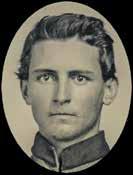




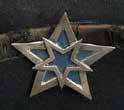




Order your subscription online at MilitaryAntiqueCollector.com or fill out this form and mail to the address below. Name: Mailing Address: City: State: Zip Code: Phone: Email: ☐ One Year U.S. Subscription $39.95 ☐ Two Years U.S. $72.00 U.S. Dollars Only Check or Certified Funds Check# Make checks payable to: Historical Publications LLC ☐ Discover ☐ Mastercard ☐ Visa ☐ Amex Card#: Exp. Date: Security Code: Name on Card: Billing Address: City: State: Zip Code: Signature: Historical Publications LLC 520 Folly Road, Suite 25-379, Charleston, SC 29412 800-777-1862 • info@historicalpublicationsllc.com MILITARY ANTIQUE MAGAZINE This unidentified member of the 28th Pennsylvania Infantry is wearing a frock coat that has a XII Corps, Army of the Potomac, badge dating this photograph after the summer of 1862. The inset of the badge has been colorized and reversed for readability. Liljenquist Family Collection of Civil War Photographs (Library of Congress). IMAGES CAPTURED IN TIME 56 Military Antique Collector Magazine Civil War U.S. Officer’s Slouch Hat Identified to the 28th Pennsylvania Infantry (Goldstream Regiment). This regiment was formed in Philadelphia and mustered in June 28, 1861. The unit served in the XII Corps from September 1862 through October 1863, including Fredericksburg, Chancellorsville, and Gettysburg. The unit was heavily engaged throughout the war losing 157 men killed and mortally wounded. The hat is constructed of fine wool felt with a ½-inch woven silk tape band along the bottom edge of the brim. There is a 1-inch black silk hat band, bullion and black hat cord with black net over the bullion tassels. Tin backed insignia on the front with gold bullion embroidered infantry horn with separately affixed false embroidered number “28.” A black ostrich feather plume curves around to the back of the hat. Attached to the turn up on the side of the hat is a beautiful XII Corps, 3rd Division, silver corps badge that was continued in use as the XX Corps after April 1864. The large silver star, 1¾-inches across the points, with blue cloth insert, is overlaid by a smaller star, 1-inch across the points. (Courtesy Heritage Auctions). UNION OFFICER SLOUCH HAT INTERIOR OF HAT IS RED SILK WITH A “ROCHET, PARIS” MAKER’S LABEL CORPS BADGE DESIGNATING XII AND XX ARMY CORPS IMAGES CAPTURED IN TIME 57 Military Antique Collector Magazine MILITARY ANTIQUE MAGAZINE CONFEDERATE ARTILLERY SHORT SWORD WITH LEATHER SCABBARD MADE BY E J JOHNSON, MACON, GA These short swords were copies of the U.S. Model 1832, heavy artillery sword, a so-called “Roman style” sword or gladius, manufactured by N.P. Ames.. The overall length of the sword is 24.5 inches with a blade length of 19 inches. The heavy cast hilt on this sword does not resemble the Ames swords’ simulated scale or feather grip motif. It has been suggested that these swords were, for the most part, carried by artillery battery NCOs. The steel blade is double-edged with less encountered feature, two short, parallel, upper fullers and a single, long fuller. Crudely executed copies of the Ames blades; most of them Confederate, are short swords of this type without fullers. The blade is smooth, with virtually no pitting or oxidation. IMAGES CAPTURED IN TIME 58 Military Antique Collector Magazine Hardee This seated Union cavalryman is wearing nine-button frock coat. His white buff leather sword belt with US oval belt buckle and over the shoulder white buff strap were regulation in 1839 for dragoons. The soldier is holding his cavalry saber and wearing a Model 1858 dress “Hardee” hat with stamped brass cavalry insignia and regimental and company designations of a Company “H,” 2nd regiment. Liljenquist Family Collection of Civil War Photographs (Library of Congress). Enlargement of Union cavalryman in uniform with Hardee hat. Photograph shows cavalry insignia and 2nd Regiment Company F designation. Is that dirt, black powder residue, or suntan on his face? Not all eponymous inventions were lethal; we now turn to head covers and footwear. First the Hardee hat, sometimes known as the Davis hat. Neither William Hardee nor Jefferson Davis designed the hat but played what we can call a managerial role. William J. Hardee (1815–1873), a major at the time, served on the 1855 army board was responsible for selecting the design for a new dress hat. Chosen in 1858, the black hat had a tall crown and wide brim that was pinned up on one side by a brass eagle, the right side for the cavalry and artillery, the left for the infantry. The side opposite the fold sported a black plume. A wool cord designated the branch of service, blue for infantry, gold for cavalry, and red for artillery. Davis, Secretary of War from 1853 to 1857, is sometimes associated with the hat. The hat was a mark of distinction for the Iron Brigade, but otherwise was not widely used during the war. 15
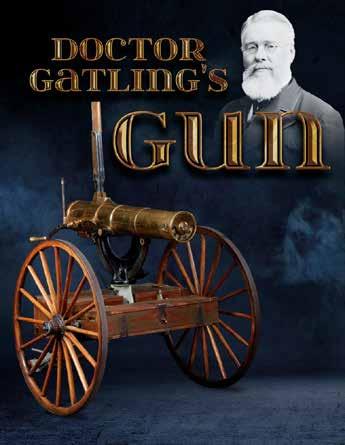
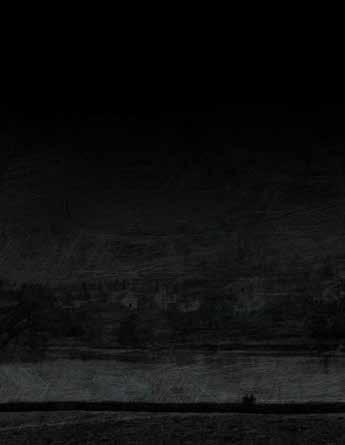
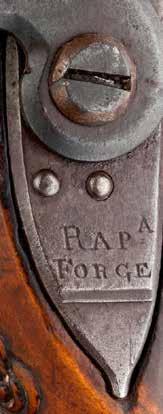










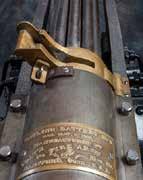


















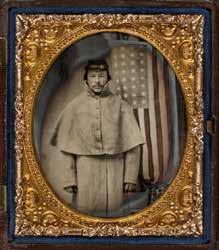

44 CivilWarNews.com March 2022 44 March 2022 CivilWarNews.com By Philip Schreier, Director, NRA Museum This Model 1900 in .30-40 was one of the last designs produced by the Gatling Company before they were found to be obsolete and replaced by water cooled and air cooled full automatic machine guns. Photos courtesy of NRA Museum. Photo of Dr. Richard Jordan Gatling (1818–1903). (Library of Congress). 24 Military Antique Collector Magazine By 1770 Hunter’s Iron Works at Falmouth was considered the largest in America. With the advent of hostilities brewing in America between the American colonists and England, James Hunter expanded his manufacturing and forging muscle to include the production of small arms. Hunter advertised for all kinds of craftsmen. He offered them inducements of half-acre lots of land and assistance in building their houses: Wanted, at Hunter’s Iron Works, the Falls of Rappahannock River, in the Manufactory of small Arms, a Number of Hands who understand the File, also Anchor Smiths, Blacksmiths, and Nailers, to whom suitable Encouragement will be given; where may be had, for ready Money only, Bar Iron, Fullers Shears, Files, and a Variety of Articles made in the Iron Branch, and where Tradesmen of every Kind, who incline to settle, may have Half Acre Lots of Land at a small Ground Rent for ever, and may be assisted in building, Provisions, and Materials, and the Produce of their Labour taken in Payment for the same. Apply to John Strode, Manager of said Works. The advertisement was repeated several times during the following year, and Hunter offered to purchase “Negro Tradesmen in any of the above Branches, also Coopers.”4 Hunter was interested in producing military materiel and armaments at least as early as October 1775 when he advertised in a Philadelphia newspaper seeking workers skilled in gun making. In the mid-eighteenth century, Philadelphia was the central geographical location for those experienced in the gunmaking trades. Hunter advertised that he wanted “a gun smith, a complete artist, able to take the charge of a shop, and twenty-four hands under his care and direction; ten gun locksmiths, four gun stockers, two complete workman for turning and welding gun barrels, two complete workman for boring and grinding gun barrels, and a good file cutter.” The following year, in June 1776, James Hunter showed a sample musket with bayonet, scabbard, and steel ramrod to the Convention established by the Virginia government to oversee production of arms and materials in support of the Patriot cause. The musket was very well received and adopted as the standard long firearm. Hunter was asked to make as many muskets as possible within the next twelve months. Hunter expanded his gun product line to include other types, including two types of pistols at the Hunter Iron Works, a .69 caliber, 9-inch smooth bore and a .65 Close up photograph of the engraved RAP FORGE lock plate marking on the martially marked Pulaski Legion-pistol. To the left of the lower lock plate, you can see a portion of the intricate carving located behind the barrel tang on the top of the pistol grip. 42 Military Antique Collector Magazine COLT’S 1855 NEW MODEL REVOLVING MILITARY RIFLE Five shot fluted cylinder, .56 caliber Colt M1855 revolving rifle, serial number 7265. The length of the rifle barrel is 37 ½-inches and has a barleycorn front sight. The rear sight has 300- and 600-yard folding leafs. The top strap is marked “COL. COLT HARTFORD CT. U.S.A.” Stamped on the left side of the frame is “COLT’S PATENT Nov. 24th 1857.” The action features an iron loading rammer and brass trigger guard. The walnut stock has a full length two-band forearm with brass tip; the butt has a trapdoor buttplate. The frame, trigger guard, and buttplate have matching numbers. There are no visible US markings on this rifle. The ramrod is a replacement. This type rifle was issued to the Berdan Sharpshooters. The first order placed by the U.S. in January 1862, was for 1,000, caliber .56 rifles and bayonets. These rifles were shipped on January 28th to Hiram Berdan’s Sharpshooters. Many sharpshooters were unsatisfied with the Colt’s performance and insisted on the Sharp’s rifle as promised. After three months in service, the Colts were withdrawn and replaced by the Sharps rifles. (Courtesy Poulin’s Antiques & Auctions Inc.) IMAGES CAPTURED IN TIME 54 Military Antique Collector Magazine Unidentified North Carolinian wearing homespun Confederate coat with North Carolina state seal buttons visible. He proudly holds a Model 1855 Colt revolving rifle. Photographs of soldiers with Colt revolving rifles are seldom seen. Union states, including Ohio and New York, issued state uniform jackets early in the war, and the 21st Ohio Infantry was partially armed with Colt revolving rifles. Liljenquist Family Collection of Civil War Photographs (Library of Congress). IMAGES CAPTURED IN TIME 55 Military Antique Collector Magazine The Gatling Model 1866, caliber .50-70. Although the Gatling gun was not purchased by the Federal Government for use during the Civil War, some states and individual officers purchased them for their own use. They saw action at Petersburg near the close of the war. This post-war Model 1866 was similar to its predecessor in that it fired black powder cartridges in sleeved sabots with percussion caps externally mounted to the sleeve. Later models benefited tremendously from the use of self-contained metallic cartridges. Gift of the Robert E. Petersen Foundation to the NRA Museum. 28 Military Antique Collector Magazine o pistol made in the Confederacy has such renown and reputation as the Griswold & Gunnison brass framed navy revolver made in Griswoldville, Ga. Though it is the most encountered Confederate revolver, it is always in demand. The revolver shows the Southern ingenuity of Samuel, a Connecticut Yankee who made Georgia his home. The industrial base of the South was minuscule in comparison to the North, where numerous arms manufacturers made a few hundred thousand revolvers during the war, while all Confederate makers combined only produced some 7,500. Griswold alone made about 3,500 revolvers. The approximately 350 documented survivors are treasured today. Every year a few new serial numbers (SN) are added to the database. Samuel Griswold was born in Connecticut in 1790, moved to Clinton, Ga., as a young man, and began manufacturing cotton gins. By 1835 the Griswold cotton gin company was wellestablished, and his products were sold throughout the South, making Griswold, at the time of the Civil War, one of the wealthiest men in Georgia. He established his kingdom, Griswoldville, Ga., about 10 miles south of the Macon Central Railroad. On this property, Griswold erected the most modern gin factory in America, along with a sawmill, foundry, candle shop, post office, church, stores, and housing for his employees and 100 slaves. He built a large home along with homes for his eight children and his factory foreman. Every component of his gins was made in Griswoldville; most of the food grown on his 5,000-acre farm fed his workmen and slaves. I previously thought that might be related to Ebenezer Grier (1821–1888), Sam Griswold’s attorney, trustee, and executor, though it turns out that I am not. My grandfather, Francis “Pappy” Grier (1893–1982) of Macon, Ga., told me stories of the guns of Griswoldville. His accounts instilled my lifelong interest in the Civil War. Arvin N. Gunnison (1824–1882), a native Georgian, was producing cotton gins in New Orleans at the beginning of the war. He also made revolvers, which I believed were the early brass frame navies with small trigger guards (SN 8, 30, 64, 90) but were still, in all probability, made in Griswoldville, based on the recently researched timeline. The same serial number dies, and cryptic assembly markings found on the earliest small trigger guard pistols are found on later Griswold revolvers along with other distinctive characteristics. There are records of Gunnison bringing his pistol-making machinery, including two 20 horsepower by John Sexton 66 Military Antique Collector Magazine engines, shafting, pulleys, etc., to Griswoldville. A letter from Gunnison to the Confederate Secretary of War written from Macon, Georgia, May 14, 1862, stated: “I was involved in the manufacture of Colt’s Navy revolver in New Orleans at the time of capture by the enemy, from which place I have escaped with portions of my machinery to reestablish the same work at Griswoldville.” All governmentrelated documents concerning this manufacturing effort cite “Griswold & Gunnison.” Records most often speak of Gunnison as the principal and contact person. As the war continued, the aging Samuel Griswold must have been less active as Ebenezer Grier signed his letters and documents for him as his trustee. have studied Confederate handguns for 40 years and have personally examined more Griswold revolvers than anyone alive. In the database I maintain, there are currently records of 347 revolvers and another 28 serial numbered parts. There are several variant Griswold & Gunnison revolvers among the first models with round barrel housings and second models with half octagonal barrel housings. First model Griswolds are the scarcest, especially the earliest guns. There are only 19 survivors accounted for with a serial number under 500. Among the survivors, there are some interesting variations not published previously. All students of these revolvers are aware of the characteristic twisted iron seen in the cylinders. Four survivors also noted (174, 186, 202, & 312) have twisted iron barrels and no twist in their cylinders. William “Bill” Albaugh stated in his 1963 book Confederate Handguns concerning SN 202, “The fault lines or twist of the cylinder may be seen only under a magnifying glass, and then only by exercising the imagination.” SN 202 is the earliest Griswold for which Albaugh had a complete description, and he expected that all cylinders were “twisted;” that is not the case. My examination of SN 202 at the Hugh Benet Auction in 2000 shows no twist; however, the barrel did show welldefined “twisted iron.” Early production run pistols show experimentation in perfecting both the revolvers and the rate of production including; twisted iron with different degrees of twist, the direction of twist, use of iron frame pins, spring wedges, different methods of seating the cylinder arbor, different numbering, and assembly markings. By serial number 500, the Griswold methodology of manufacture was becoming consistent. Matching assembly marks on brass components were not at first used, then, sporadically, punch dots came in, until the final Roman numeral marking. The cryptic marks appear to represent final inspection by the workmen assembling a revolver. Matching cryptics are usually found on each brass component and in a “mating position” at the interface of the trigger guard and backstrap. The same cryptic is also found on the frame, barrel & cylinder. TIMELINE: Feb. 20, 1862: Gov. Brown appealed to the mechanics of Georgia for small arms and pikes. April 3, 1862: Samuel Griswold delivered 16 pikes. April 1862: A.N. Gunnison arrives at Griswoldville with pistol-making equipment. “S. GRISWOLD” marked cloverleaf pike head, attached wooden pole measures about 7 feet long. The length of the pike head is 11 inches and the width is 6.5 inches. 67 Military Antique Collector Magazine MILITARY ANTIQUE MAGAZINE Jan.- Feb. 2022 Vol No. MILITARY ANTIQUE MAGAZINE Introducing the Spring 2022 debut of Military Antique Collector, a brand new 80-page, bimonthly magazine printed on top quality paper with high-resolution color photographs of some of the world's most beautiful and unusual military collectibles. Dedicated to both the expert collector and novice alike, each issue will be teeming with informative articles written by leading authorities in their fields of expertise, including distinguished well-known authors, along with prominent museum and auction professionals. Each will spotlight rare and unusual military objects, craftsmanship works, and their relationship to historical figures dating from early American and European history to limited coverage of the post-1898 artifact. The price is only $39.95 for a one-year subscription and $72 for two years. Subscribe online at MilitaryAntiqueCollector.com and click on the Subscribe/Renew/Purchase link on the menu at the top of the page. Or scan the QR Code with your smart phone: A NEW MAGAZINE FOR SERIOUS MILITARY ANTIQUE COLLECTORS UNION ISSUE GREATCOAT This Union issue greatcoat or overcoat belonged to Private D. J. Leech, Co. F, 124th Illinois Infantry; “DJ Leech Oct 6th 1862” is written inside the coat sleeve. Leech enlisted in the 124th Illinois Infantry on August 11, 1862; in July 1863, he was detailed as a nurse in the regimental hospital. Private Leech and his regiment were involved in numerous battles, including the May-July 1863 Siege of Vicksburg. He mustered out on August 15, 1865. (Greatcoat photo courtesy Wilson’s Creek National Battlefield; WICR 30193). This Union infantryman is wearing a regulation single breasted greatcoat and forage cap with a hand-tinted American flag in background. Liljenquist Family Collection of Civil War Photographs (Library of Congress). IMAGES CAPTURED IN TIME 52 Military Antique Collector Magazine Subscribe online at www.MilitaryAntiqueCollector.com Six 80-page issues a year!
Feb. 18-20, Florida. Reenactment
Olustee Battlefield Historic State Park will host the weekend long 45th Annual Reenactment commemorating the 158th anniversary of the Battle of Olustee. More than 1,500 living historians will give presentations of both civilian and military life during the Civil War. Events will include educational exhibits and speakers, battle reenactment, a skirmish, medical demonstrations, ladies’ tea, sutlers, artillery night firing, an old-fashioned barn dance! Spectators can visit authentic campsites, view artillery inspections, living history programs, listen to a period music and watch the battle reenactment. Festivities will end with the Battle of Olustee Ball at the Ball Tent. Period attire required. Ball is for participants only. For info; 877-635-3655; www.battleofolustee.org
Feb. 25-27, South Carolina. 28th Annual Battle of Aiken
Reenactment
The 157th Anniversary of one of the last Confederate victories of the Civil War. Experience history coming alive during a weekend of battles, demonstrations, tours, displays, music, crafts, food, and Saturday’s Blue Grey Ball! Tour the historic log cabin, schoolhouse, jail, mercantile building, and soldier’s camps. Eight food and drink vendors on site. Three scripted battles: two on Saturday and one on Sunday. Period church service held on Sunday. All units and individual reenactors (artillery, cavalry, infantry, medical, musical, & civilian) welcome. No fee if pre-registered by Jan. 30. Walk on fee is $10. $150 bounty for first 20 full-size artillery guns registered. All impressions needed for school day at 8 a.m. on Friday. American military impressions from all war periods (colonial through the Gulf Wars) are needed for our Military Timeline. Pioneer and Native Americans welcome. One of Carolina’s largest events, the 28th annual event is easily accessed off I-20 at SC exit 18. The nonprofit event is sponsored by the Barnard E. Bee Camp, Sons of Confederate Veterans. For information; www.battleofaiken.com or battleofaiken@aol.com.
March 19-20, Maryland. Antiques Arms Show and Sale
Sponsored by the Maryland Arms Collectors Association. With over 1,000 tables of the finest in collectable rifles, revolvers (pre-1898) and sporting shot guns, this show attracts thousands of serious collectors from across the globe. Open to the public on Sat. from 9-5, and Sun. from 9-3. Admission is $10. Located at the Maryland State Fairgrounds Cow Palace, 2200 York Road, Timonium, MD 21093. For information visit http://www.baltimoreshow.com.
March 31 - April 3, Georgia. The Georgia Battlefields Association Annual 2022 Tour
The GBA Annual 2022 Tour is scheduled for March 31st through April 3rd. The tour is based at the Springhill Suites at 4630 Sheraton Drive in Macon, Ga. The $119 per night room rate includes breakfast and tax. Please call The Springhill Suites at 478-803-9100 for room reservations at The GBA Rate. The 2-1/2 day tour will include two dinners, two lunches, maps, and bus transportation. The tour will cover the opening weeks of the March to the Sea, some additional events of the July 1864 Stoneman Raid, Macon defenses, and events relating to the capture of Jefferson Davis. Please mail a check payable to Georgia Battlefields Association for $430 per attendee to P.O. Box 669953, Marietta, GA 30066, or pay online http://www.georgiabattlefields.org.
April 2, Virginia. Seminar
Shenandoah University's McCormick Civil War Institute’s annual spring conference on the campus of Shenandoah University, Winchester, Virginia, “Beyond the Mere Routine of Everyday Life”: Encounters & Experiences during the Civil War. Presentations with Jonathan A. Noyalas (Shenandoah University), Lauren K. Thompson (McKendree University), Kathryn J. Shively (Virginia Commonwealth University), and Jonathan W. White (Christopher Newport University). $30 registration fee covers all presentations and lunch at SU. Space is limited, visit www.su.edu/mcwi to register. For information; jnoyalas01@su.edu or phone 540-665-4501.
April 23, Illinois. Civil War & Military Extravaganza.
Zurko Promotions presents The National Civil War Collectors Fall Show and Sale which will be held at the DuPage County Fairgrounds, 2015 W. Manchester, Wheaton, Ill. Hours: 9 a.m. to 4 p.m. Admission is $10, Early Admission $25. Free parking. For more information visit www.chicagocivilwarshow.com or call Zurko Promotions at 715-5269769.
April 30 – May 1, Ohio. Civil War Show and Sale
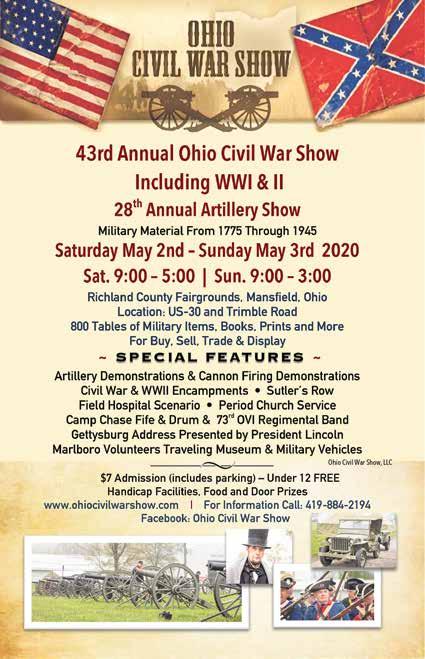
The 44th Annual Ohio Civil War & WWI/II Show will be held in Mansfield, OH, at the Richland County Fairgrounds. All federal, state and local firearm ordinances and laws must be obeyed. Civil War and WWI & II Memorabilia for buy, well & trade. Featuring a unique artillery show with 15 cannon on display with firing demonstrations. Added Special Features: Civil War & WWII encampments, Sutlers Row, field hospital scenario, period music, Gettysburg Address by President Lincoln, Marlboro Volunteers Traveling Museum and Military Vehicle. Hours are 9 a.m. to 5 p.m. on Sat., 9 a.m. to 3 p.m. on Sun. Parking is free. For information; contact Wayne Williams: 419-884-2194 or t.drushel@zoominternet.net. Visit our website at www.ohiocivilwarshow.com.
May 12–14, Tennessee. 21st Congress of the General Barton & Stovall Association
Drury Plaza Hotel, 1874 W. McEwen Drive, Franklin, TN 37067
Since 2001, our association has held yearly Congresses across the Southeast. Each Congress is held in a different location near where our soldiers once fought and bivouacked. There are three nights of activities and two days of tours. Friday we will be visiting by charter bus Elm Springs, St. John’s Church and positions around Columbia, with lunch at Puckett’s Grocery. Afternoon tour of the Battle of Franklin. Saturday we will visit Mount Olivet Cemetery and Fort Negley, lunch at Historic Travellers Rest, with an afternoon tour of Battle of Nashville sites. Saturday night banquet speaker is John Banks of the History Channel. Member Cost: $200, non-member $215. Pay before Feb. 1st to avoid late registration fees. May 12th: 7 to 9 p.m. May 13th: 8:30 a.m. to 5 p.m., May 14th: 8:30 a.m. to 9 p.m. For information; Cliff Roberts, cliff874@gmail.com, 770-656-5585, www.generalbartonandstovall.com.
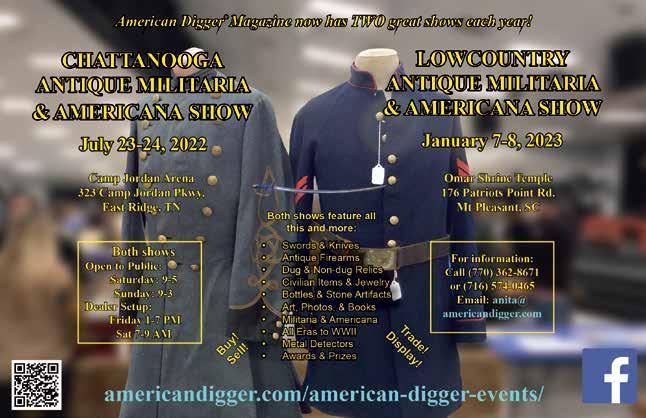
May 14-15, New York. Annual Artillery School
Sponsored by the National Civil War Artillery Association and Reynolds’ Battery L., the 34th Annual Artillery School at Old Fort Niagara State Park in Youngstown will again take place in 2022. Fort Niagara is the oldest continuously occupied military site in North America. Open to all branches of service, both Federal and Confederate. Registration
45 March 2022 45 March 2022 CivilWarNews.com CivilWarNews.com
Before making plans to attend any event contact the event host.
fee is $7. Registration Forms and additional info can be found at: www.reynoldsbattery.org. For information, 585208-1839 or contact Rick Lake at rlake413@aol.com.
May 18-22, Virginia. Period Firearms Competition
The North-South Skirmish Association 145th National Competition near Winchester. Over 3,000 uniformed competitors in 200 member units compete in live-fire matches with muskets, carbines, revolvers, mortars and cannon plus costume competitions and historical lectures. The largest Civil War live-fire event in the country. Free admission, large sutler area, and food service. For more information visit the N-SSA web site: www.n-ssa.org.
May 20-22, Georgia. Reenactment and Living History
The Battle of Resaca Reenactment will be held on over 600 acres of the original battlefield in Resaca, Georgia. This reenactor-friendly event will have main camps located near the original US and CS lines. Campaigners are welcome to camp in or near the breastworks. Amenities include straw, hay and firewood. Modern food and ice vendors on site. Weekend activities will include aggressive battles both days at 2 p.m. – rain or shine, combined US & CS morning colors, period demonstrations, cavalry competition, a civilian refugee camp, reenactor yard sale, sutlers, period music and dance, period church services, and a memorial service at the Confederate Cemetery
Many Civil War historical sites are located on the reenactment site and two major Civil War parks are within minutes of the site. Handicapped parking available with free transport from parking areas to battlefield, vendor and sutler areas. Reenactor pre-registration is $10 if received by April 15th. Artillery bounties of $150 for the first 18 cannons with crew pre-registered by April 15, 2022. A portion of the proceeds to be donated to preservation efforts of the Friends of Resaca Battlefield. For more information; www.georgiadivision.org.
May 29, Pennsylvania. Memorial Day Observed at Laurel Hill Cemetery
Original G.A.R. Decoration Day Service of 1868. 3822 Ridge Ave. Philadelphia 12 noon. All are welcome. Laurel Hill is the site of the first Memorial Day in Philadelphia in 1868. Special veterans’ markers will be dedicated at the graves of previously unmarked veterans. Speakers, ceremonies, and pageant will highlight the ceremony. Wreathlaying, speeches, music, and honor guards. Historical groups, veterans, and citizens are urged to participate. Wreaths, military contingents, color guards, music and period civilians are encouraged to participate. Refreshments served after the ceremony. For information; 215-228-2800.
June 4-5, Virginia. Reenactment: The Action at Wilson’s Wharf

Located between Richmond and Williamsburg on the James River, scenic Fort Pocahontas is the site of the May 24, 1864, action in which United States Colored Troops defended the fort they built against an assault by Fitzhugh Lee’s Confederate Cavalry. Open to the public 10-4 Sat. and 10-3 Sunday: $10/adults, $8/students; battle reenactments both days. See Civil War camps and enjoy history brought to life through family-friendly activities. For reenactors: preregistration required starting Jan. 10 at www.fortpocahontas.org; shaded campsites; Friday officers’ social; Saturday dinner and dance.
June 11-12, Mississippi. Civil War Show
Civil War Relic Show will be held at Brandon City Hall, located at 1000 Municipal Drive, Brandon, Mississippi. 300 tables of relics, weapons, prints, documents, artillery, WWI & WWII, bottles, books, currency, living history displays, and more. Admission $7, 12 and under are free. Saturday, 9 a.m. to 5 p.m., Sunday, 9 a.m. to 3 p.m. Contact Tim Cupit at TimCupit@comcast.net or call 769-234-2966. Website is www.scv365.com.
June 25-26, Pennsylvania. Annual Gettysburg Civil War Artifact Show

The nation’s premier Civil War relic and collectors show at the Eisenhower All Star Complex at 2634 Emmitsburg Rd., Gettysburg. Brendan Synnamon, GBPA Vice President of Administration and the event’s coordinator, is working closely with the Eisenhower Complex to ensure the event follows PA Guidelines for COVID 19 control. Our 300+ tables are a great way to view and even purchase authentic Civil War artifacts. Browse the tables and speak with the vendors who are all well versed in history and artifact identification. Better than a museum! Every item has someone willing to give you its history lesson and answer all your questions. $100 VIP Charitable donation includes Friday and early admission for the serious collector. Hours: Sat. 10-5, Sun. 9-2. Admission $10, children under 12 free. For more information visit https://www.gbpa.org/event/annual-civil-war-relic-show.
Aug. 5-7, Virginia. Reenactment
160th anniversary reenactment of the Battle of Cedar Mountain in Culpeper, “Slaughter on the Mountain,” reenactors welcome! Join a reenactment of the first battle of the Second Manassas campaign on the actual battlefield. Recreations of battle actions on Saturday and Sunday Aug. 6-7. Event limited to 1,500 troops (artillery, cavalry, and civilians by invitation only). Public talks & demonstrations both days. Sutlers and food vendors will participate. For information; friendsofcedarmountain.org.
Aug. 13-14, Georgia. Civil War Show and Sale
44th Annual Southeastern Civil War & Antique Gun Show in Marietta at the Cobb County Civic Center hosted by the North Georgia Relic Hunters Association. Cobb County Civic Center, 548 South Marietta Pkwy SE, Marietta, GA 30060. Hours Sat. 9 a.m. to 5 p.m., Sun. 9 a.m. to 3 p.m. Admission $6, veterans and children under 10 are free. Show chairman: Ray McMahan at terryraymac@hotmail.com. For more info visit www.ngrha.com.
Sept. 24, Illinois. Civil War & Military Extravaganza
Zurko Promotions presents The National Civil War Collectors Fall Show and Sale which will be held at the DuPage County Fairgrounds, 2015 W. Manchester, Wheaton, Ill. Hours: 9 a.m. to 4 p.m. Admission is $10, Early Admission $25. Free parking. For more information visit www.chicagocivilwarshow.com or call Zurko Promotions at 715-5269769.
Oct. 1, Pennsylvania. Honor Ceremony
Major Octavius V. Catto Honor ceremony; wreath laying; military salute at the Catto Monument at city hall in Philadelphia at 11 a.m. honoring the great black equal rights and military leader. Wreath-Laying ceremony. All military units, period civilians, veterans and heritage groups are welcome. Colors, wreaths and music encouraged. Following the city hall ceremony, PA National Guard Medal Ceremony at 12:30 p.m. in the Union League for the

‘Major Catto Medal.’ For info: Dr. Andy Waskie awaski01@gmail.com.
Oct. 7-9, Virginia. Period Firearms Competition
The North-South Skirmish Association 146th National Competition near Winchester. Over 3,000 uniformed competitors in 200 member units compete in live-fire matches with muskets, carbines, revolvers, mortars and cannon plus costume competitions and historical lectures. The largest Civil War livefire event in the country. Free admission, large sutler area, and food service. For more information visit the N-SSA web site: www.n-ssa.org.
Nov. 12, Virginia. Civil War Show
Bullet and Shell is proud to present the 41st Central Virginia Military Antique Show (formally Mike Kent’s Capital of the Confederacy Civil War Show). In conjunction with the Central Virginia Civil War Collectors Association, we plan to continue to do everything to make this one of the best shows in the country. The show will host vendors and displays of American military history from the Revolutionary War through WWII. Bring your relics for appraisal or to sell. Over 300 tables! There will be many historical items to add to your collection. Show hours are 9-5 on Saturday, vendor setup on Friday. Parking is free and admission is only $10/adults with children under 12 free. For more information or registration go to www.MilitaryAntiqueShow.com.
Nov. 19, Pennsylvania. Remembrance Day in Gettysburg
General Meade & his Generals and the veterans of the Battle of Gettysburg Honor/Dedication ceremonies during the Remembrance Day Observance. Honoring all commanders and veterans of the Battle. Meet at the General Meade Equestrian Monument at 10 a.m. For information; Jerry McCormick at 215-848-7753 or gedwinmc@msn.com.
Dec. 3-4, Tennessee. Civil War Show and Sale


MK Shows presents the 35th annual Middle Tennessee Civil War Show and Sale at the Williamson County Ag Expo Park, 4215 Long Lane in Franklin. The nation’s largest Civil War show, featuring 750 tables of antique weapons, artifacts and memorabilia from top dealers and collectors around the country and encompassing all eras of military history from the Revolutionary War through World War II. Appraisers are always on hand to help you identify and value your military collectibles at no cost. Hours are 9-5 on Sat., 9-3 on Sun. Free Parking. Admission is only $10/adults and children under 12 are free. For information; www.MKShows.com or Mike@MKShows.com.
770-630-7296

Admission Coupon


Event

Mike@MKShows.com • www.MKShows.com

The American Civil War was the rst war in which both sides widely used entrenchments, repeating ri es, ironclad warships, and telegraphed communications. It was also the rst American War to be extensively photographed. Mathew Brady, Alexander Gardner and Timothy O’Sullivan are famous for having made iconic photographs in the Civil War’s eastern theater. George N. Barnard deserves to be ranked in this top tier for his photographic work in the war’s western theater. A civilian photographer hired by Gen. William T. Sherman’s chief engineer to take pictures of forti cations around Atlanta, Barnard took several hundred of them in and around the city in the fall of 1864. His most famous is the site of Union Maj. Gen. James B. McPherson’s death in the battle of Atlanta, July 22, 1864. Thus far, no comprehensive, de nitive listing has been made of the photographer’s work. For this book we have chosen a hundred images we deem “signi cant.”

128 page Paperb ac k: $19.95 (+$3.50 S & H)

46 CivilWarNews.com March 2022 46 March 2022 CivilWarNews.com
To Any MKShows
$1 Off
“The best little book on Barnard”
Ordering info: $19.95 plus $3.50 s&h South Carolina residents add 9% sales tax Mail a check to: Historical Publications LLC 520 Folly Road, Suite 25 PMB 379 Charleston, SC 29412 or Order online at www.historicalpubs.com Wrecking Atlanta series the 1880s. When the men the Missouri Engineers (oneofPoe’s thecaption,“theFirstMissouriEngineersdestroyingarailroadshowingtheuseofhooks for Monday, November Freedpeople on the Boxcars thesharpskirmishinginfrontofit.Federaltroops,however,neverassaultedtheConfederate Peachtree Battery–Another View
1 year USA Print & Digital
- 2 year USA Print
- 2 year USA Print & Digital
Terms and Conditions
The following terms and conditions shall be incorporated by reference into all placement and order for placement of any advertisements in Civil War News by Advertiser and any Agency acting on Advertiser’s behalf. By submitting an order for placement of an advertisement and/or by placing an advertisement, Advertiser and Agency, and each of them, agree to be bound by all of the following terms and conditions:
1. All advertisements and articles are subject to acceptance by Publisher who has the right to refuse any ad submitted for any reason. Mailed articles and photos will not be returned.
2. The advertiser and/or their agency warrant that they have permission and rights to anything contained within the advertisement as to copyrights, trademarks or registrations. Any infringement will be the responsibility of the advertiser or their agency and the advertiser will hold harmless the Publisher for any claims or damages from publishing their advertisement. This includes all attorney fees and judgments.
3. The Publisher will not be held responsible for incorrect placement of the advertisement and will not be responsible for any loss of income or potential profit lost.
4. All orders to place advertisements in the publication are subject to the rate card charges, space units and specifications then in effect, all of which are subject to change and shall be made a part of these terms and conditions.
5. Photographs or images sent for publication must be high resolution, unedited and full size. Phone photographs are discouraged. Do not send paper print photos for articles.
6. At the discretion of Civil War News any and all articles will be edited for accuracy, clarity, grammar and punctuation per our style guide.
7. Articles can be emailed as a Word Doc attachment or emailed in the body of the message. Microsoft Word format is preferred. Email articles and photographs: mail@civilwarnews.com
8. Please Note: Articles and photographs mailed to Civil War News will not be returned
a return envelope with postage is included.
47 March 2022 47 March 2022 CivilWarNews.com CivilWarNews.com Advertisers In This Issue: 100 Significant Civil War Photographs: Atlanta 46 100 Significant Civil War Photographs: Charleston 25 American Battlefield Trust 34 Ace Pyro LLC 34 Artilleryman Magazine 38 B.M. Green Civil War Paper Memorabilia, Inc. 2 C.S. Acquisitions – Wallace Markert 7 CS Arms – Cliff Sophia 2 CWMedals.com, Civil War Recreations 8 Civil War Artillery Projectiles: Half Shell Book 28 Civil War Navy Magazine 33 College Hill Arsenal – Tim Prince 15 Dell’s Leather Works 5 Dixie Gun Works Inc. 28 Georgia’s Confederate Monuments – Book 16 Gettysburg Foundation 18 Greg Ton Currency 9 Gunsight Antiques 13 Harpers Ferry Civil War Guns 19 The Horse Soldier 8 James Country Mercantile 11 Jeweler’s Daughter 13 Le Juneau Gallery 5 Mike McCarley – Wanted Fort Fisher Artifacts 26 National Museum of Civil War Medicine 13 N-SSA 21 Panther Lodges – Tents, etc. 18 The Regimental Quartermaster 9 Richard LaPosta Civil War Books 41 Suppliers to the Confederacy – Book, Craig Barry 10 Ulysses S. Grant impersonator – Curt Fields 25 Mercer Press 22 Events: American Digger Events 45 Central Virginia Military Antique Show 35 Civil War Symposium - Western Theater 9 Gen. Barton & Stoval Reunion Congress 28 Lincoln Funeral Train 38 McCormick Civil War Institute Spring Conference 9 MKShows, Mike Kent 3, 25 Ohio Civil War Show 45 Poulin’s Auctions 48 South Carolina Confederate Relic Room and –Military Museum 15
unless
c c c c c c Charge my: Discover MasterCard Visa NAME ADDRESS ADDRESS CITY STATE ZIP CODE EMAIL $41
year USA Print $51
$71
$91
$29.95
Payment Enclosed Check # Card # Exp. Date Security Code Name on Card New Renewal c Make checks payable to Historical Publications LLC. c c c c Civil War News – 12 Issues Per Year Subscription/Renewal Form (required for digital subscription) USA Subscriptions Only No Canada or International Mail to: Historical Publications LLC 520 Folly Road, Suite 25-379, Charleston, SC 29412 Civil War News is now in a secure polybag with plain cover sheet for privacy. Subscribe online CivilWarNews.com PHONE Required 800-777-1862 Trivia Answers 1. Vallendingham 2. Valley Campaign 3. Valverde 4. CSS Virginia 5. Strong Vincent 6. Vermont 7. Vicksburg, Miss. 8. Zebulon B. Vance 9. Vidette 10. Volley gun Publishers/Authors Send your book(s) for review to: Civil War News 520 Folly Road, Suite 25 PMB 379 Charleston, SC 29412
- 1
-
- 1 year Digital only



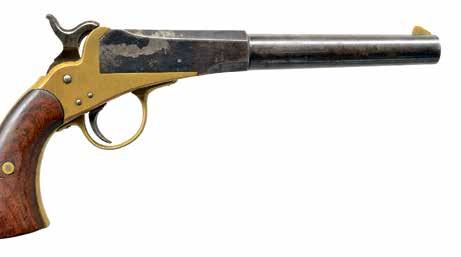
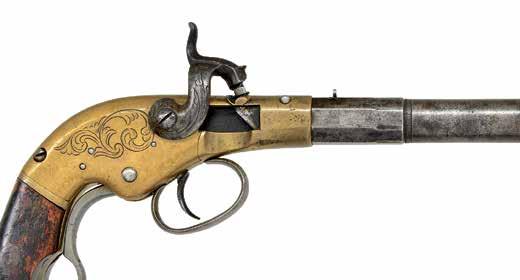
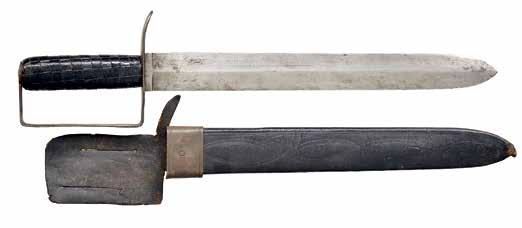



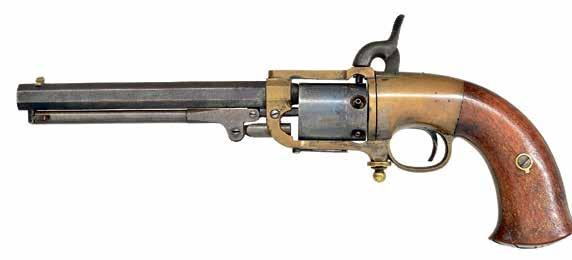

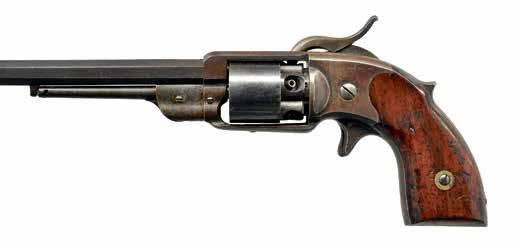



Three Scarce Civil War Lindsay Double-Hammer Firearms: Rare Marston Single Shot Breechloading Navy Pistol, Serial #2. civilwar@poulinauctions.com | poulinauctions.com | 199 Skowhegan Rd, Fairfield, ME 04937 | 207-453-2114 Stephen Poulin, ME Lic # 1115 Spring 2022 Premier Firearms & Militaria Auction May 6, 7, & 8, 2022 | Fairfield, ME Firearms & Militaria Auctioneers to view additional highlights for our Spring 2022 Premier Firearms & Militaria Auction Two Samples From A Large Grouping Of Fine Confederate Fighting Knives: Unusual Confederate D-Guard Bowie With Stacked Leather Grip And Tin-Mounted Sheath. Classic Confederate D-Guard Bowie. Please visit our channel: Poulin Auctions on YouTube.com for more! 0 Seller’s Commission On Expensive Items And Valuable Collections Or Better! % Below is a just portion of a fine collection of Civil War Army and Navy revolvers to be featured in our upcoming Spring 2022 Premier Firearms and Militaria Auction: civilwar@poulinauctions.com | poulinauctions.com | 199 Skowhegan Rd, Fairfield, ME 04937 | 207-453-2114 Stephen Poulin, ME Lic # 1115 info, please call us at (207) 453-2114, or email info@poulinauctions.com and become a consignor 0% Or Better! Seller’s Commission On Expensive Items And Valuable Collections Early Atlanta Made Spiller & Burr With “CS”, Serial Numbered Cylinder, And “SPILLER & BURR”. Rare KG&K Staff Officer Sword. Ultra Rare Confederate Polk Pattern Battle Flag Carried By The TN Infantry At The Battle Of Shiloh. War Era 13 Star Flag With “War Stripe”. Fine Confederate Bilharz Muzzleloading Carbine. Rare & Confederate 1st Model Morse Carbine.















































 By Lawrence E. Babits
By Lawrence E. Babits



















































































































































 by Joseph F. Wilson
by Joseph F. Wilson




























































 Reviewed by Joseph Truglio
Reviewed by Joseph Truglio











































































